ICESat-2 (Ice, Cloud and land Elevation Satellite-2) - eoPortal (original) (raw)
Last updated:Nov 1, 2024
EO
|
Lidars
|
Atmosphere
|
Cloud type, amount and cloud top temperature
|
Launched in September 2018, the Ice, Cloud and land Elevation Satellite-2 (ICESat-2) is a National Aeronautics and Space Administration (NASA) follow-up mission to ICESat. ICESat-2 measures ice-sheet topography and global vegetation, as well as cloud and atmospheric properties to aid our understanding of climate change’s effect on the Earth. The mission has a design life of three years, with a five year goal, and seven years of propellant onboard to sustain the satellite if it is to exceed its expected lifespan.
Quick facts
Overview
| Mission type | EO |
|---|---|
| Agency | NASA |
| Mission status | Operational (extended) |
| Launch date | 15 Sep 2018 |
| Measurement domain | Atmosphere, Land, Snow & Ice |
| Measurement category | Cloud type, amount and cloud top temperature, Cloud particle properties and profile, Aerosols, Vegetation, Landscape topography, Sea ice cover, edge and thickness, Ice sheet topography |
| Measurement detailed | Cloud optical depth, Cloud type, Aerosol Extinction / Backscatter (column/profile), Land surface topography, Sea-ice thickness, Above Ground Biomass (AGB), Ice sheet topography |
| Instruments | ATLAS |
| Instrument type | Lidars |
| CEOS EO Handbook | See ICESat-2 (Ice, Cloud and land Elevation Satellite-2) summary |

ICESat-2 (Image Credit: NASA)
Summary
Mission Capabilities
The Advanced Topographic Laser Altimeter System (ATLAS), for measuring elevation, is the only instrument onboard ICESat-2. ATLAS is designed to acquire high resolution measurements of Earth’s surface while also obtaining atmospheric backscatter from molecules, clouds, and aerosols. The overall objectives of ICESat-2 are to quantify the polar ice sheet mass balance to determine contributions to current and recent sea level changes and impacts on ocean circulation, determine the seasonal cycle and topographic character of ice sheet changes, estimate sea ice thickness to examine ice/ocean/atmosphere exchanges of energy, masss and moisture, and measure vegetation canopy height as a basis for estimating large-scale biomass and biomass change. ICESat-2 will provide high quality topographic measurements that allow estimates of ice sheet volume change, key measurements in determining the rate of climate change on Earth. ATLAS receives backscatter from thick clouds, aerosols and molecules in the atmosphere allowing it to measure atmospheric tenuous clouds and blowing snow to provide for atmospheric climate models. These atmospheric measurements are important in climate studies as they extend the data records begun by other Earth observation satellite lidars.
Performance Specifications
ATLAS has a swath width of 17 m, and is able to measure ice-sheet elevation changes to an accuracy of 4 mm per year. For land ice measurements, ATLAS can measure surface elevation changes as little as 0.25 m per year over areas of 100 km2, surface elevation changes with an accuracy of 0.4 m/year along 1 km track segments, and resolution of winter and summer ice-sheet elevation change to 0.1 m at 25 km x 25 km spatial scales. For sea ice measurements, ATLAS can measure monthly surface elevation changes with an uncertainty of 0.03 m along 25 km. ICESat-2 produces elevation measurements that enable the determination of global vegetation height to 3 m accuracy at 1 km spatial resolution in vegetated areas. The backscatter from clouds and aerosols from 14 km altitude to the surface is recorded in an atmospheric channel, which consists of 30m bins in a 14km long column with along track resolution of 280 m.
ICESat-2 is in a near-polar Low Earth Orbit (LEO) at an altitude of 496 km with an orbital inclination of 92° and repeat cycle of 91 days.
Space and Hardware Components
The ICESat-2 spacecraft was built by Northrop Grumman. It is powered by the LEOStar-3 spacecraft bus which also provides orbital control for ATLAS as well as propulsion, navigation, attitude control, thermal control, data storage and handling, and ground communication. The spacecraft has an onboard recorder that stores 580 Gbits/day and is able to downlink data through X-band at a rate of 220 Mbit/s. It has 4 solar panels which produce an average of 1320 Watts to power the spacecraft, with four 22 N thrusters and eight 4.5 N thrusters to maintain the satellite’s orbit, determined through a high-precision GPS receiver and laser ranging.
ICESat-2 (Ice, Cloud and land Elevation Satellite-2)
Spacecraft Launch Mission Status Sensor Complement Ground Segment Preparatory Campaigns References
ICESat-2 is a NASA follow-up mission to ICESat with the goal to continue measuring and monitoring the impacts of the changing environment. The ICESat-2 observatory contains a single instrument, an improved laser altimeter called ATLAS (Advanced Topographic Laser Altimeter System). ATLAS is designed to measure ice-sheet topography, sea ice freeboard as well as cloud and atmospheric properties and global vegetation. The requirements call for a 5-year operational mission with a goal of 7 years. 1) 2) 3) 4) 5) 6) 7)
Rational and discussion of mission goals: The mass balance of Earth's great ice sheets and their contributions to sea level are key issues in climate variability and change. The relationships between sea level and climate have been identified as critical subjects of study ib the IPCC (Intergovernmental Panel on Climate Change) assessments, the CCSP (Climate Change Science Program) strategy, and the U.S. IEOS (International Earth Observing System). Because much of the behavior of ice sheets is manifested in their shape, accurate observations of ice elevation changes are essential for understanding ice sheets' current and likely contributions to sea-level rise.
ICESat-2, with high altimetric fidelity, will provide high-quality topographic measurements that allow estimates of ice sheet volume change. High-accuracy altimetry will also prove valuable for making long-sought repeat estimates of sea ice freeboard and hence sea ice thickness change, which is used to estimate the flux of low-salinity ice out of the Arctic basin into the marginal seas. Altimetry is best (and perhaps only) technique for change studies, because sea ice areas and extends have been well observed from space since the 19070s and significant trends have been shown, but there is no such record for sea ice thickness.
As climate change proceeds, continuous measurements of both land-ice and sea-ice volume will be needed to observe trends, update assessments, and test climate models. The altimetric measurement made with the lidar instrument, along with a higher precision gravity measurement (such as GRACE-FO), would optimally characterize changes in ice sheet volume and mass and directly enhance understanding of the ice sheet contribution to sea-level rise. Coupled with the interferometric synthetic aperture radar in the DESDynI mission, the instrumentation would provide a comprehensive data set for predicting changes in Earth's ice sheets and sea ice.
In addition to studies of ice, the proposed instrument could be used to study changes in the large pool of carbon stored in terrestrial biomass. In particular, the proposed lidar could be used to measure canopy depth and thus estimate land carbon storage to aid in understanding the responses of biomass to changing climate and land management. 8) 9) 10)
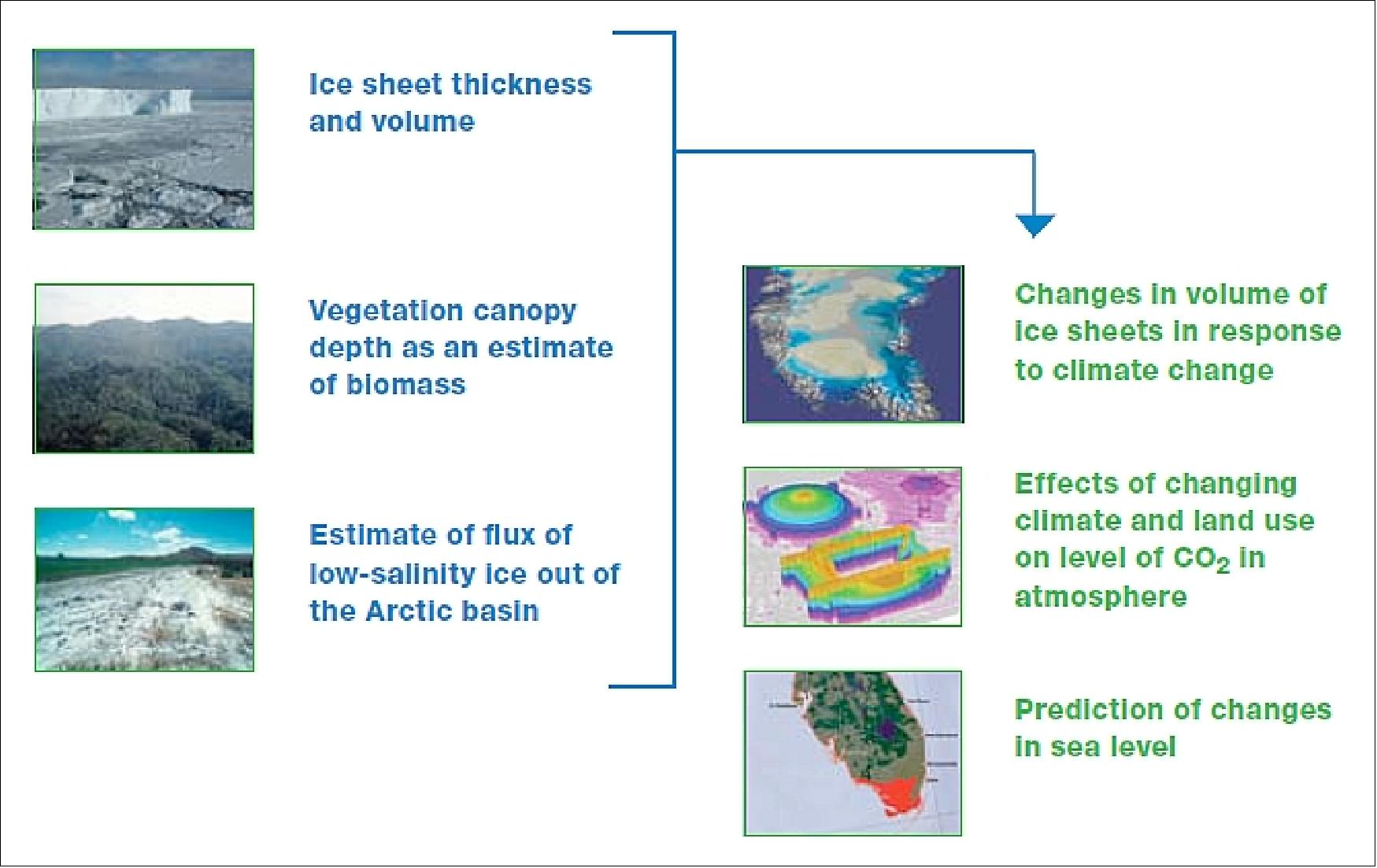
Figure 1: Schematic view of mission goals (image credit: NASA)
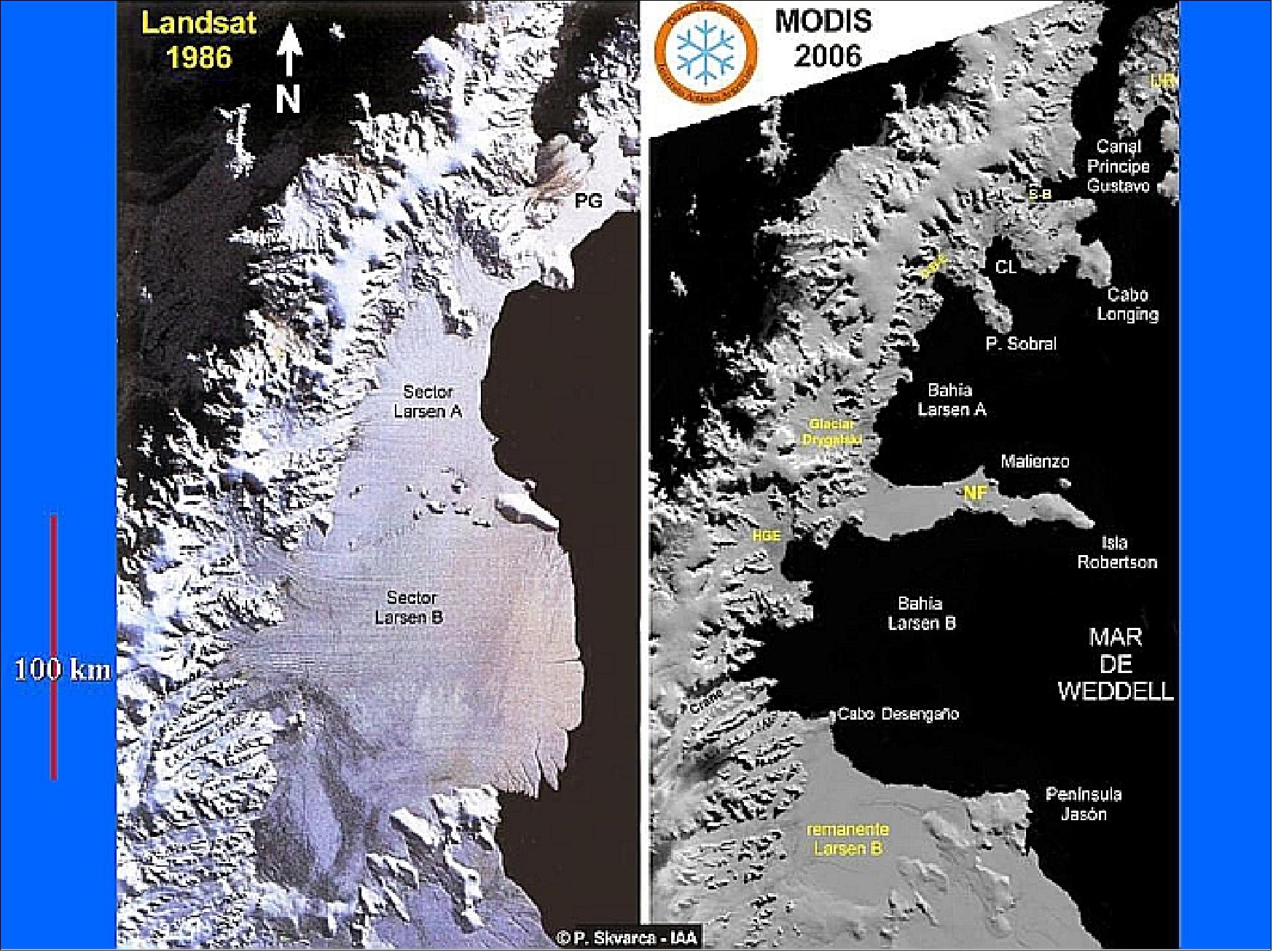
Figure 2: Changes in Greenland ice from 1986 to 2006 (image credit: NASA)
The overall science objectives are to: 11) 12)
• Quantify the polar ice sheet mass balance to determine contributions to current and recent sea level change and impacts on ocean circulation
• Determine the seasonal cycle of ice sheet changes
• Determine topographic character of ice sheet changes to assess mechanisms driving that change and constrain ice sheet models
• Estimate sea ice thickness to examine ice/ocean/atmosphere exchanges of energy, mass and moisture.
• Measuring vegetation canopy height as a basis for estimating large-scale biomass and biomass change
• Enhancing the utility of other Earth observation systems through supporting measurements.
The instrument will use micro-pulse multi-beam photon-counting approach. Science and ancillary data will be collected, stored on-board and subsequently downlinked to ground stations via an X-band communications link. This link will also include stored housekeeping telemetry. The observatory will also receive and store/execute commands and transmit real-time housekeeping telemetry via an S-band link to the NASA Ground Network.
Spacecraft
The ICESat-2 mission is assigned to NASA/GSFC. The spacecraft is being procured under the GSFC RSDO (Rapid Spacecraft Development Office). In August 2011, NASA selected Orbital ATK, former OSC (Orbital Science Corporation of Dullas, VA, to built the ICESat-2 spacecraft. The contractor is responsible for the design and fabrication of the ICESat-2 spacecraft bus, integration of the government-furnished instrument, satellite-level testing, on-orbit satellite check-out, and continuing on-orbit engineering support. The ICESat-2 spacecraft is being designed, assembled, and tested at Orbital's satellite manufacturing and test facility in Gilbert, Arizona.
ICESat-2 uses the LEOStar-3 platform (used for NASA's Landsat-8, the GeoEye-1 Earth imaging satellite) and is being built and integrated. at the Gilbert, AZ, location of Orbital ATK. 13) 14) 15)
Table 1: Overview of key spacecraft parameters
| Spacecraft bus | LEOStar-3 |
|---|---|
| Spacecraft launch mass, power | 1387 kg, 1.2 kW |
| Spacecraft stabilization | 3-axis, zero momentum bias, nadir pointing |
| Pointing control | 13.3 arcsec (3σ) |
| Orbit determination | High precision GPS receiver and Laser ranging |
| Onboard data storage capacity | 704 Gbit at EOL (End of Life) |
| Data downlink | X-band, data rate of 220 Mbit/s |
| Propulsion | Blowdown hydrazine, four 22 N thrusters and eight 4.5 N thrusters, 158 kg tank capacity |
| Mission design life | 3 years with a 5 year goal; 7 years of propellant available |
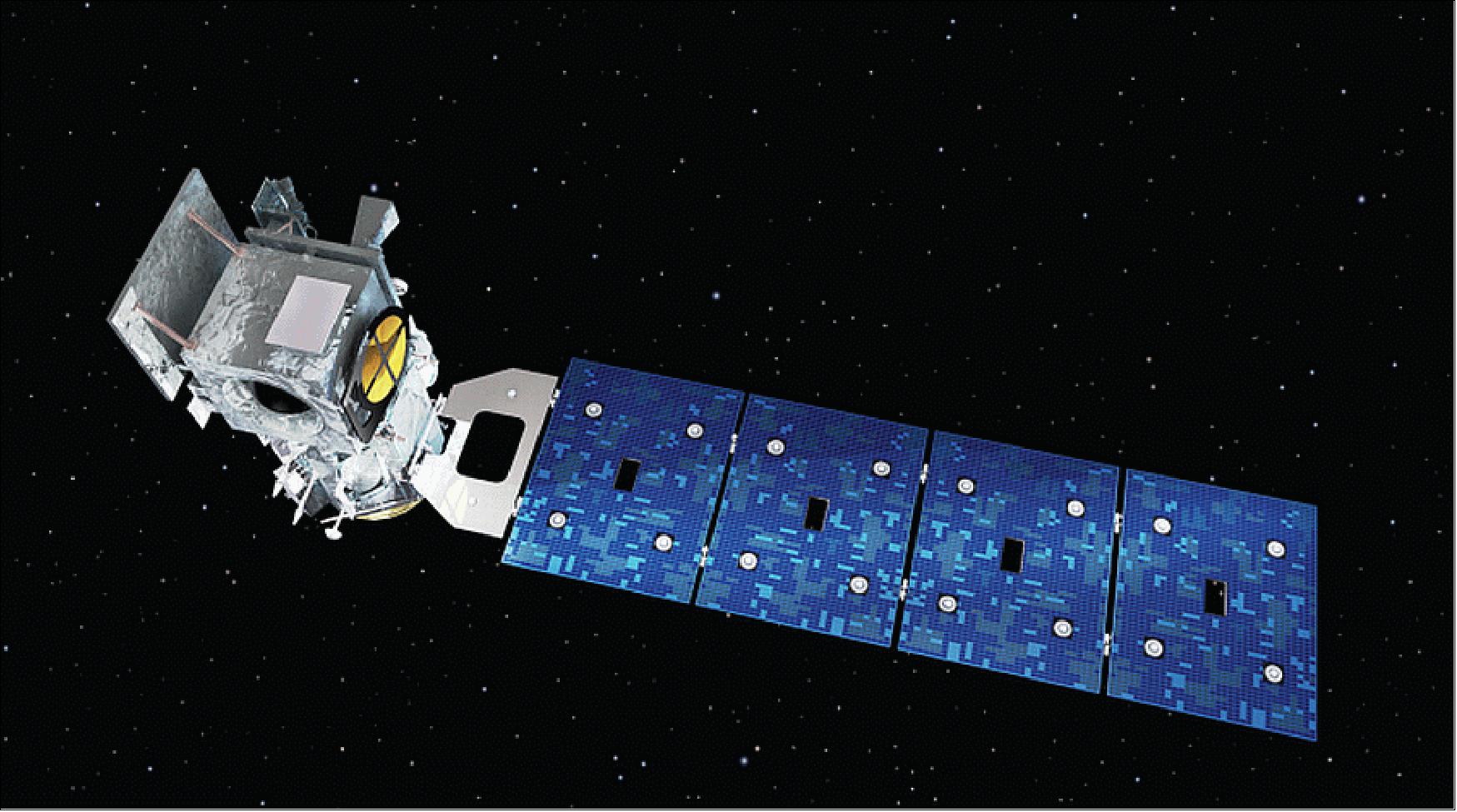
Figure 3: Artist's view of the ICESat-2 spacecraft (image credit: Orbital)
Project Development Status
• On 23 June 2018, ICESat-2 engineers at Vandenberg Air Force Base in California successfully finished the final ground-based test of the lasers, which are part of the satellite's sole instrument called the ATLAS (Advanced Topographic Laser Altimeter System). ICESat-2 is scheduled to launch from Vandenberg on Sept. 12, 2018. 16)
- ATLAS was built at NASA's Goddard Space Flight Center in Greenbelt, Maryland, and trucked to a Northrop Grumman facility in Arizona where it was integrated with the spacecraft bus that provides power, navigation and communications. The completed satellite arrived at Vandenberg on June 12.
Note: On June 6, 2018, Northrop Grumman Corporation announced it has closed the acquisition of Orbital ATK Inc. (“Orbital ATK”), a global leader in aerospace and defense technologies. Orbital ATK is now Northrop Grumman Innovation Systems, a new, fourth business sector. 17)
- In the Astrotech Space Operations cleanroom at Vandenberg, the ICESat-2 team tested both the spacecraft and instrument. NASA ICESat-2 launch integration manager John Satrom reports that the data from these tests have been reviewed and everything is normal.
- Meanwhile at Vandenberg's Space Launch Complex 2 along the Pacific coast, crews from United Launch Alliance are assembling the Delta II rocket that will launch ICESat-2 into space. The first and second stage, the interstage connecting them, and four solid rocket motors are in place. The ICESat-2 mission will mark the final launch for the Delta II, which will then be retired.
- After the successful completion of another round of “aliveness” tests turning on the satellite and instrument at the end of July, the ICESat-2 payload is scheduled to head to the launch pad in late August, according to Satrom.
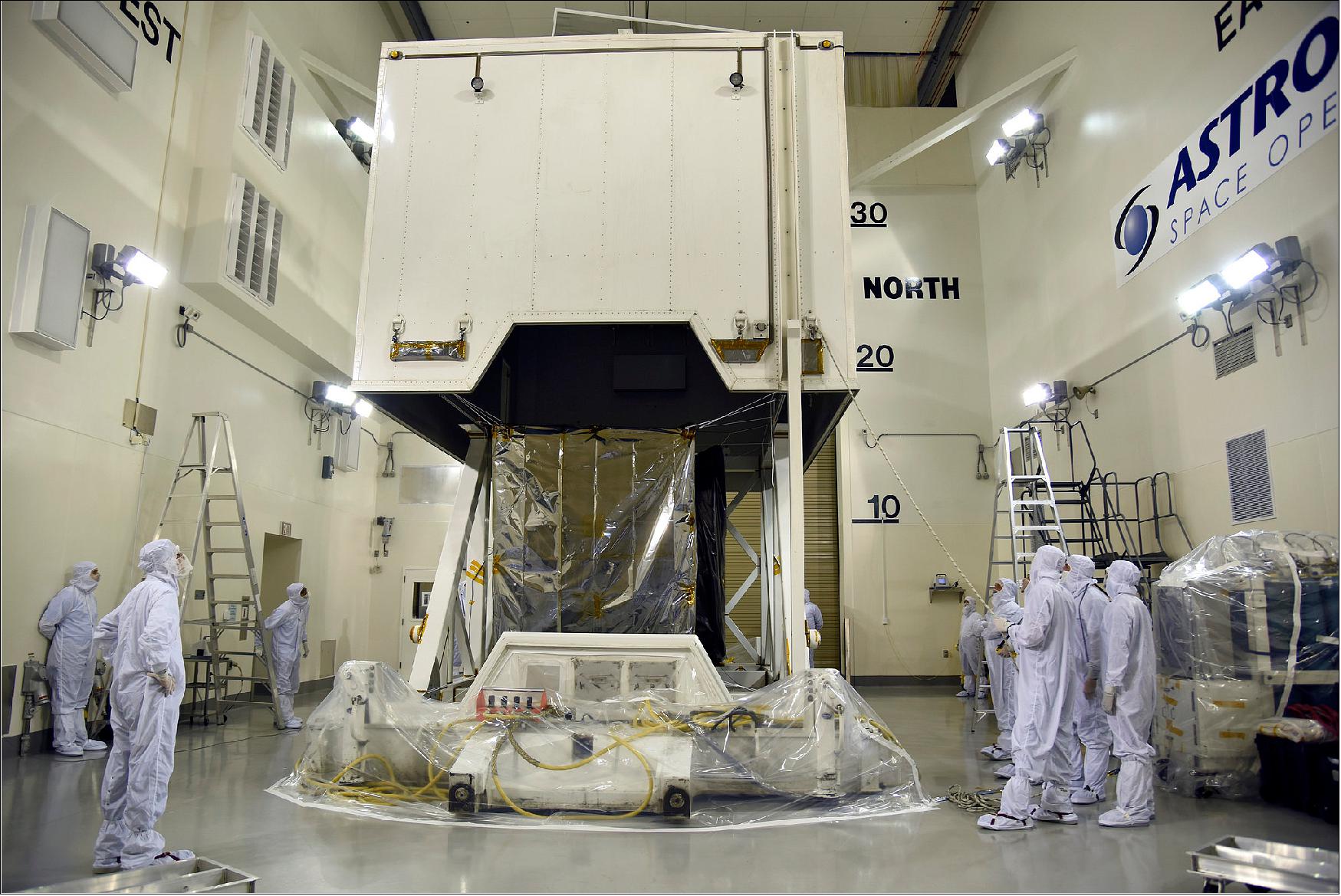
Figure 4: ICESat-2 is uncrated inside the airlock of the Astrotech processing facility at Vandenberg Air Force Base in California, prior to a successful series of tests of the satellite and its instrument (image credit: USAF 30th Space Wing/Vanessa Valentine)
• February 28, 2018: The ATLAS (Advanced Topographic Laser Altimeter System) instrument, which was designed, built and tested at NASA's Goddard Space Flight Center in Greenbelt, Maryland, arrived in Gilbert, Arizona, at Orbital ATK's facility on Feb. 23, where it will be joined with the spacecraft structure. To deliver the instrument safely to the spacecraft for assembly and testing, the ATLAS team developed special procedures for packing, transporting and monitoring the sensitive hardware. 18)
- "There was a lot of care and feeding that went with ATLAS along the road," said Kathy Strickler, ATLAS integration and test lead.
- The trip followed a successful series of tests, designed to ensure the ATLAS instrument will function in the harsh environment of space. After the instrument passed those tests, including some in a thermal vacuum chamber, engineers inspected ATLAS to make sure it was clean and in the correct travel configuration. Then, they attached probes to the instrument that would check for vibrations as well as temperature and humidity.
- "These probes tracked what ATLAS actually sensed when going over road bumps, and what ATLAS felt as far as temperature and humidity," said Jeffrey Twum, the ATLAS transport lead.
- The team then wrapped the instrument - about the size of a Smart Car - in two layers of anti-electrostatic discharge film, to prevent any shocks en route. With its protections in place, a crane lifted ATLAS into a transporter container. The team bolted it to a platform supported by a series of wire-rope coils used to soften the ride, and the cover of the transporter was fastened shut, sealing up the cargo.
- The 2,000-mile trip took four and a half days. The ATLAS instrument is now at Orbital ATK, where engineers will attach it to the spacecraft and conduct additional testing. Then, the complete satellite will be repacked and trucked to its last stop before low-Earth orbit: Vandenberg Air Force Base in California.
• August 16, 2017: Lasers that will fly on NASA’s ICESat-2, are about to be put to the test at the agency’s Goddard Space Flight Center in Greenbelt, Maryland. 19)
- The sole ICESat-2 instrument, ATLAS (Advanced Topographic Laser Altimeter System) will measure the elevation of ice sheets, sea ice and glaciers by sending fast-firing laser pulses to the surface and timing how long it takes individual photons to return. With a scheduled launch date of 2018, the instrument now faces several months of testing at Goddard in which engineers will ensure it is ready to operate in the harsh environment of space. This is an intermediate stage of ICESat-2’s testing regimen, and will focus on the flight lasers.
- Starting this fall, ATLAS will go into a test chamber at Goddard where engineers simulate the vacuum of space and can dial temperatures up to 50 C to - 30 C. Engineers will also turn on the two lasers — one primary and one backup — at different power levels to ensure they function correctly, said Anthony Martino, ATLAS instrument scientist at NASA Goddard. One test will include putting the instrument through its paces at different temperatures and taking pictures of the laser pulses to ensure they form a smooth, consistent circle, Martino said, with no rough edges, or dark or light spots.
- “When it’s well behaved like that, it’s much easier to analyze the results that we’ll get,” he said. Other tests involve using mirrors to reflect the laser back into the detector portions of the instrument — but only after decreasing the strength of the beam of light by 13 orders of magnitude (about 10 trillion times), to simulate the weakening of the laser beam as it is scattered by the atmosphere, bounces off Earth and returns.
• September 2016: ICESat-2 Technical Status Summary. 20)
Beyond the ATLAS instrument, all other ICESat‐2 systems are nearing completion including spacecraft, launch vehicle, algorithms, operations planning, and ground systems.
- The mission requirements remain intact through the ongoing flight Laser002 repair.
- The ATLAS management and engineering team has crafted and is implementing a conservative plan to address the recent Laser002 optical slab fracture.
ATLAS Instrument – Technical Issue with Laser002
• The ATLAS instrument completed integration and testing campaigns for EMI/EMC (Electromagnetic Interference/Electromagnetic Compatibility) and Vibration
• During Thermal Vacuum (TVac) testing, Laser002 (the second of two onboard flight lasers) exhibited a performance anomaly
- During one of several start-ups, the Laser002 pre-amplifier, amplifier, and SHG (Second Harmonic Generator) energy monitors dropped suddenly
- After the drop, the pre-amplifier, amplifier, and SHG energy levels increased, and started to oscillate
- Subsequent turn-ons of Laser002 (post-anomaly) energy monitors and ATLAS SPD (Start Pulse Detector) energy readings slowly varied, eventually stabilizing at lower than nominal values (~70 to 80% of nominal)
• Ongoing investigation and repair of Laser002
- The Thermal Vacuum testing was suspended and Laser002 was de-integrated from ATLAS and returned to the vendor, Fibertek
- Fibertek completed disassembly and initial inspection of Laser002 pre-amplifier assembly
- The crystal optical slab within the pre-amplifier assembly fractured towards the center at a point where thermal stress is low indicating proximate cause was mechanical stress from mount clamp assembly (~1cm from pump face)
- Observed uneven intermetallic growth on mount and clamp surface indicating poor contact between these surfaces
- Completed X-ray tomography of Laser002 pre-amplifier assembly and observed non-uniform intermetallic growth between slab and clamp/mount surfaces
- Ongoing review of mount re-work/re-design options with Fibertek.
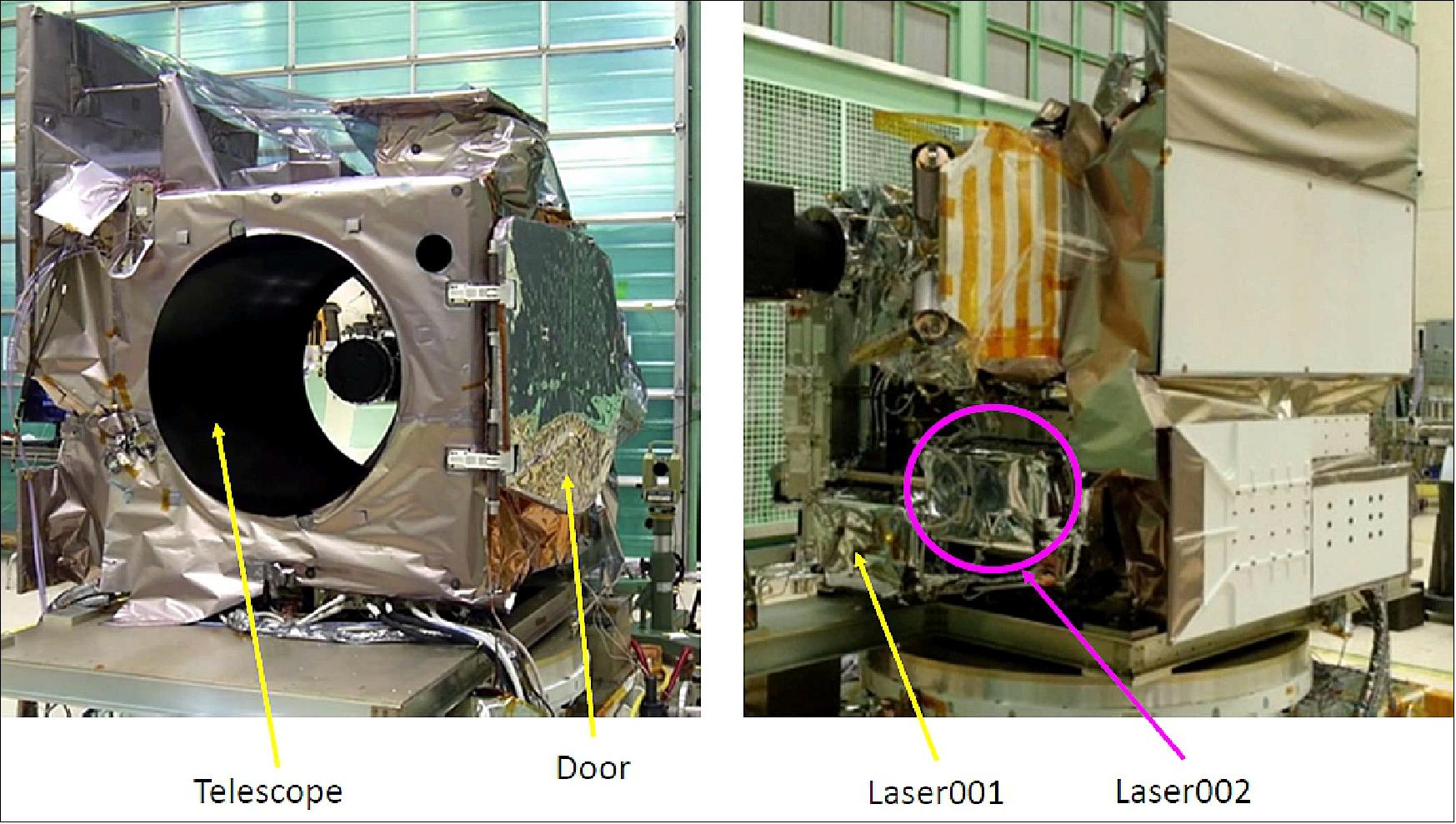
Figure 5: The integrated ATLAS instrument (image credit: NASA, Ref. 20)
• Feb. 18, 2016: ICESat-2 passed its Mission CDR (Critical Design Review)! Now, on to building and testing software and hardware for flight. 21)
• Jan. 17, 2016: ICESat-2 passed its Instrument Critical Design Review! The project is now moving full-speed ahead to Mission CDR and instrument I&T start.
• Dec. 10, 2015: NASA engineers tested the ATLAS instrument's pinpoint accuracy. ATLAS (Advanced Topographic Laser Altimeter System) will send laser pulses to the ground about 480 km below and then catch the handful of photons that bounce off the surface and return to its telescope mirror. There's very little margin for error when it comes to individual photons hitting on individual fiber optics - so this November, engineers conducted a series of tests on the ground, to ensure that they could hit that mark when ICESat-2 is in orbit. 22)
- This is the first time Goddard has built an automatically correcting and steering mechanism like this for flight. It was necessary for ATLAS, however, because both the receiver's field-of-view and the laser beam diameter are significantly smaller than on previous instruments, so there is less room for the laser to drift off-target. So the AMCS (Alignment Monitoring and Control System) team spent several weeks in November 2015 testing the steering mechanism and the software that controls it.
• February 2015: A NASA team tested part of the ATLAS instrument in a temperature-controlled vacuum chamber at Goddard, ensuring that its interconnected components worked together and functioned as expected. 23)
• November 3, 2014: Engineers at NASA/GSFC fitted the mirrored telescope of ICESat-2 into its place. In a Goddard cleanroom, teams are working in parallel on two sections of ATLAS: the box structure, which holds electronics that control the instrument, and the optical bench, which supports the instrument's lasers, mirrors, and the 0.8 m, 20.8 kg beryllium telescope that collects light. 24)
- Each ATLAS laser pulse contains more than 200 trillion photons, but only a dozen or so return to the telescope, where they're sent via optical fibers to the instrument's detectors. To catch those few photons, the telescope and its associated equipment, called the RTA (Receiver Telescope Assembly), need to align perfectly to the laser.

Figure 6: Engineers and technicians check the fit of ICESat-2's telescope to its sling, before moving it into place on the instrument's optical bench (image credit: NASA)
• Sept. 1, 2014: Due to cost overruns, the launch of ICESat-2 has slipped to June 2018. ICESat-2’s overrun was driven primarily by technical difficulties with the ATLAS (Advanced Topographic Laser Altimeter System) instrument. 25)
• May 2014: The box structure of the ATLAS instrument was delivered to a clean room at NASA/GSFC (Figure 66). A team of 250 engineers, fabricators and scientists has now started the official integration and testing stage of the laser instrument (Ref. 77).
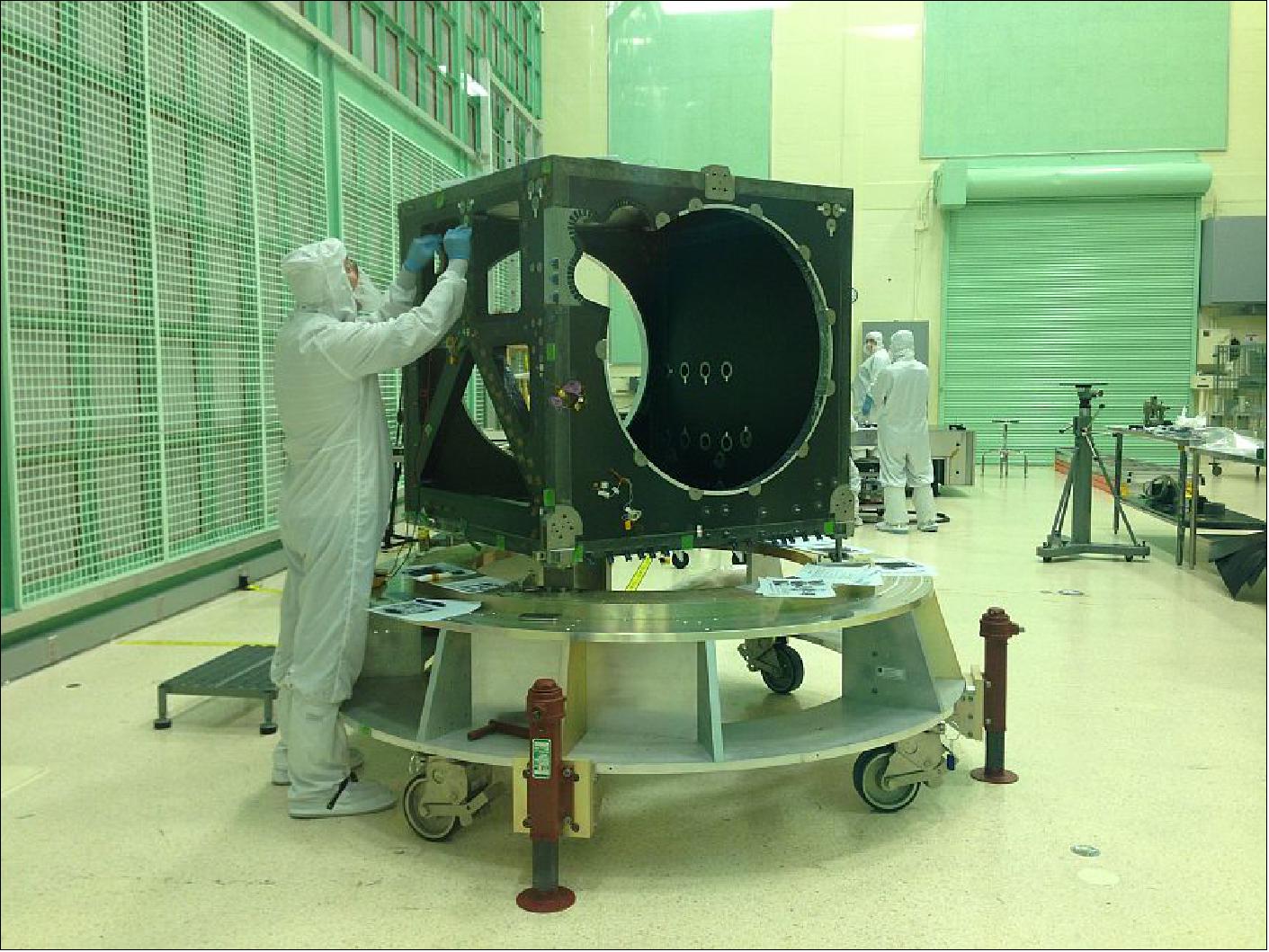
Figure 7: An engineer checks the ATLAS box structure, shortly after its arrival in a NASA clean room in May 2014 (image credit: NASA, Kate Ramsayer)
• February 18, 2014: ICESat-2 passed its Mission Critical Design Review! Now, on to building and testing software and hardware for flight.
• January 17, 2014: ICESat-2 passed its Instrument CDR (Critical Design Review)! The project is now moving full-speed ahead to Mission CDR and instrument I&T start.
• In December 2013, NASA notified Congress of expected budget increases ($200 million overrun) on the ICESat-2 mission. NASA is required by law to inform Congress when a mission appears likely to overrun its approved budget by more than 15%. This may cause possible launch delays. 26)
• Sept. 6, 2013: ICESat-2 passed its Ground Systems CDR (Critical Design Review). An independent review board met Sept. 3-5 , 2013at Goddard Space Flight Center in Greenbelt, MD, to examine details of the entire design of the mission's ground system, including the MOC (Mission Operations Center), the ISF (Instrument Support Facility), and the Science Investigator-led Processing System.
• The ICESat-2 mission was assigned Phase C status on December 17, 2012.
• The ICESat-2 project passed instrument PDR (Preliminary Design Review) on Nov. 18, 2011.
• The ICESat-2 team passed the SRR (System Requirements Review) on May 25, 2011.
• The ICESat-2 team passed the ISRE (Instrument System Requirements Review) on December 1, 2010.
• The ICESat-2 team passed the Key Decision Point A (KDP-A) review at HQ on December 11, 2009. Since then the project started officially in Phase A.
Launch
The ICESat-2 spacecraft was launched on 15 September 2018 (13:02 UTC) from VAFB, CA (Space Launch Complex -2W) on a Delta-II 7420-10 vehicle configuration. The launch service provider was ULA (United Launch Alliance). 27) 28) 29)
This marked the final launch of the Delta II rocket series. ULA's Delta II rocket has provided dependable access to space for the U.S. military, NASA and commercial clients for nearly 30 years, launching 154 times since its debut on Feb. 14, 1989. The lasting legacy of the Delta II extends from creating modern GPS navigation on Earth to roving the surface of Mars.
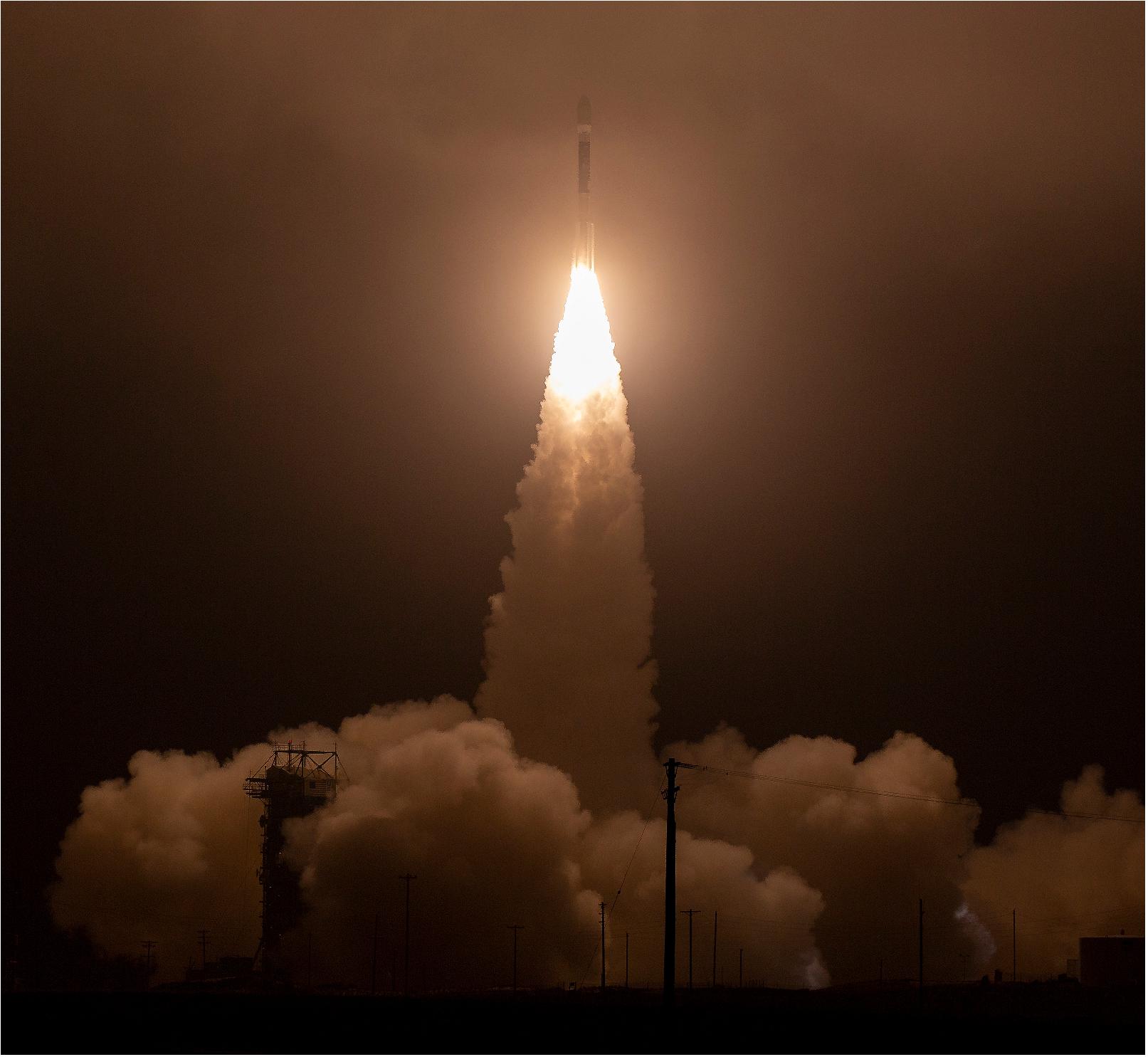
Figure 8: The ULA Delta-II rocket with NASA's ICESat-2 onboard is seen shortly after the mobile service tower at SLC-2 was rolled back on 15 September 2018, at Vandenberg Air Force Base in California (image credit: NASA)
Orbit: Near polar LEO frozen orbit, altitude =496 km, inclination = 92º, repeat cycle of 91 days with subcycles of 29, 29, and 33 days (Figure 9).
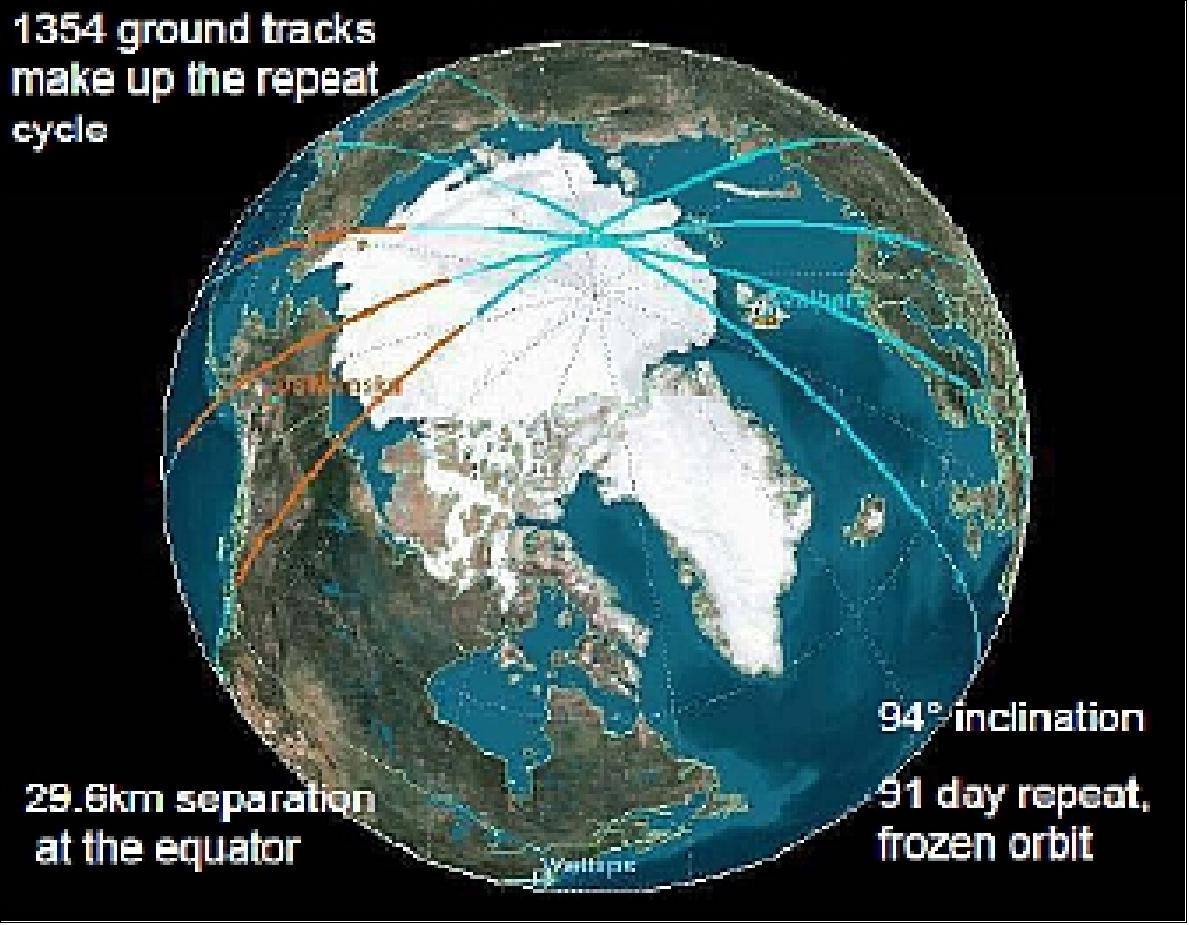
Figure 9: Illustration of monthly subcycles (image credit: NASA)
The Secondary Payloads on IceSat-2
In addition to ICESat-2, this mission includes four cubesats that will launch from dispensers mounted to the Delta II’s second stage.
• ELFIN (Electron Losses and Fields Investigation), a pair of 3U CubeSats of UCLA (University of California Los Angeles). 30)
• SurfSat (Surface charging Satellite), a 2U CubeSat mission developed at the UCF (University of Central Florida), Orlando, FL.
• CP-7 (CalPoly-7) or DAVE (Damping And Vibrations Experiment), a 1U CubeSat, a collaboration of Northrop Grumman Aerospace Systems and CalPoly.
Mission Status
• July 2, 2024: NASA's ICESat-2 satellite resumed its science operations on June 21 after a period of inactivity due to solar storms in May that caused its height-measuring instrument, the Advanced Topographic Laser Altimeter System (ATLAS), to enter a safe hold. These storms generated unexpected drag on the spacecraft, prompting an automated response to protect the instrument, which resulted in the satellite drifting 3.7 miles (6 kilometers) down from its intended orbit. The operations team successfully conducted thruster burns to reposition the satellite and reactivated ATLAS, which is now collecting precise data on Earth's ice, water, forests, and land cover. The ICESat-2 team continues to monitor the spacecraft, and the data collected is available to the public at www.nsidc.org, encompassing 5.5 years of measurements. 92)
• June 28, 2022: The ICESat-2 mission was approved for extended operation after successfully completing its three-year primary mission, gathering over 12 trillion precise laser measurements that have led to over 100 significant findings on Earth’s changing landscape. These insights include a one-third reduction in Arctic sea ice volume since 2003, newly discovered subglacial lakes beneath Antarctica, and evidence of human impacts on reservoir water levels. ICESat-2’s data extends from polar ice to tropical and urban environments, providing critical insights into environmental changes and earning a green light to continue its operations. 31)
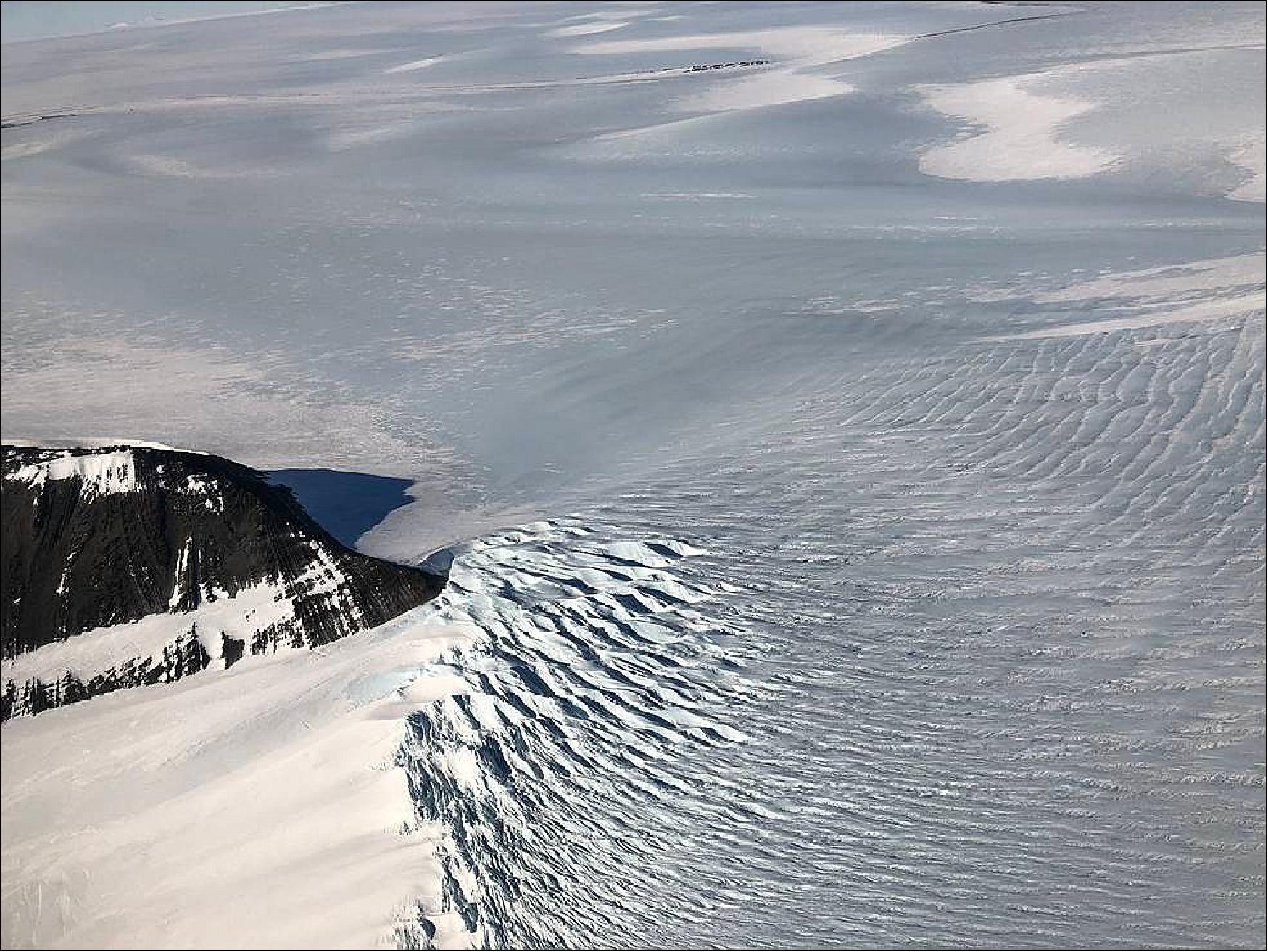
Figure 10: ICESat-2 measurements provide an incredible level of precision as it measures Earth's surface, including the Antarctic ice sheet seen here (image credit: NASA's Goddard Space Flight Center, Kate Ramsayer)
• February 10, 2022: NASA has awarded Northrop Grumman Systems Corporation a $33.3 million contract for continued operations of the ICESat-2 Mission, which monitors Earth's ice changes due to climate change. Effective from February 14, the four-year, nine-month contract covers mission operations, data processing, mission planning, anomaly resolution, and data delivery. Work will occur at Northrop Grumman’s Dulles, Virginia facility, while all ICESat-2 data remains accessible through NASA's National Snow and Ice Data Center. 32)
• July 7, 2021: NASA's ICESat-2 satellite has significantly advanced the understanding of subglacial lake systems beneath the Antarctic ice sheet, revealing the dynamic nature of these hidden lakes and their influence on ice movement and ocean circulation. This research has led to the discovery of two additional active subglacial lakes, enhancing insights into how freshwater from these lakes affects the ice sheet's stability and contributes to sea-level rise. The study highlights the intricate interactions between subglacial hydrology and climate dynamics, illustrating how the Antarctic ice sheet functions as part of a larger global water system. The precision measurements from ICESat-2 allow scientists to track changes in ice elevation and to understand the impact of these meltwater systems on the Southern Ocean, emphasising the importance of continued satellite monitoring to predict future changes in Antarctica due to climate change. 33)
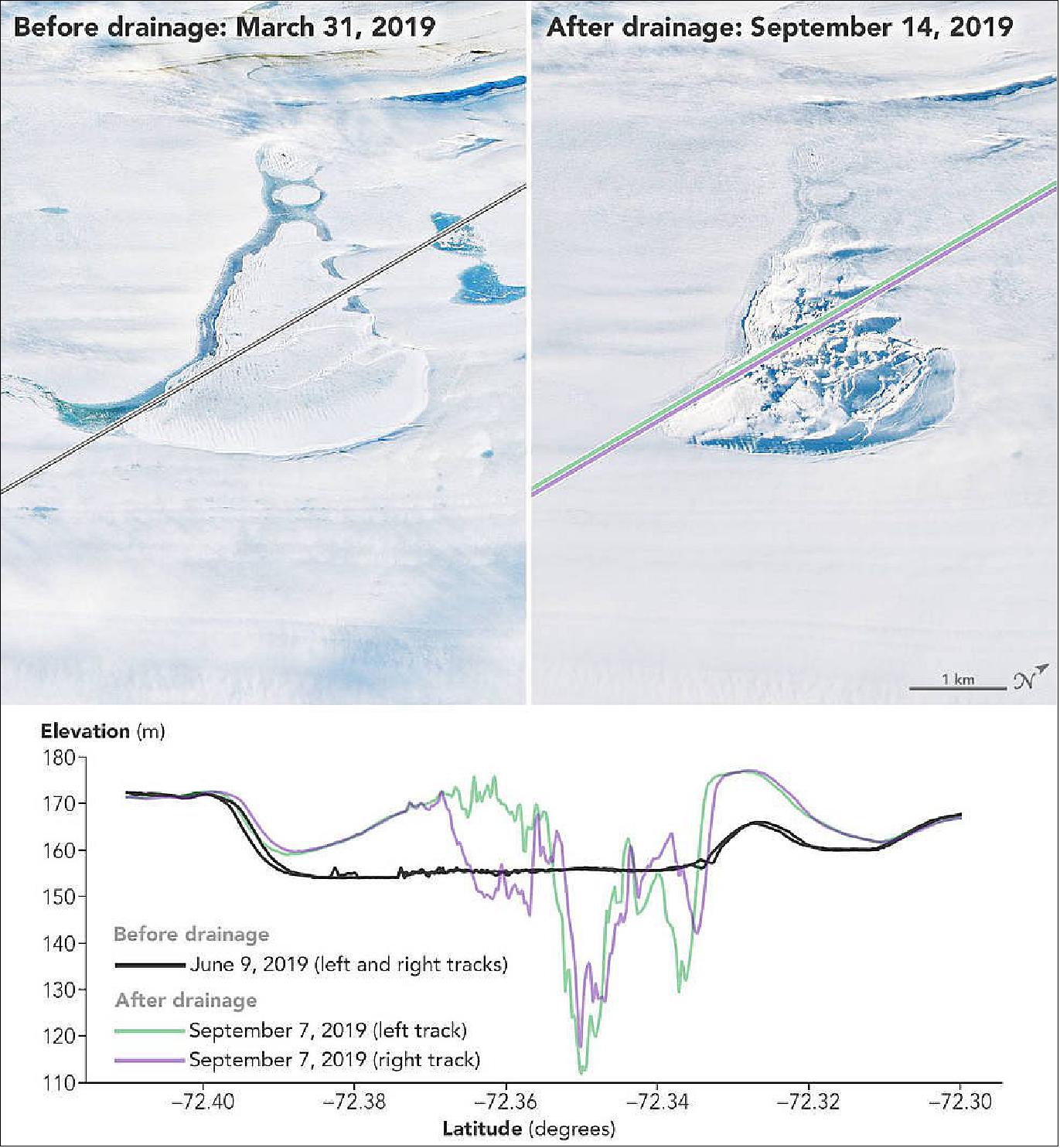
Figure 11: The height profile above was acquired by NASA’s Ice, Cloud, and land Elevation Satellite 2 (ICESat-2) using the Advanced Topographic Laser Altimeter System (ATLAS). The image shows the elevation data acquired by three different ATLAS laser beams as the satellite passed over an ice-covered lake that collapsed suddenly and abruptly on the surface of Antarctica’s Amery Ice Shelf in 2019 (image credit: NASA's Earth Observatory)
• June 3, 2021: Iceberg A-76, which calved from Antarctica’s Ronne Ice Shelf in May 2021, briefly held the title of the largest iceberg in the world, exemplifying a classic tabular shape characterishred by steep sides and a flat top. As shown in Figure 12, the iceberg's elevation profile was captured by NASA's ICESat-2 using its Advanced Topographic Laser Altimeter System (ATLAS), which measures surface height with laser pulses. This profile revealed the iceberg's jagged edges, created by the stresses of flowing ice at the ice shelf's shear margin, and illustrated that while the seaward edge had been eroded by melting seawater, the fresh interior edge stood about 35 meters (100 feet) above sea level, indicating a thickness of approximately 280 meters, much of which is submerged. Over time, the iceberg's shape continued to evolve due to the stresses it experienced, and by June 2021, it had broken into three smaller pieces, losing its status as the largest iceberg to A-23A, which had been adrift since 1986. 35)
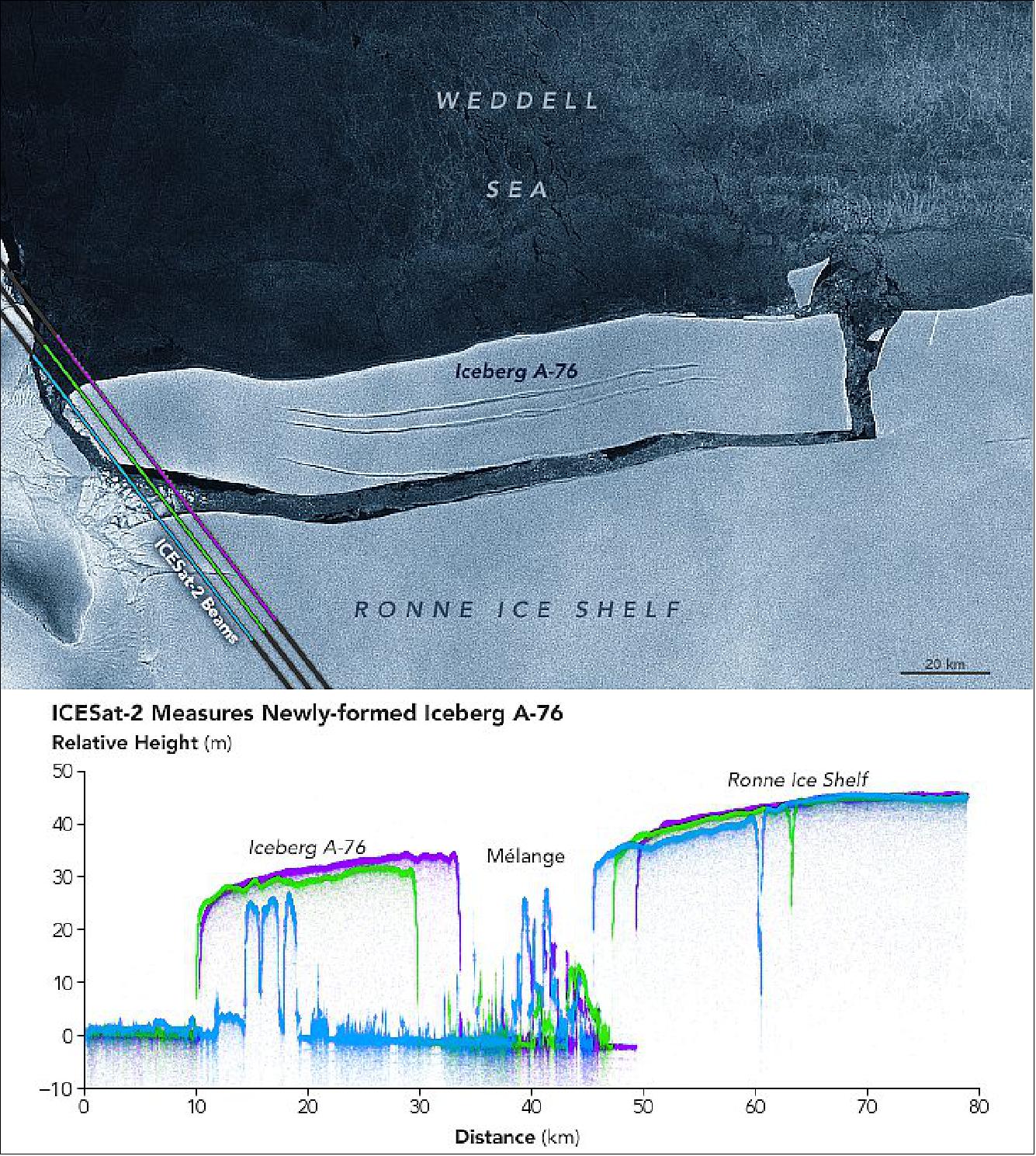
Figure 12: The topography of Antarctic iceberg A-76 provides insight into the strange properties of ice. The image shows the elevation data acquired by three different ATLAS laser beams as the satellite passed over the new iceberg on May 17, 2021. The data have been overlaid on an image of the iceberg acquired with the synthetic aperture radar (SAR) on the Copernicus Sentinel-1A satellite, operated by ESA. (image credit: NASA Earth Observatory image by Joshua Stevens, using ICESat-2 data from the National Snow & Ice Center with special thanks to Alvaro Ivanoff/ADNET Systems/NASA GSFC, and modified Copernicus Sentinel data (2021) processed by the European Space Agency.)
• April 30, 2021: Recent research led by NASA-funded scientists has demonstrated how freely available satellite data and cloud computing can improve the mapping of shallow waters around islands and coastal areas, which are crucial for human activities and marine health. Traditionally, marine surveyors relied on shipborne tools for bathymetric data, but advances in satellite technology have allowed researchers to derive bathymetric information from satellite images. By combining ICESat-2 measurements with images from Copernicus Sentinel-2, the team successfully mapped depths up to 26 meters around Biscayne Bay, the Gulf of Chania, and Bermuda at a resolution of 10 meters, significantly better than existing datasets. This open-source approach, utilizing tools like Google Earth Engine, offers a cost-effective solution for island nations and coastal states with limited resources, facilitating improved navigation, coastal infrastructure development, aquaculture placement, and habitat monitoring in rapidly changing environments. 36)
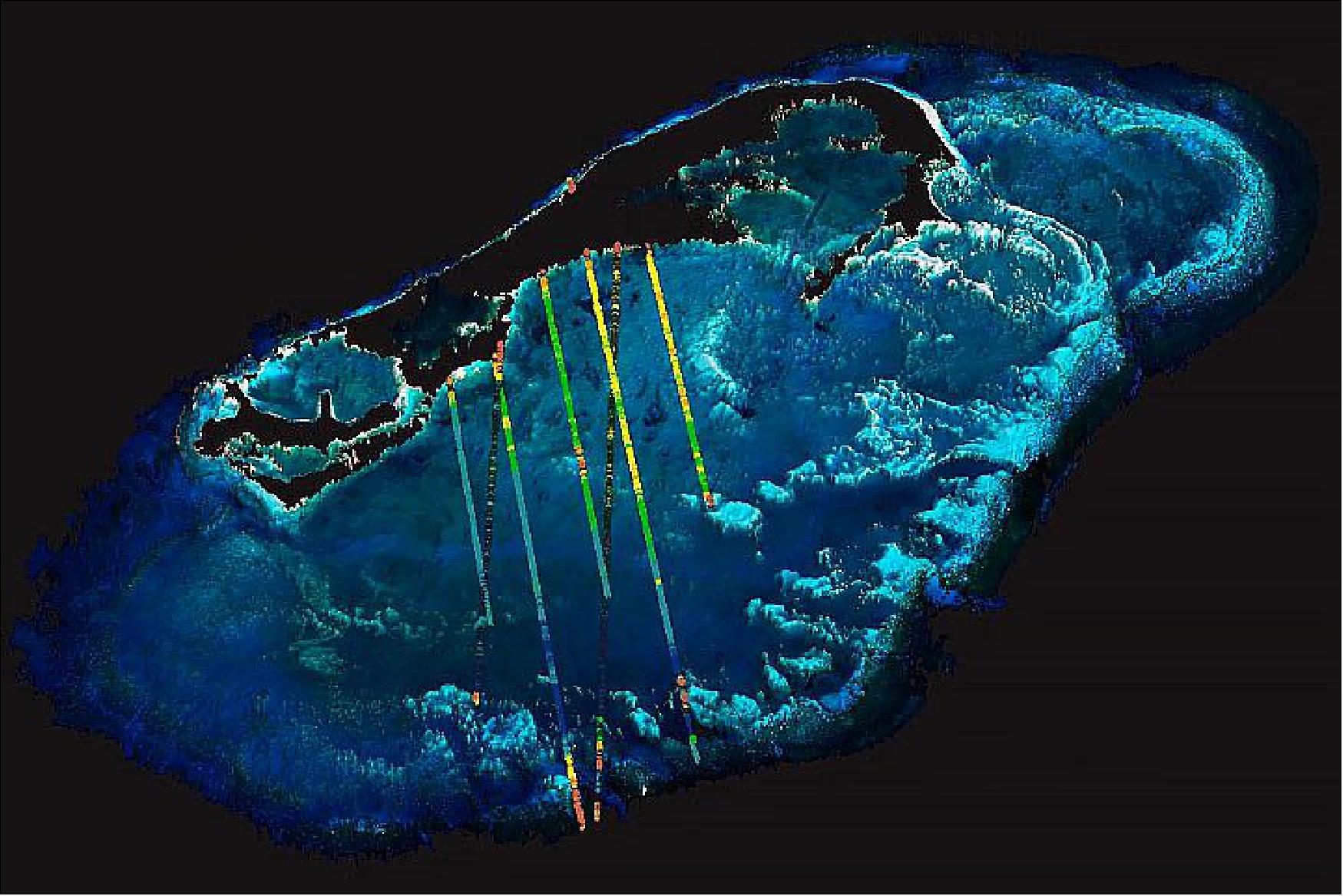
Figure 13: Remote sensing scientists have added a new tool for shallow seafloor mapping: the Advanced Topographic Laser Altimeter System (ATLAS) on NASA’s Ice, Cloud, and land Elevation Satellite 2 (ICESat-2). (image credit: NASA Earth Observatory)
• April 27, 2021: Researchers have developed a new method for measuring the depth and shape of isolated, ephemeral desert lakes using data from NASA's ICESat-2 satellite. Traditional mapping techniques often rely on boats and ships, which are impractical for remote or shallow lakes. By utilising ICESat-2's laser measurements, scientists can generate detailed bathymetric maps, enabling them to estimate water storage and understand how these lakes contribute to local ecosystems. This study focused on Lake Eyre in Australia, the world's largest shallow desert lake, which floods infrequently but supports diverse wildlife during those rare events. The findings will also aid in reconstructing past climates and improving water management in arid regions, connecting bathymetry with hydrological patterns. 38)
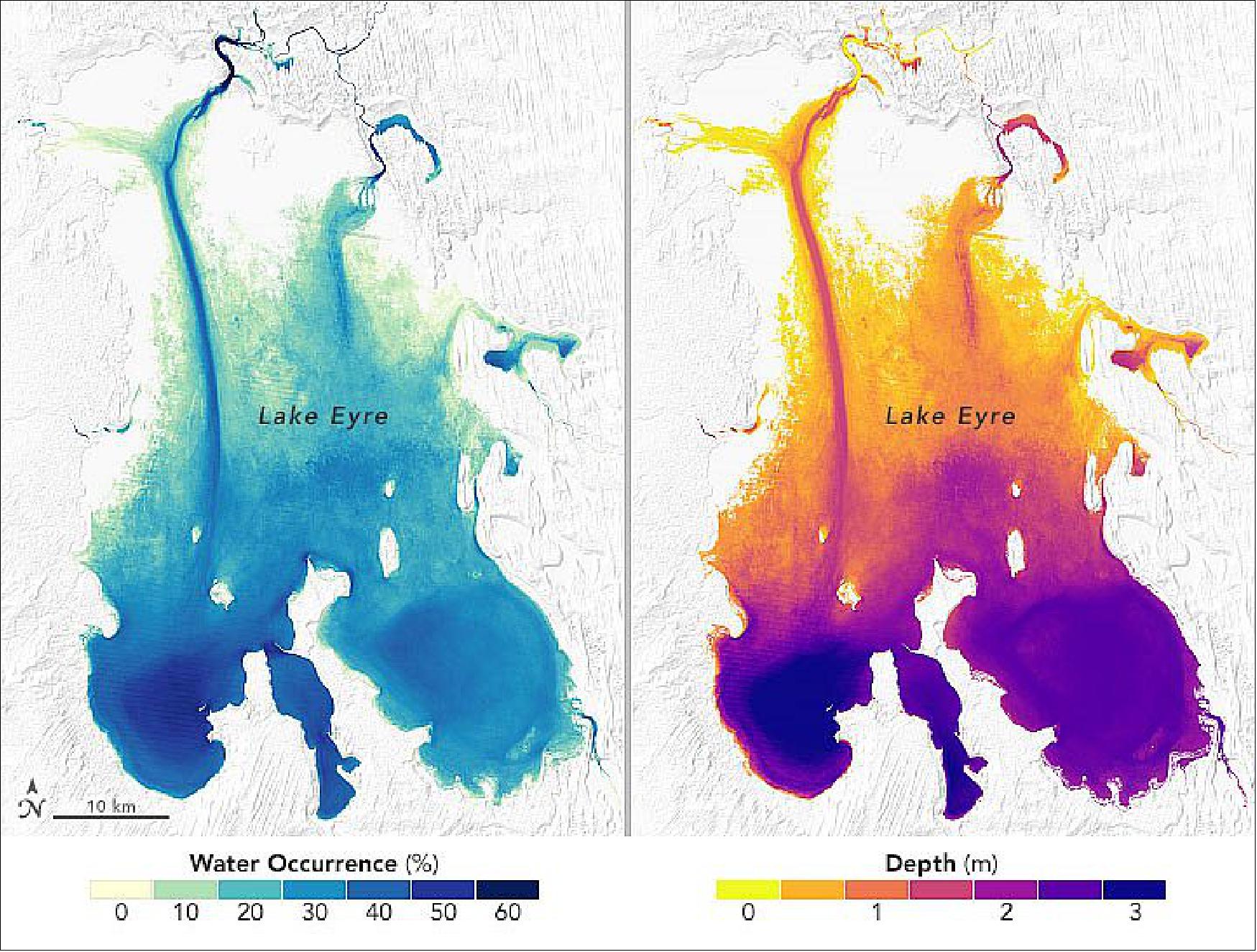
Figure 14: The left image shows how often—by percentage of the year—water was present in different parts of Lake Eyre from 1984 to 2015. The map was constructed using data from the Global Surface Water Explorer, which quantifies changes in global surface water over the past 32 years using Landsat images. The right image shows the depth of Lake Eyre as reconstructed by Armon and colleagues. They derived the map by combining the Landsat water occurrence data with land elevation data from NASA’s ICESat-2 (Ice, Cloud and land Elevation Satellite-2). (image credit: NASA Earth Observatory)
• March 3, 2021: Scientists conducted the first global assessment of fluctuating water levels in lakes and reservoirs using NASA's ICESat-2 satellite, which measures surface heights with high precision through laser pulses. The study analyzed 227,386 water bodies over 22 months, revealing that while natural lakes typically fluctuate about 8.6 inches (0.22 m) seasonally, human-managed reservoirs experience a nearly quadruple variation of around 34 inches (0.86 m). Reservoirs account for 57% of global water storage variability, significantly impacting the hydrological cycle. The research highlights how human activities alter freshwater availability, providing a valuable baseline for future investigations into water management amid growing demands and climate change. By combining ICESat-2's height measurements with Landsat's detailed maps, researchers can now detect smaller lakes and reservoirs, allowing for more comprehensive studies of freshwater dynamics globally. 39) 40)
Figure 15: To investigate humans’ impact on freshwater resources, scientists have now conducted the first global accounting of fluctuating water levels in Earth’s lakes and reservoirs – including ones previously too small to measure from space (video credits: NASA's Goddard Space Flight Center/Scientific Visualization Studio)
• December 9, 2020: NASA’s ICESat-2 satellite, originally designed to measure ice, is proving valuable for a wide range of Earth science applications beyond its primary mission. Since its launch in September 2018, ICESat-2 has provided high-precision elevation measurements, allowing researchers to study not only polar ice but also coastal ecosystems, river dynamics, and even the depths of meltwater ponds on sea ice. For example, scientists have used ICESat-2 data to more accurately assess melt pond depths, track changes in Arctic sea ice, and improve measurements of river flow in mountainous regions. Additionally, researchers are leveraging ICESat-2's capabilities to map shallow coastal waters and measure mangrove forests, enhancing understanding of biomass and carbon storage. The satellite’s continuous global coverage has sparked innovative research across disciplines, with scientists exploring various applications, such as improving bathymetric maps and monitoring sea level rise, showcasing the mission's extensive impact on environmental science. 41)
Figure 16: ICESat-2's main science objective is ice, but the mission is also able to measure the heights of other features, including ocean bathymetry, trees and mountain glaciers (video credit: NASA's Goddard Space Flight Center)
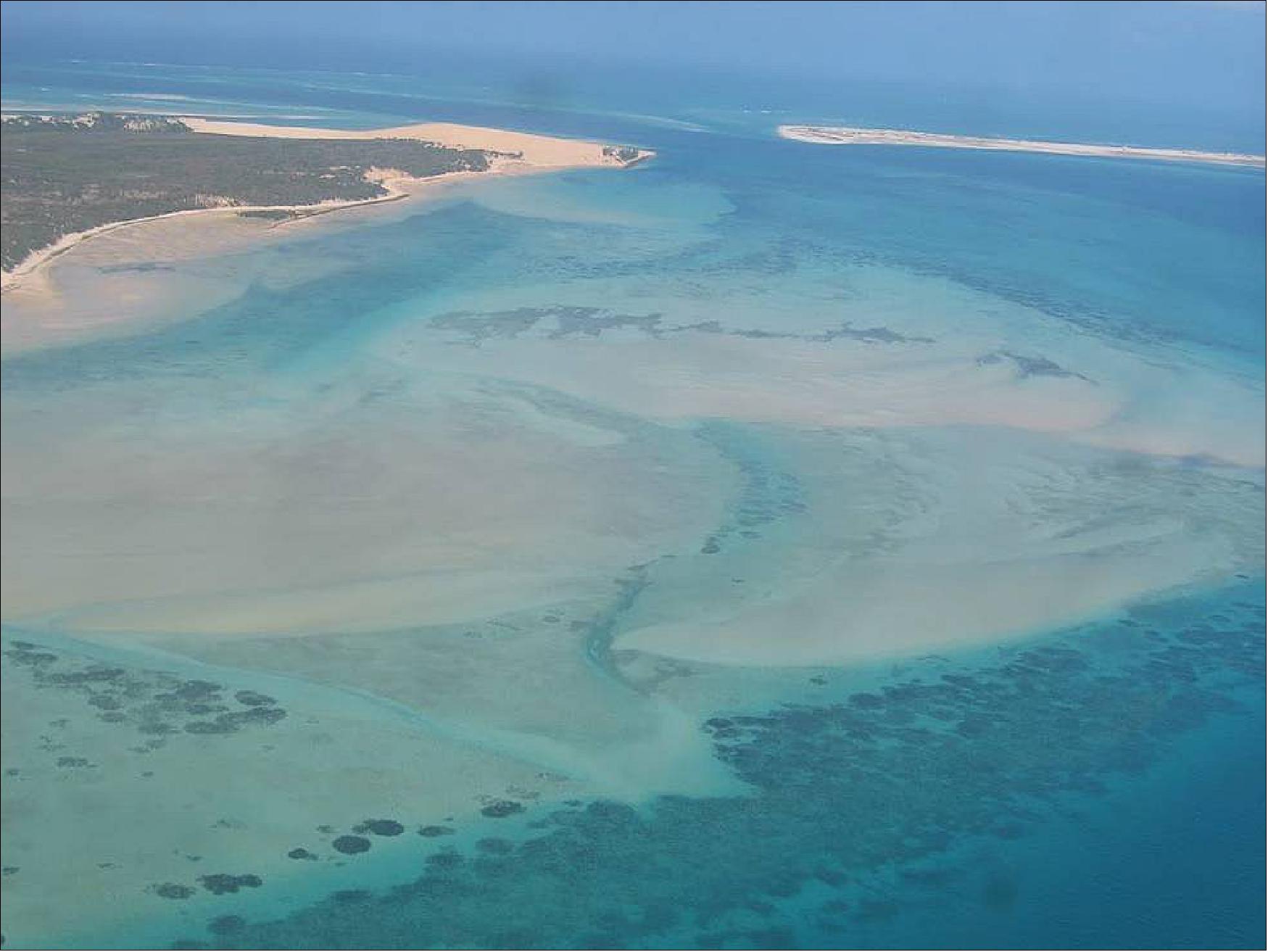
Figure 17: Scientists are using ICESat-2 to measure ecosystems far beyond the polar regions, including sea grass in shallow coastal waters such as this one in Mozambique (image credit: Lola Fatoyinbo/NASA)
• November 9, 2020: NASA's ICESat-2 satellite plays an important role in monitoring the health of Earth's ice-covered regions by measuring ice height, which helps assess mass changes over time. Launched in 2018, ICESat-2 utilises advanced laser altimetry to provide precise elevation measurements, allowing scientists to track the melting and mass loss of glaciers and ice sheets, particularly in Greenland and Antarctica. The satellite collects data at a high frequency and resolution, with the ability to detect annual height changes within 4 mm. Combined with measurements from other satellites, such as ESA’s CryoSat-2 and NASA’s GRACE missions, researchers are developing better models of ice mass balance and sea level rise. Observations indicate that Greenland is losing an average of 200 gigatons of ice per year, primarily due to surface melting, while Antarctica loses around 118 gigatons annually, influenced by warmer ocean temperatures. These comprehensive datasets are essential for understanding how climate change is affecting Earth's ice reserves and sea levels. 42)
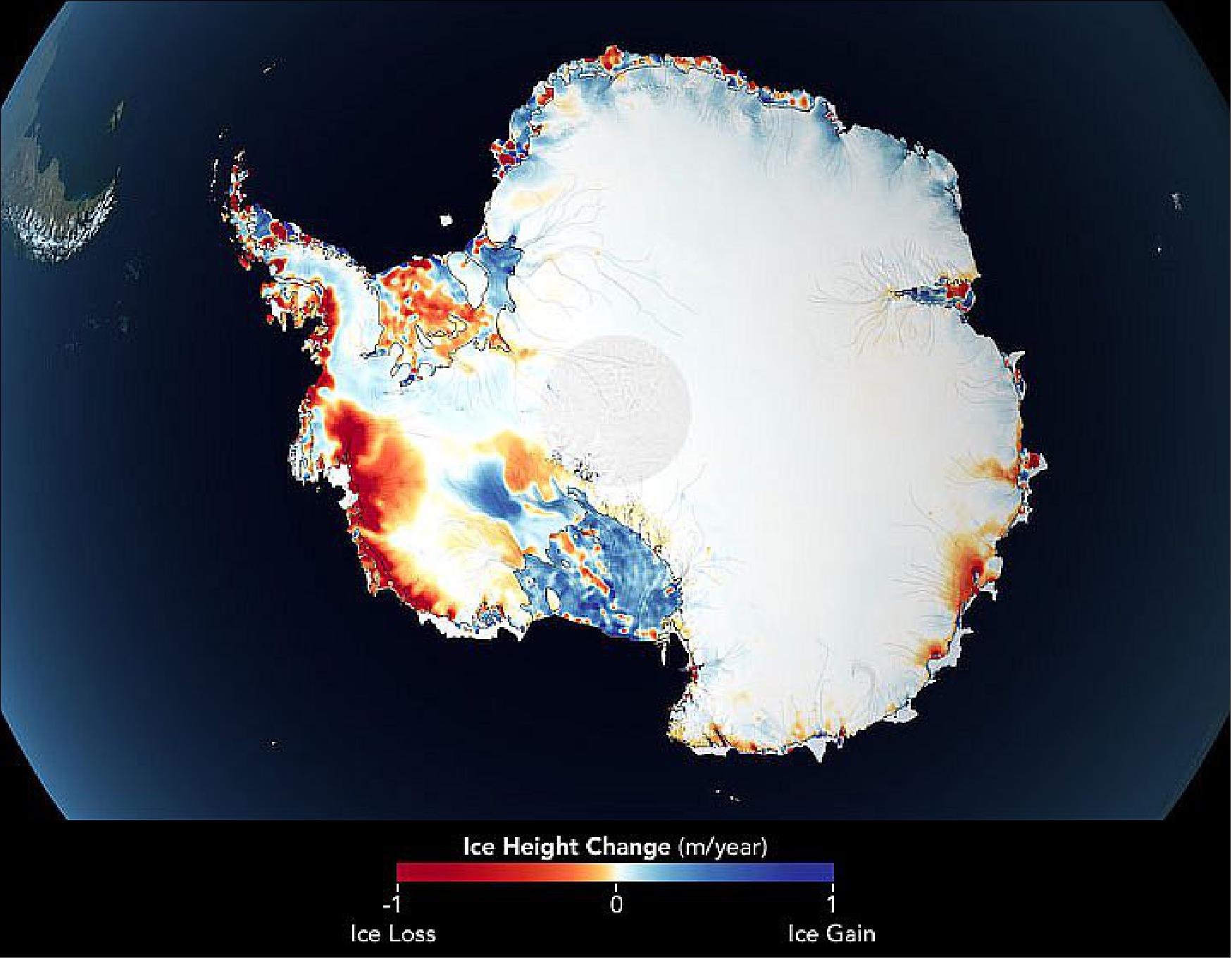
Figure 18: The map above shows changes in land ice thickness in Antarctica between 2003-2009 and 2018-2019, as measured by ICESat and ICESat-2. (image credit: NASA Earth Observatory)
• October 27, 2020: TCarta Marine, based in Denver, CO, has developed new machine learning-based bathymetric mapping technologies using NASA's ICESat-2 satellite, with funding from the National Science Foundation (NSF). The company has released two software packages: a Multispectral Bathymetric Tool for Esri ArcPro, which processes satellite-derived bathymetry data, and an ICESat Data Extraction Software that uses AI to extract seafloor depth measurements from ICESat-2 laser data. Initially funded through a Phase 1 grant to develop shallow-water seafloor depth techniques, TCarta's Phase 2 grant has focused on commercial applications across various sectors, including oil spill management and coastal infrastructure. Notably, TCarta applied its new techniques in significant projects like mapping the seafloor after the Wakashio shipwreck in Mauritius and processing extensive Sentinel 2 imagery to create a bathymetric map for hurricane preparedness in the Bahamas, validating its methods with millions of ICESat-2 data points. 43)
• September 29, 2020: Coastal waters, vital for human activities yet often poorly mapped due to their turbulent and murky conditions, are being better surveyed through a combination of NASA's ICESat-2 satellite data and traditional ship-based sonar measurements. The ICESat-2 satellite uses its ATLAS altimeter to send 10,000 laser pulses per second, which can penetrate shallow water and return seafloor depth measurements, addressing the limitations of conventional mapping methods that struggle in these environments. This innovative approach enables researchers to fill gaps in bathymetric data, particularly in nearshore areas known as “the white ribbon,” where significant data shortages exist. With ICESat-2's capability to provide global coverage and repeat mapping every 91 days, scientists are now able to monitor essential coastal dynamics, including endangered habitats and sediment transport, across various regions, including Western Australia, French Polynesia, and Lake Tahoe, California. 44)
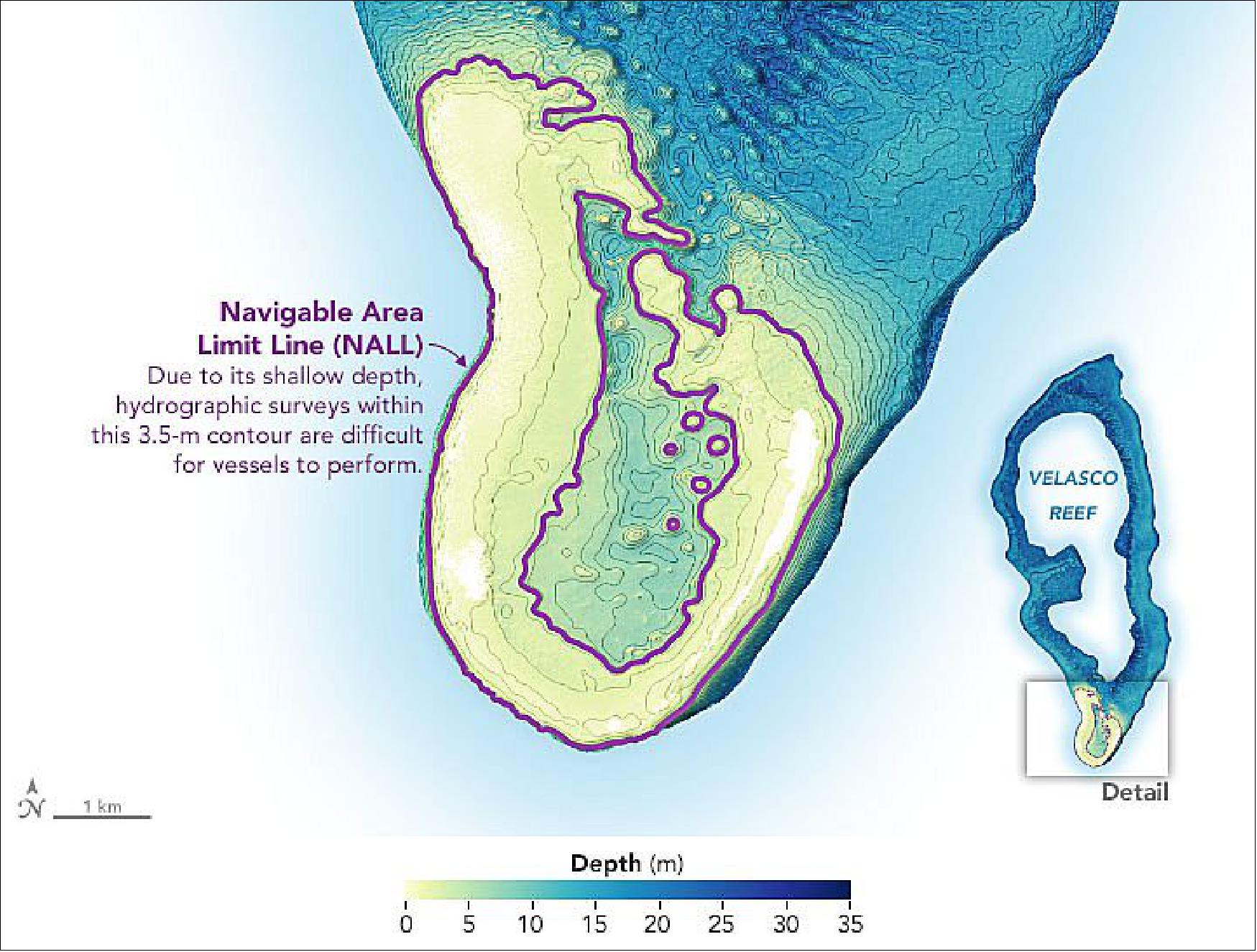
Figure 19: The maps show the NALL regions around Velasco Reef and the current water depths as measured by Magruder and Parrish’s team. This use of ICESat-2 data holds great potential. (image credit: NASA Earth Observatory)
• September 24, 2020: Recent studies of penguin populations on the Antarctic Peninsula reveal a decline in Adélie and chinstrap penguins while gentoo penguin numbers are increasing, potentially due to shifts in food availability linked to climate change. Gentoo penguins are moving further south, where they can find krill, their primary food source, in areas with optimal sea ice conditions. Researchers are utilising NASA's ICESat-2 satellite, which employs laser altimetry to measure sea ice and open water, to better understand the dynamics of penguin habitats throughout the year. This data enables scientists to identify critical foraging areas and will inform future statistical models examining how the proximity of open water influences penguin population trends. Nathan Kurtz, a NASA sea ice scientist, highlights the innovative application of ICESat-2 data for this research, noting its unexpected utility in understanding environmental drivers affecting wildlife. 45)
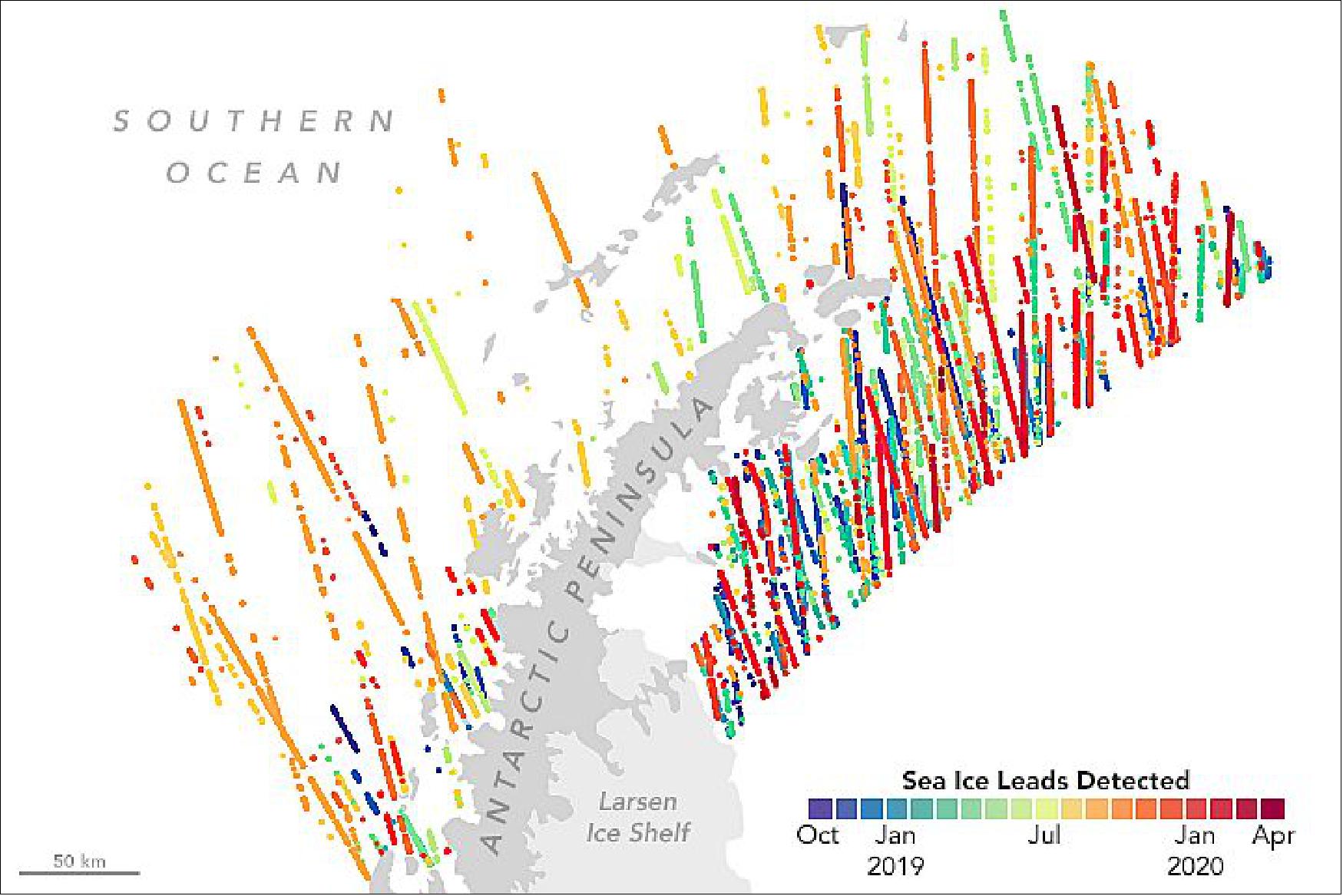
Figure 20: In this map, lines indicate where ICESat-2 detected leads in the sea ice around the Antarctic Peninsula from October 2019 through April 2020. Each point on the lines represents a location along the satellite’s orbital path where the sensor detected open water. (image credit: NASA Earth Observatory)
• July 16, 2020: Scientists are preparing to enhance the study of Earth's frozen regions by synchronising the orbits of the European Space Agency's CryoSat-2 satellite and NASA's ICESat-2. Starting July 16, 2023, CryoSat-2 will be maneuvered about half a mile higher to enable both satellites to pass over the Arctic within hours of each other, allowing for simultaneous laser and radar measurements of sea ice. This alignment will enable researchers to gain unprecedented insights into snow depth and sea ice thickness, as CryoSat-2's radar can penetrate snow to reflect off the ice below, while ICESat-2's lidar measures the top of the snow layer. This combined data will improve understanding of the Arctic climate system and enhance climate models, as well as provide more accurate shipping navigation forecasts. The initiative has been long-awaited in the ice science community, promising new scientific possibilities that were previously unattainable with either satellite alone. 48)
Figure 21: In July 2020, ESA began to slightly perturb the orbit of CryoSat-2 to increase the overlap with ICESat-2. Given their different orbit altitudes, the result is a roughly 2,000-mile (3,200-km) stretch of sea ice that is measured by both ICESat-2 and CryoSat-2. By combining data from these two sensors, scientists can measure the snow layer thickness, and produce substantially improved sea ice thickness estimates (video credits: NASA's Goddard Space Flight Center)
• May 27, 2020: For the past two decades, satellite data have documented a significant decline in Arctic sea ice, highlighting the critical role of the snow layer on top of the ice in regulating growth and melt processes. To better understand snow depth across the Arctic Ocean, scientists have created the first satellite-based maps using data from NASA’s ICESat-2, which utilizes a laser altimeter, and the European Space Agency's CryoSat-2, equipped with a radar altimeter. This innovative method allows researchers to estimate snow depth by comparing the elevation measurements from both satellites, enabling a more comprehensive understanding of how climate change impacts precipitation and snow accumulation. However, the effectiveness of this approach depends on the simultaneous operation of both satellites, raising concerns about the future of snow depth mapping if CryoSat-2 is lost. 49) 50)
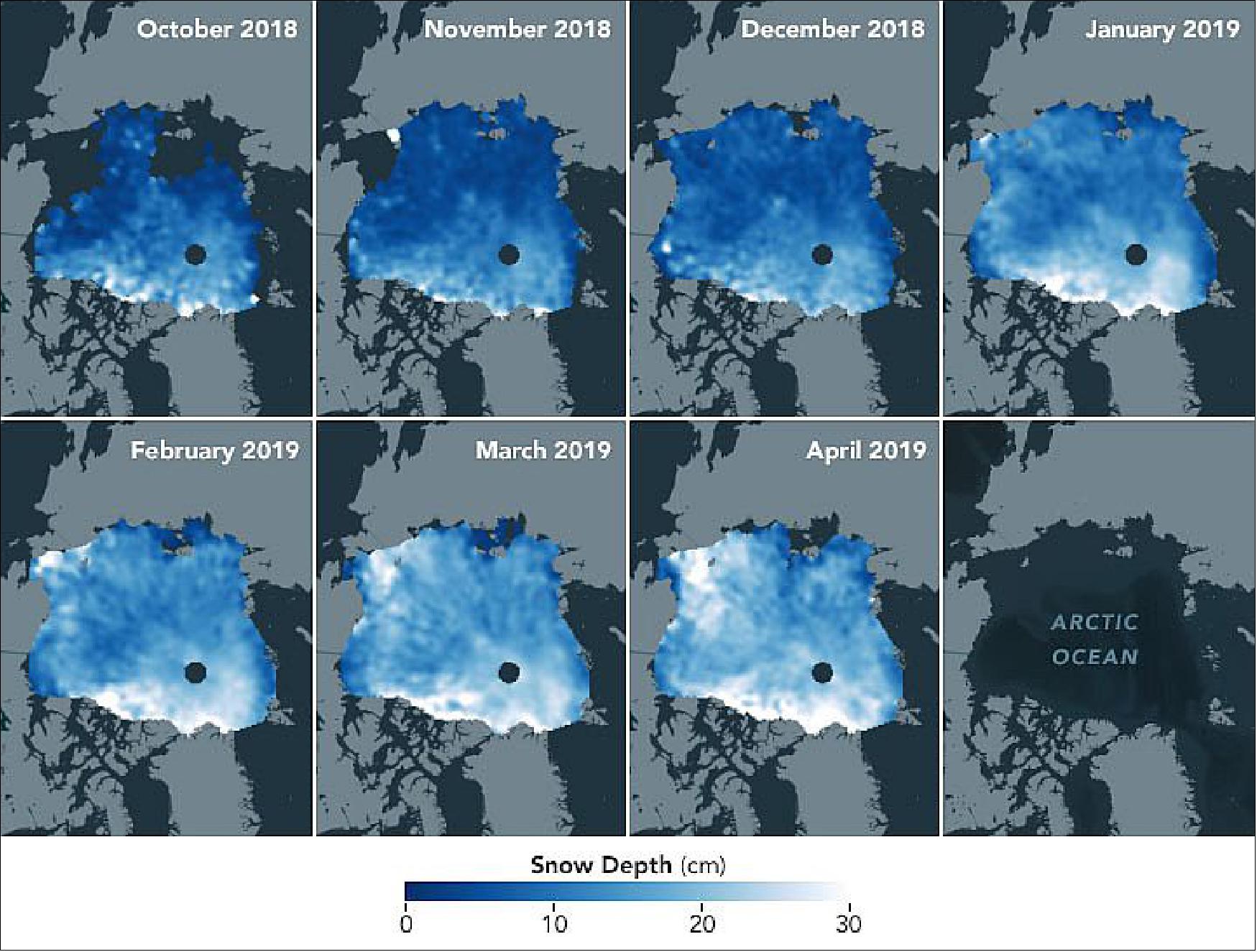
Figure 22: First-of-a-kind maps show how the depth of this insulating snow layer changes from month to month. The maps show snow depths across Arctic sea ice, averaged monthly from October 2018 through April 2019. (image credit: NASA Earth Observatory)
• May 14, 2020: NASA's ICESat-2 satellite has provided new insights into the ongoing decline of Arctic sea ice, suggesting it has thinned by up to 20% since the end of the first ICESat mission (2003-2009), a finding that contrasts with previous studies showing relatively stable thickness over the last decade. ICESat-2 utilizes a laser altimeter to precisely measure height, allowing researchers to derive sea ice thickness and create the first comprehensive maps of snow accumulation on Arctic sea ice by comparing measurements with the European Space Agency's CryoSat-2, which employs radar altimetry. The study highlights that snow depth plays a critical role in the climate and insulation of sea ice, with snow accumulation peaking in April, influencing the rate of ice melting in spring. This dual approach to measuring ice thickness and snow depth underscores the complexities of monitoring Arctic changes, with both satellites offering valuable but distinct data that researchers aim to reconcile for a clearer understanding of the ice's behavior in a warming climate. 51) 52) 53)
Figure 23: A view of the Arctic Ocean with monthly average sea ice thickness spanning November 2018 to March 2019. Low values are depicted in light blue, and higher values (5 meters) are depicted in magenta (video credit: NASA)
• April 30, 2020: Using NASA's ICESat-2, scientists have conducted a detailed 16-year study of the elevation changes in the Greenland and Antarctic ice sheets, revealing a significant imbalance between ice gains in East Antarctica and massive losses in West Antarctica. The findings indicate that from 2003 to 2019, Antarctica lost an average of 118 gigatons of ice per year, while Greenland lost about 200 gigatons annually, contributing approximately 0.55 inches (14 mm) to global sea level rise. The ICESat-2's advanced laser altimeter enables precise measurements of ice sheet changes, allowing researchers to map how glaciers and ice shelves are responding to climate variations. The study highlights that while some areas of Antarctica are gaining ice due to increased snowfall, these gains are far surpassed by losses along the coast due to warmer ocean waters. Additionally, ICESat-2 has provided insights into the mass loss of floating ice shelves, which, although not directly contributing to sea level rise, are critical for maintaining the stability of the glaciers behind them. 54) 55)
Figure 24: Climate change is reshaping ice sheets in the Arctic and Antarctic, and NASA's ICESat and ICESat-2 satellites help researchers determine what those alterations look like (video credit: NASA/JPJ/Caltech)
• December 13, 2019: NASA’s Operation IceBridge conducted airborne surveys of Arctic, Antarctic, and Alaskan ice from 2009 to 2019, bridging the gap between the ICESat and ICESat-2 satellite missions. Using a rotating fleet of aircraft equipped with advanced instruments—such as elevation-mapping lasers, ice-penetrating radars, and cameras—IceBridge monitored sea ice thickness, glaciers, and ice sheets in unprecedented detail. The mission’s decade of surveys mapped extensive grounding lines in Antarctica and Greenland, critical areas where glaciers detach from bedrock, enabling scientists to better understand ice dynamics and refine sea level rise models. IceBridge’s comprehensive data collection expanded on earlier projects by covering both poles annually and providing crucial insights into ice elevation and structural changes. 56)
• November 1, 2019: NASA’s ICESat-2 satellite captured elevation data of the Southern Carpathian Mountains on Halloween, the dramatic landscape that inspired Bram Stoker’s "Dracula". The region, often associated with the Dracula legend, includes landmarks like Poenari Castle, once the stronghold of Vlad Țepeş, the historical figure who inspired the vampire myth. Although Vlad was known for his brutal methods, the popular link to Bran Castle as "Dracula’s castle" is mostly a tourist-driven association, as there is no historical evidence that either Vlad or Stoker had any direct connection to it. 57)
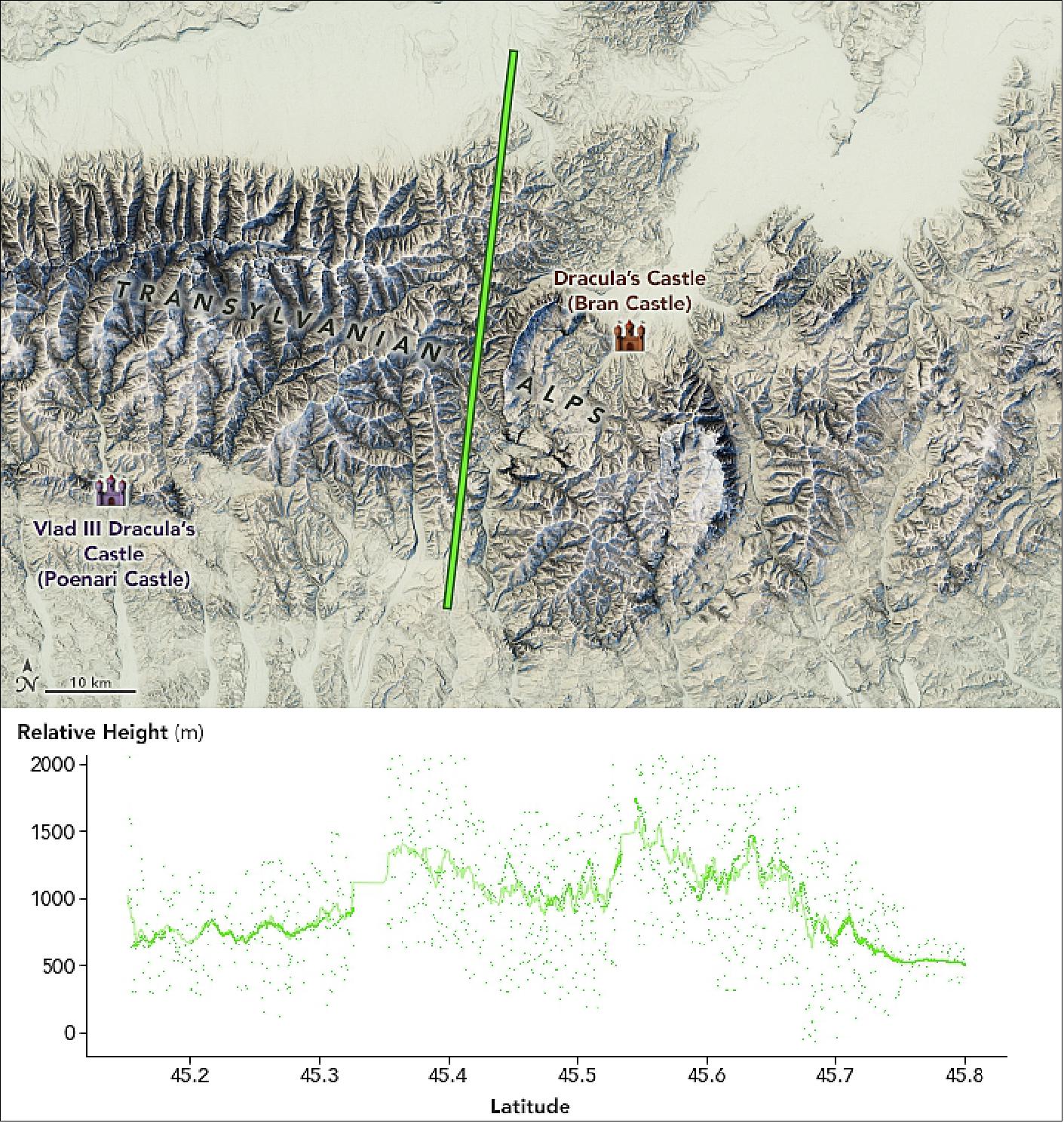
Figure 25: ICESat-2 captured elevation measurements with its ATLAS instrument over the Carpathian Mountains of Romania. The measurements are overlaid on topography data from NASA’s SRTM (Shuttle Radar Topography Mission) to emphasize the terrain (image credit: NASA Earth Observatory)
• October 18, 2019: Lake Mead, the largest reservoir in the U.S., has faced declining water levels since 1983 due to prolonged drought and high water demand. Seasonal changes affect the water level, with spring snowmelt from the Rocky Mountains temporarily raising it before summer usage lowers it again. In 2019, ICESat-2’s ATLAS instrument measured Lake Mead’s elevation, showing a spring-to-summer drop of 5.53 feet, consistent with U.S. Bureau of Reclamation data. Despite above-average snowpack that year, the reservoir system remains strained by a 20-year drought, affecting millions across the U.S. West and Mexico. ICESat-2’s repeat observations will help monitor these vital water resources over time. 58)
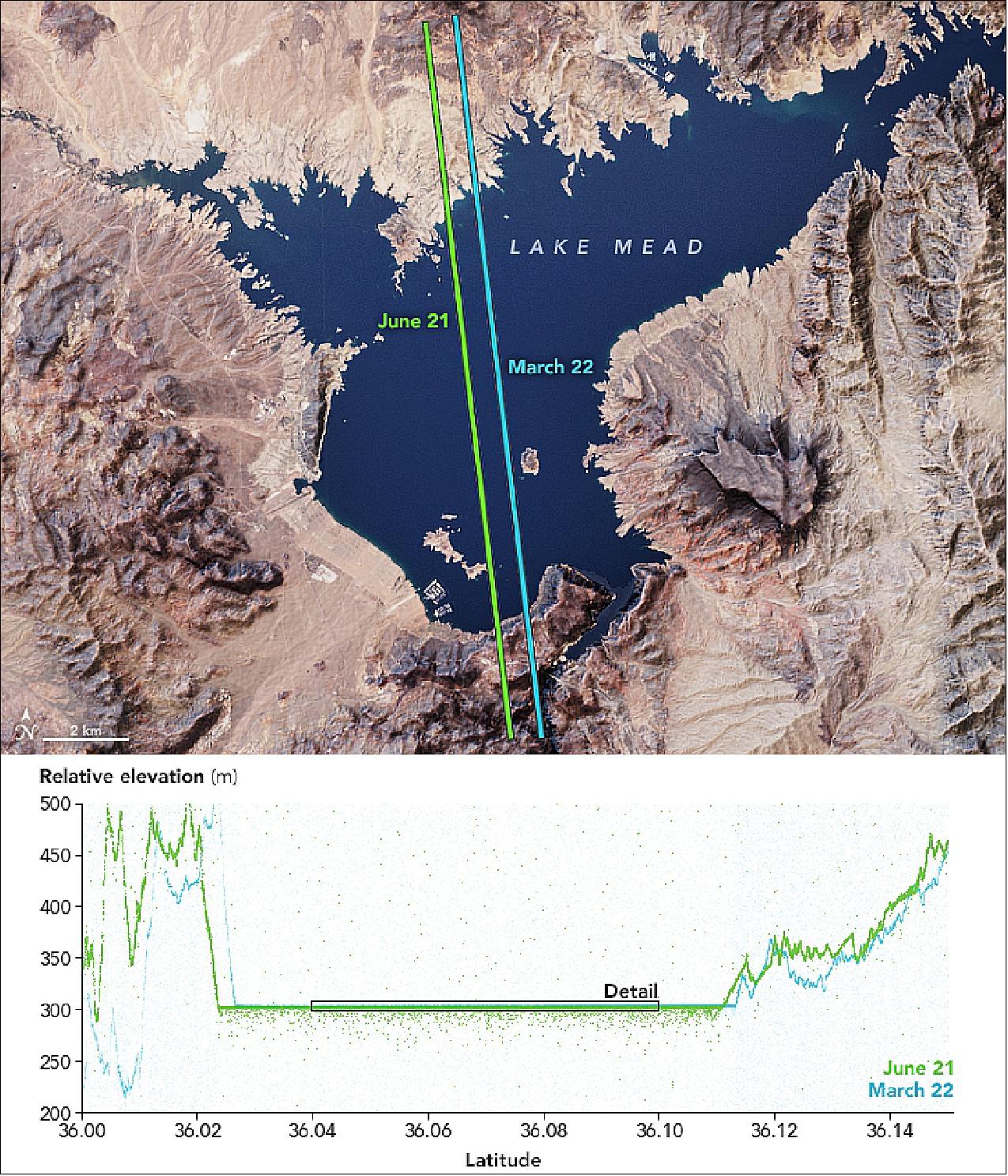
Figure 26: The seasonal change of water levels in the reservoir is visible in these elevation measurements acquired during two passes of ICESat-2 over Lake Mead. The first pass (blue) measured the lake’s relative elevation on March 22, 2019, two days after the spring equinox. The second pass (green) measured the elevation on the summer solstice, June 21, 2019. (image credit: NASA Earth Observatory)
• September 16, 2019: Photon Phriday is a weekly series showcasing data from ICESat-2’s Earth observations, led by Project Scientist Tom Neumann, who highlights significant measurements made in the satellite's first year. This initiative, shared on NASA’s @NASA_ICE account, provides updates on ICESat-2’s findings as it tracks changes in Earth’s ice, water, and land surfaces. 59)
Figure 27: Summary of the ICESat-2's first year in orbit. (video credit: NASA/GSFC, Ryan Fitzgibbons)
• July 29, 2019: For nearly a year, NASA's ICESat-2 satellite and its ATLAS laser instrument have been delivering highly detailed elevation measurements, accurate to within about 10 centimeters. An early pass over Oregon’s Crater Lake revealed Mount Mazama’s unique topography, showing the elevation changes around the lake's caldera and highlighting features such as the tree canopy and glacially carved valleys. ICESat-2’s data provides valuable insights for various scientific fields—terrestrial ecology, hydrology, and glaciology—allowing scientists to study ice sheet changes, sea ice freeboard, and vegetation canopy heights. Since data became public in May 2019, ICESat-2 has seen significant usage, with 350 users downloading data over 500,000 times within six weeks. 60)
![Figure 46: Elevation data show the distinct topography of Mount Mazama and the crater lake that fills its caldera [image credit: NASA Earth Observatory image by Joshua Stevens, using ICESat-2 data courtesy of Kaitlin Harbeck (NASA Goddard Space Flight Center), Landsat data from the U.S. Geological Survey, and topographic data from the Shuttle Radar Topography Mission (SRTM). Story by Kathryn Hansen]](https://www.eoportal.org/ftp/satellite-missions/i/ICESat2_290622/ICESat2_Auto25.jpeg)
Figure 28: Elevation data show the distinct topography of Mount Mazama and the crater lake that fills its caldera (image credit: NASA Earth Observatory)
• May 28, 2019: Since its launch in 2018, NASA’s ICESat-2 satellite has collected over a trillion highly precise measurements of Earth's surface, covering diverse terrains from Greenland's glaciers to Florida’s mangroves and Antarctica’s sea ice. This unprecedented data volume, surpassing the lifetime data volume of its predecessor (ICESat) in just a week, provides a dense global elevation grid and tracks seasonal and annual changes. Using six laser beams, ICESat-2 detects fine details like crevasses in ice, tree canopy heights, and even seafloor contours up to 30 meters underwater in clear areas. The satellite’s accuracy is verified by airborne surveys and ground campaigns, enabling scientists to closely monitor changes in ice and land height, crucial for understanding sea level rise and climate impacts. ICESat-2 data is freely available through the National Snow and Ice Data Center, opening new opportunities for research across multiple fields. 64)
Figure 29: For a second consecutive year, NASA researchers braved extreme cold, high winds, and challenging altitudes on the 470-mile 88-South Traverse in Antarctica to validate ICESat-2’s data accuracy. This expedition across one of Earth’s harshest landscapes provides crucial ground-based measurements to assess and improve the satellite’s precise elevation readings from space. (video credit: NASA)
• January 29, 2019: NASA's ICESat-2 satellite, equipped with the high-resolution ATLAS laser altimeter, has begun transforming our view of Earth's topography by capturing detailed height measurements across polar, tropical, and temperate regions. Its data shows precise elevation readings over diverse terrains, from Antarctica's icy surfaces to Mexico's forested landscapes and coastal bathymetry. ICESat-2 tracks heights from tree canopies to seafloor depths (up to 25 meters in clear waters), and even maps wave patterns over the ocean. The mission is already surpassing expectations, providing insights into carbon storage in forests, coastal storm surge modeling, and ocean wave dynamics. 65)
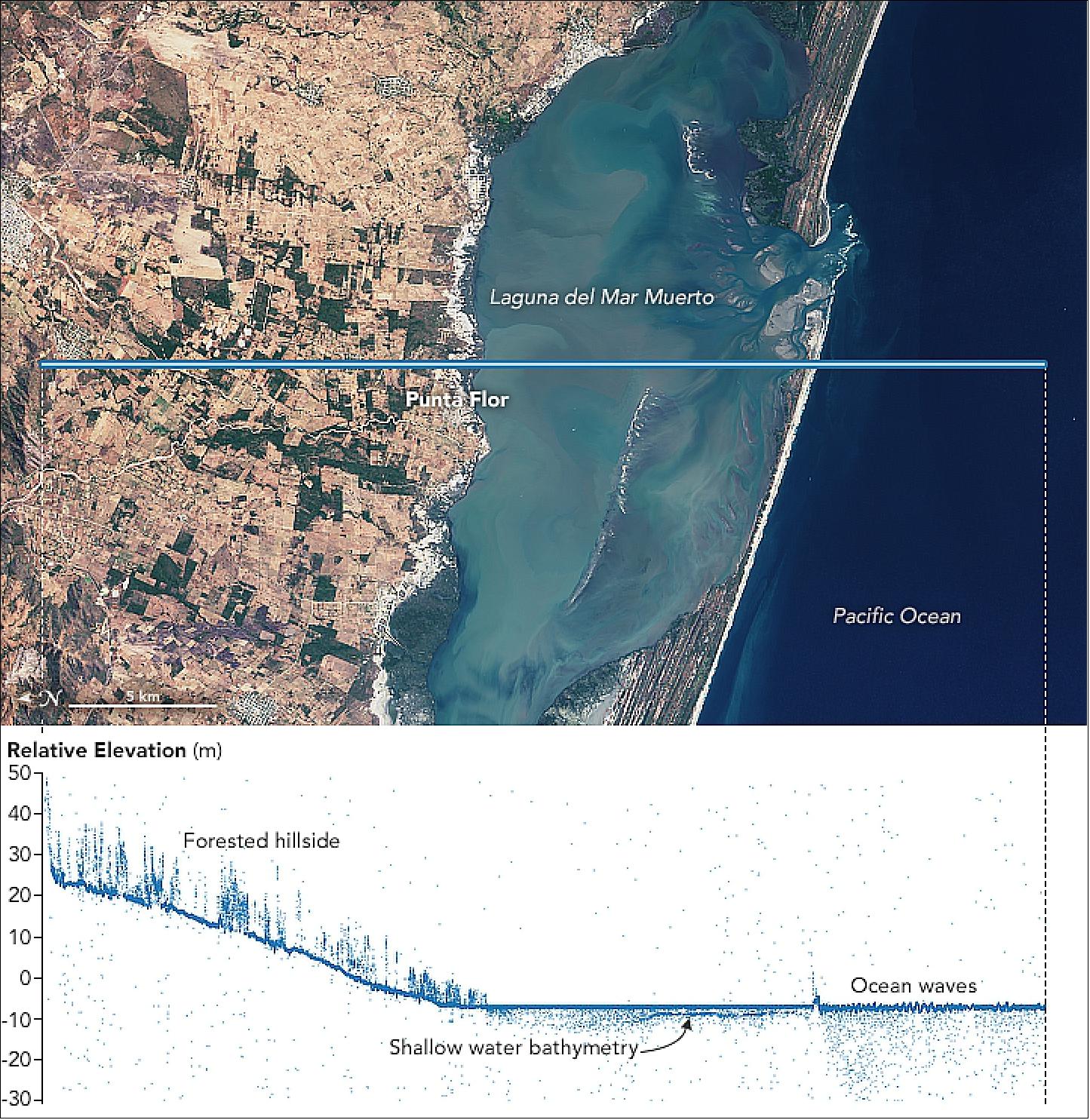
Figure 30: A forested hillside in Mexico is visible in the elevation measurement, acquired on October 19, 2018, by ATLAS on ICESat-2. (image credit: NASA Earth Observatory)
• December 12, 2018: NASA's ICESat-2 provides highly detailed measurements of Earth's surface heights, covering polar regions, mountain ranges, and forested areas. Among its initial observations, ICESat-2 has captured elevation data from the Antarctic terrain, from the smooth Ross Ice Shelf to the rugged Queen Maud Mountains. The satellite's laser altimetry tracks changes in steep slopes and valleys and gathers data across more southern latitudes, filling previous data gaps. This expanded coverage allows scientists to begin detailed comparisons with past measurements from ICESat, aiming to track changes in ice sheet elevations and to refine sea level projections. 66)
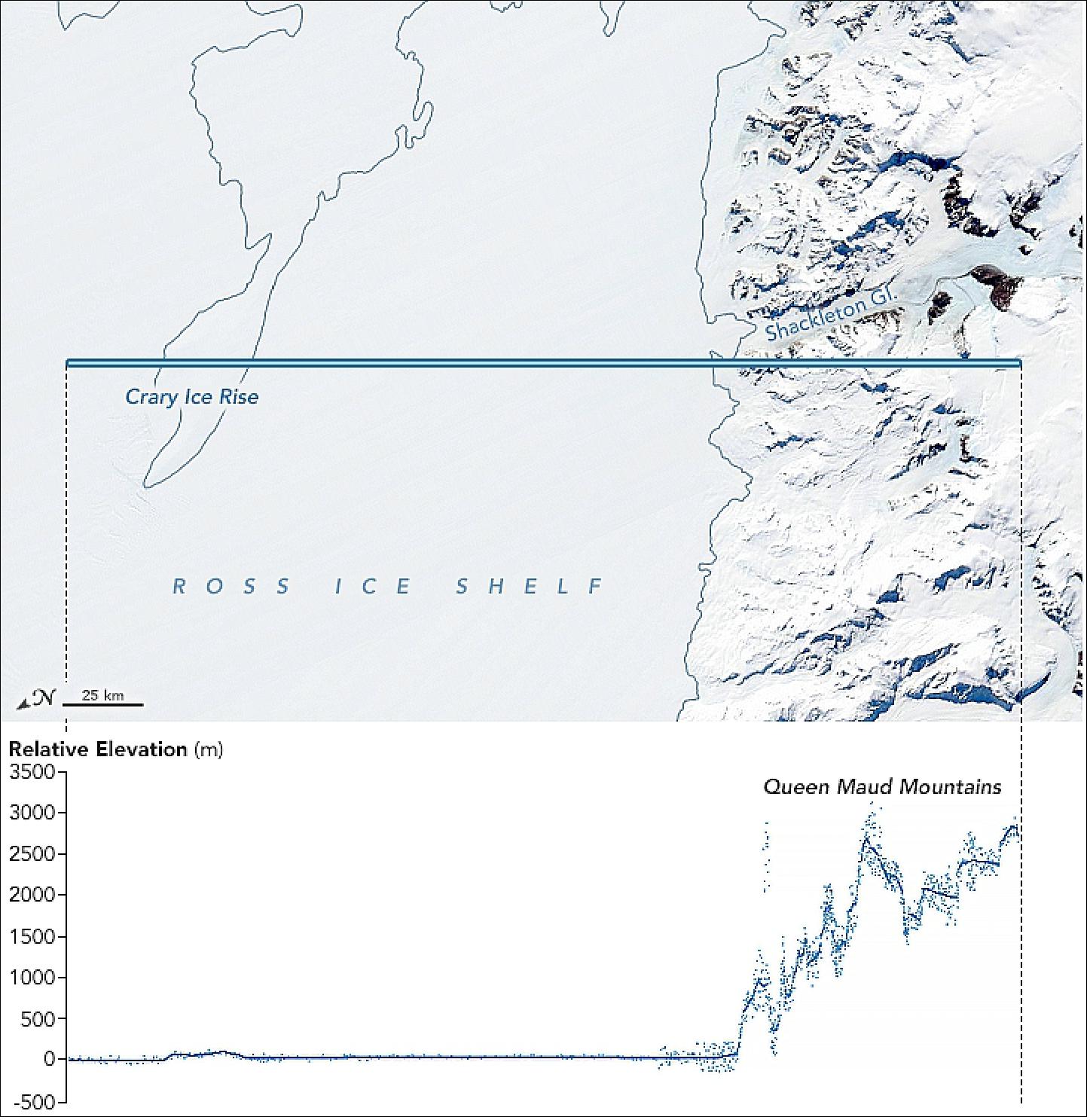
Figure 31: New elevation measurements of the ATLAS instrument on ICESat-2 span the continent’s icy surfaces, from the flat Ross Ice Shelf to the rugged Transantarctic Mountains (image credit: NASA Earth Observatory)
• December 11, 2018: ICESat-2, equipped with the Advanced Topographic Laser Altimeter System (ATLAS), is providing high-resolution elevation data on Earth’s surfaces, particularly over Arctic and Antarctic sea ice. The satellite measures variations in ice thickness and height by detecting features such as thin ice, ice ridges, and open water leads. By comparing the height of the water surface in leads with that of the surrounding ice, scientists can estimate ice freeboard and thickness. This capability enhances understanding of seasonal changes in polar regions and contributes to improved climate models and sea ice forecasts. 67)
- In addition to its polar observations, ICESat-2 captures data over tropical and temperate latitudes, revealing details such as individual ocean waves and bathymetry in coastal areas, which can aid in storm surge modeling. The satellite also distinguishes between tree tops, inner canopies, and the forest floor, helping to refine estimates of global carbon storage. NASA's Operation IceBridge supports the validation of ICESat-2 data by conducting airborne surveys over the same regions, ensuring the accuracy and continuity of polar elevation measurements initiated by the original ICESat satellite.
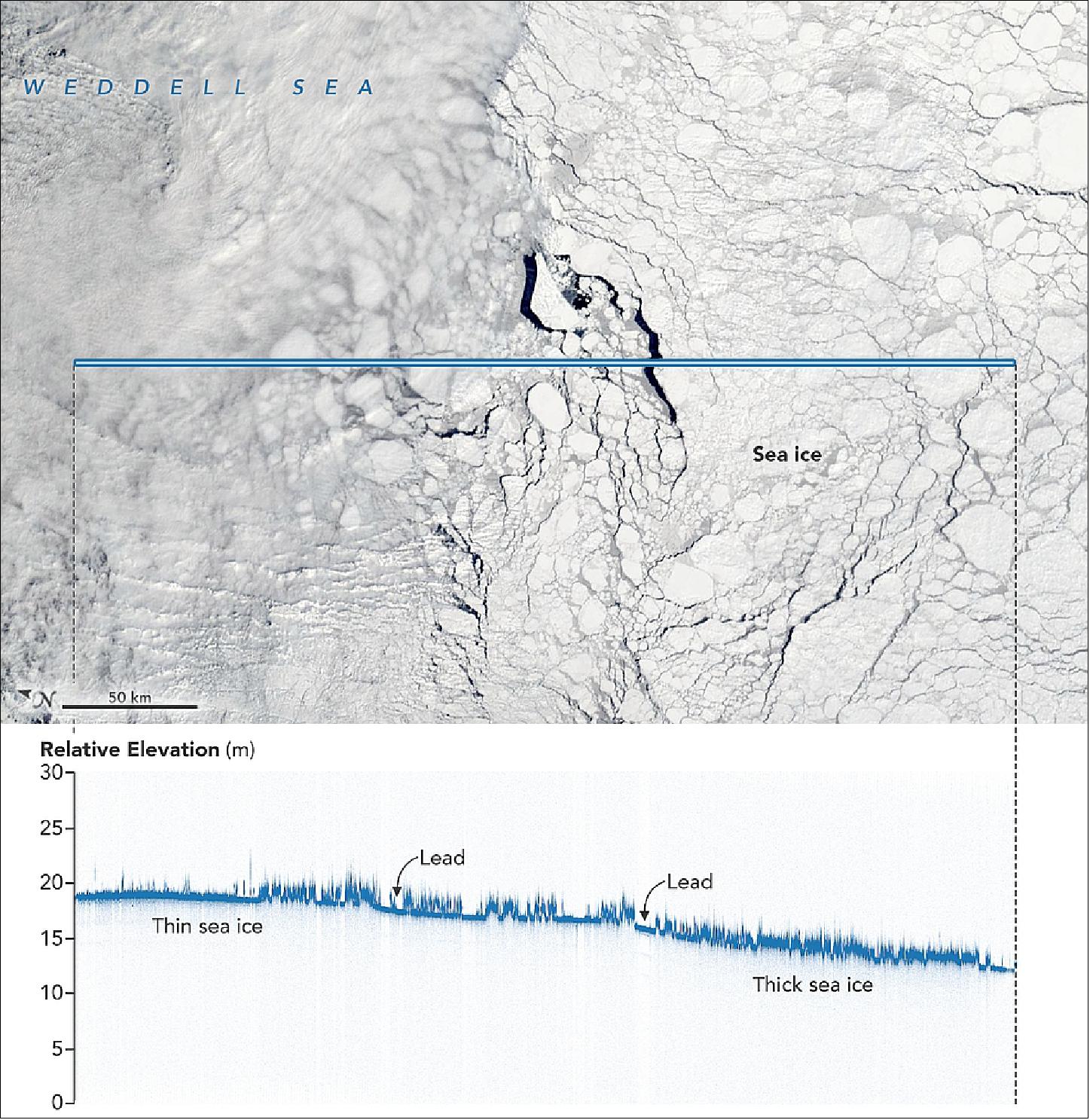
Figure 32: The plot shows how sea ice of different thickness and bumpiness is broken up by the cracks between floes, called leads. Data collected by ICESat-2 as it orbits over the Weddell Sea in Antarctica (image credit: NASA Earth Observatory)
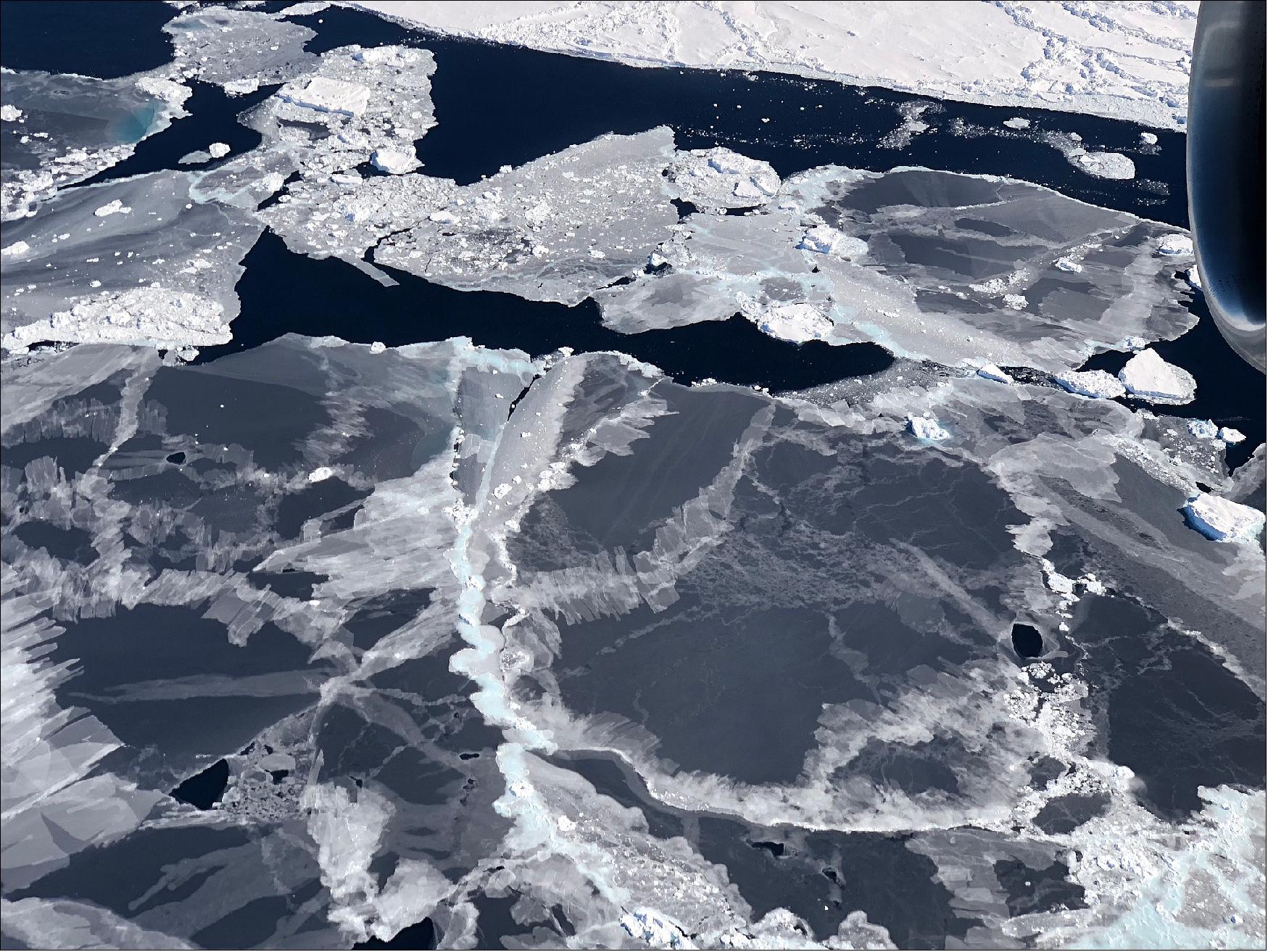
Figure 33: Sea ice forms in the open water between floes, called leads, in the Bellingshausen Sea. ICESat-2 is able to detect the thin sea ice, allowing scientists to more accurately track seasonal ice formation (image credit: NASA)
• October 3, 2018: NASA's ICESat-2 satellite successfully activated its laser instrument, the Advanced Topographic Laser Altimeter System (ATLAS), on September 30, emitting 10,000 pulses per second and sending 300 trillion photons to Earth. Following a two-week wait for contaminants to dissipate, the team celebrated the successful opening of the telescope's protective door and the firing of the laser. By October 3, the satellite transmitted its first height measurements over the Antarctic ice sheet, generating a "photon cloud" that plots the elevation data. The team continues to optimise the instrument to enhance data quality, with expectations for detailed scientific data to follow in the coming weeks. 68)
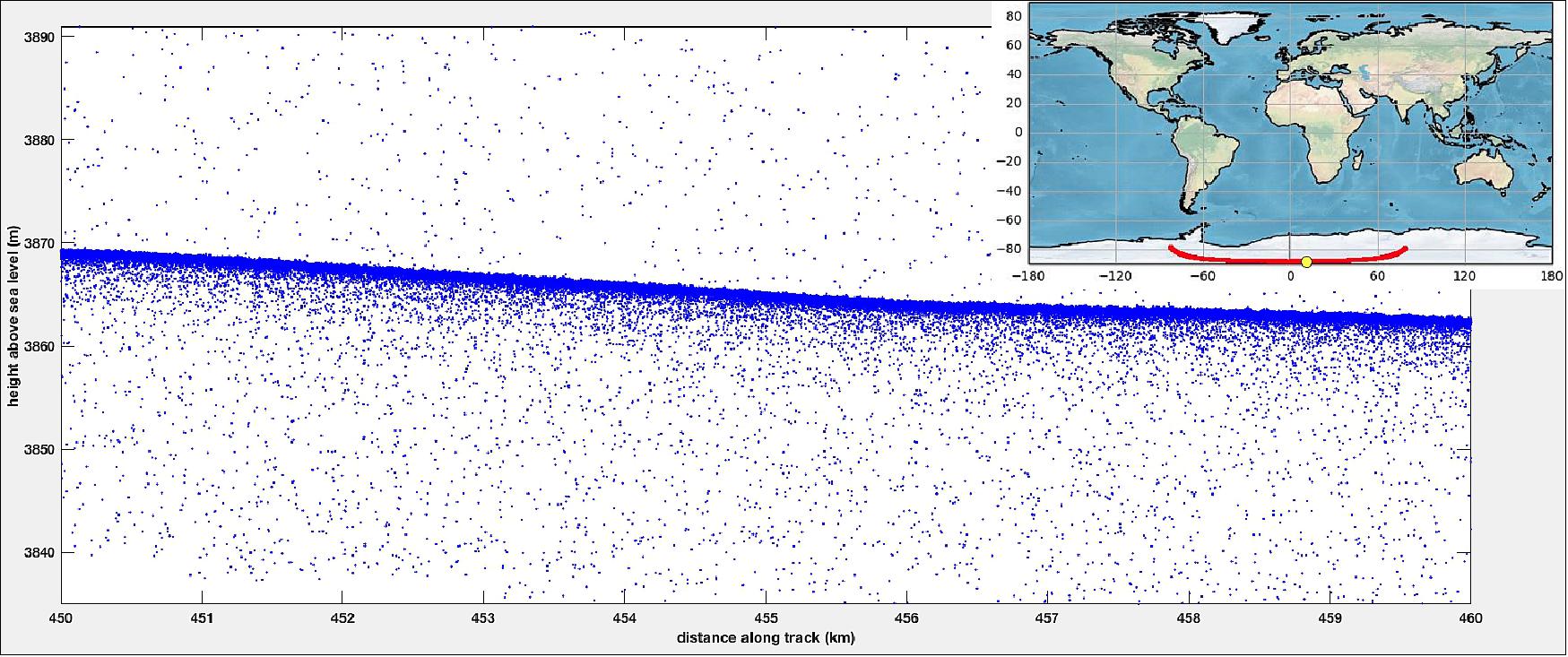
Figure 34: A visualization of ICESat-2 data, called a photon cloud, shows the first set of height measurements from the satellite, taken as it orbited over the Antarctic ice sheet. Each blue dot represents a photon detected by the ATLAS instrument. This photon cloud shows the elevation measured by photons in the middle of the ice sheet, following along 10 km of the satellite’s ground track, from left to right. The speckled dots are background photons from sunlight, but the thick blue line is actually a concentration of dots that represent laser photons that returned to the ICESat-2 satellite (image credit: NASA)
• September 15, 2018: Ground stations in Svalbard, Norway, successfully received signals from NASA's ICESat-2 satellite approximately 75 minutes after its launch, confirming that the spacecraft is performing as expected while orbiting the Earth from pole to pole. Thomas Zurbuchen, associate administrator of NASA's Science Mission Directorate, emphasized that this mission enhances understanding of the ongoing changes in Earth's ice cover and their global implications. Additionally, ICESat-2 is expected to overlap operationally with other atmospheric missions such as ADM/Aeolus and EarthCARE from 2018 to 2022, though its synergies with CALIPSO and CATS are less certain due to the latter missions' extended lifetimes and potential for follow-on projects. 69)
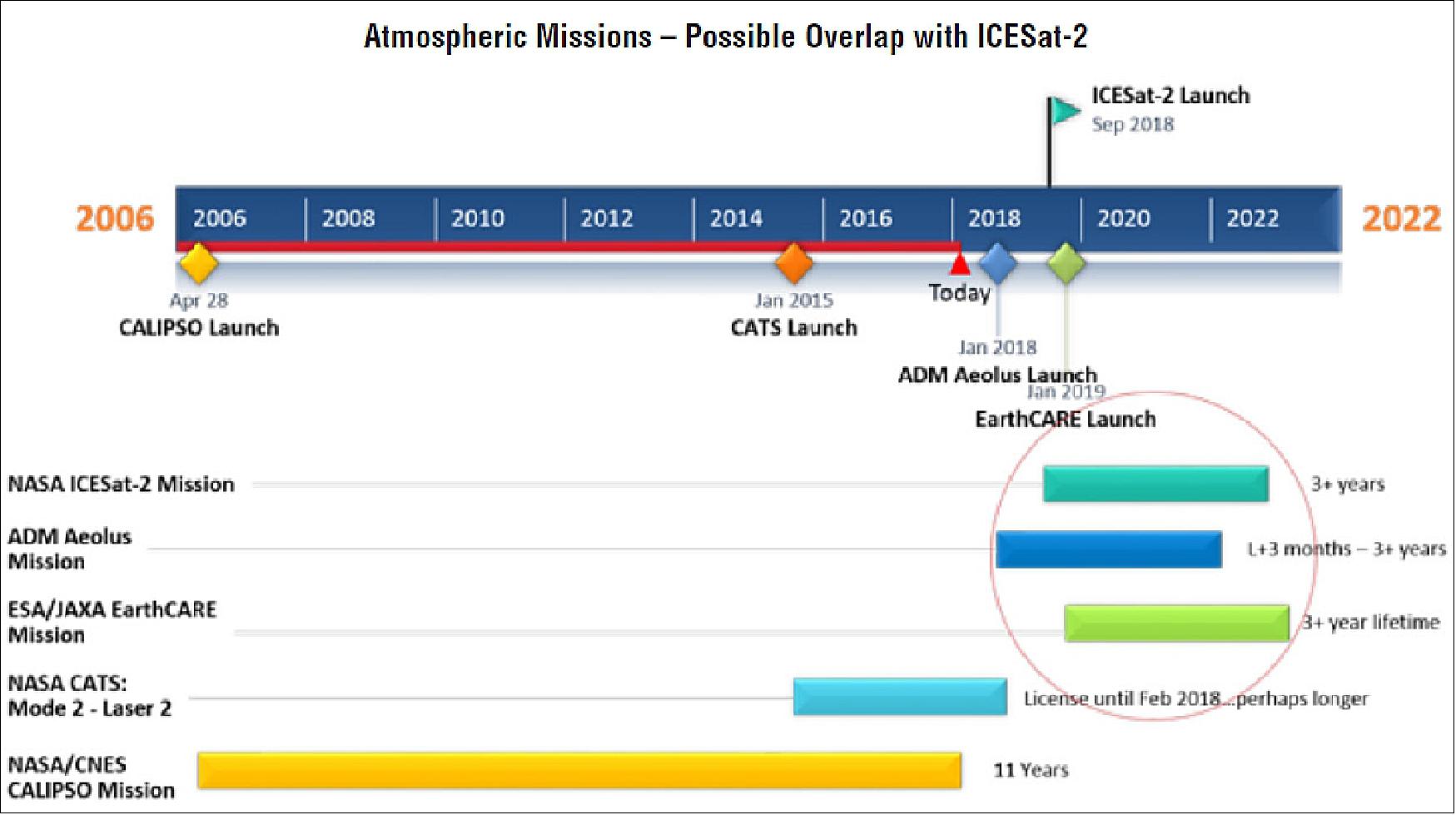
Figure 35: The bar chart shows the current projected timetables for the atmospheric missions. The circle shows the area of possible overlap with ICESat-2 (image credit: NASA)
Sensor Complement
ATLAS (Advanced Topographic Laser Altimeter System)
ICESat-2 will use a new type of laser altimeter instrument, ATLAS, for measuring elevation, and will acquire far more data. To test the instrument concept, and develop accurate software to process the data, NASA has been flying an instrument called MABEL (Multiple Altimeter Beam Experimental Lidar) on high-altitude aircraft (ER-2) to simulate measurements that the ATLAS (Advanced Topographic Laser Altimeter System) — GLAS’s successor–will be making from space. 70) 71)
ATLAS instrument science measurement requirements (Ref. 75)
Land Ice: Ice‐sheet elevation changes to 0.4 cm/yr accuracy on an annual basis.
- Annual surface elevation change rates on outlet glaciers to better than 0.25 m/yr over areas 100 km2 for year‐to‐year averages.
- Surface elevation change rates to an accuracy of 0.4 m/yr along 1 km track segments for dynamic ice features that are intersected by the ICESat‐2 set of repeated ground‐tracks.
- Resolution of winter (accumulation) and summer (ablation) ice‐sheet elevation change to 10 cm at 25 km x 25 km spatial scales.
Sea Ice: Monthly surface elevation measurements with a track density of better than 30 km poleward of 70º, to enable the determination of sea ice freeboard when sea surface references are available, under clear sky conditions, to an uncertainty of 3 cm along 25 km segments, for the Arctic Ocean and Southern Oceans.
Vegetation: ICESat‐2 shall produce elevation measurements that enable determination of global vegetation height to 3‐m accuracy at 1 km spatial resolution in vegetated area with canopy closures less than or equal to 75% under clear sky conditions.
MABEL and ATLAS are photon-counting laser altimeters, meaning they measure distance by detecting just a few photons from each laser pulse and timing their round-trip travel from satellite to earth and back extremely accurately. While GLAS used millions of photons to make a single distance measurement, MABEL and ATLAS gather a data set of just a few dozen photons at most, and produce a cloud of points describing the snow or land or vegetation surface structure. Sophisticated software will determine the location of the surface track, the tops of the tree canopy, or the amount of dust or fog in the air.
The original design of the ATLAS instrument for ICESat-2 evolved as a modified version of the ICESat GLAS instrument concept. More specifically, for ICESat-2, the original ATLAS design was a single-beam altimetry system with the laser transmitter operating at a slightly higher repetition rate (50 Hz), lower energy per pulse (50 mJ) and similar 6-7 ns pulse width at the near-infrared (NIR) wavelength of 1064 nm when compared to GLAS. These changes would have provided higher derating on the lasers and potentially longer mission life.
In 2009, the ATLAS instrument on ICESat-2 underwent a complete redesign during the pre-Phase A activities to accommodate more science objectives and incorporate recommendations from the ICESat-2 science workshop (June 2007). For ice sheets, improved pointing will reduce the uncertainty in the ice sheet elevations introduced by the cross-track surface slope. In addition, for land topography and vegetation, improved pointing will provide observations along exact repeat ground tracks, and sampling along uniformly spaced ground tracks will provide well-sampled grids of topography and biomass. Based on this and other recommendations, a new instrument concept was proposed and accepted by the ICESat-2 program. 72) 73) 74) 75) 76) 77) 78)
The new baselined instrument is a high repetition rate (10 kHz), micropulse laser altimeter system. GSFC has begun an in-house program to investigate various potential laser technologies to meet the laser requirements for the ATLAS instrument.
A single laser transmitter having sufficient laser energy will be split into multiple beams using a DOE (Diffractive Optical Element) similar to the one used on LOLA. The current instrument architecture consists of a 9-beam system arranged in a 3 x 3 configuration.
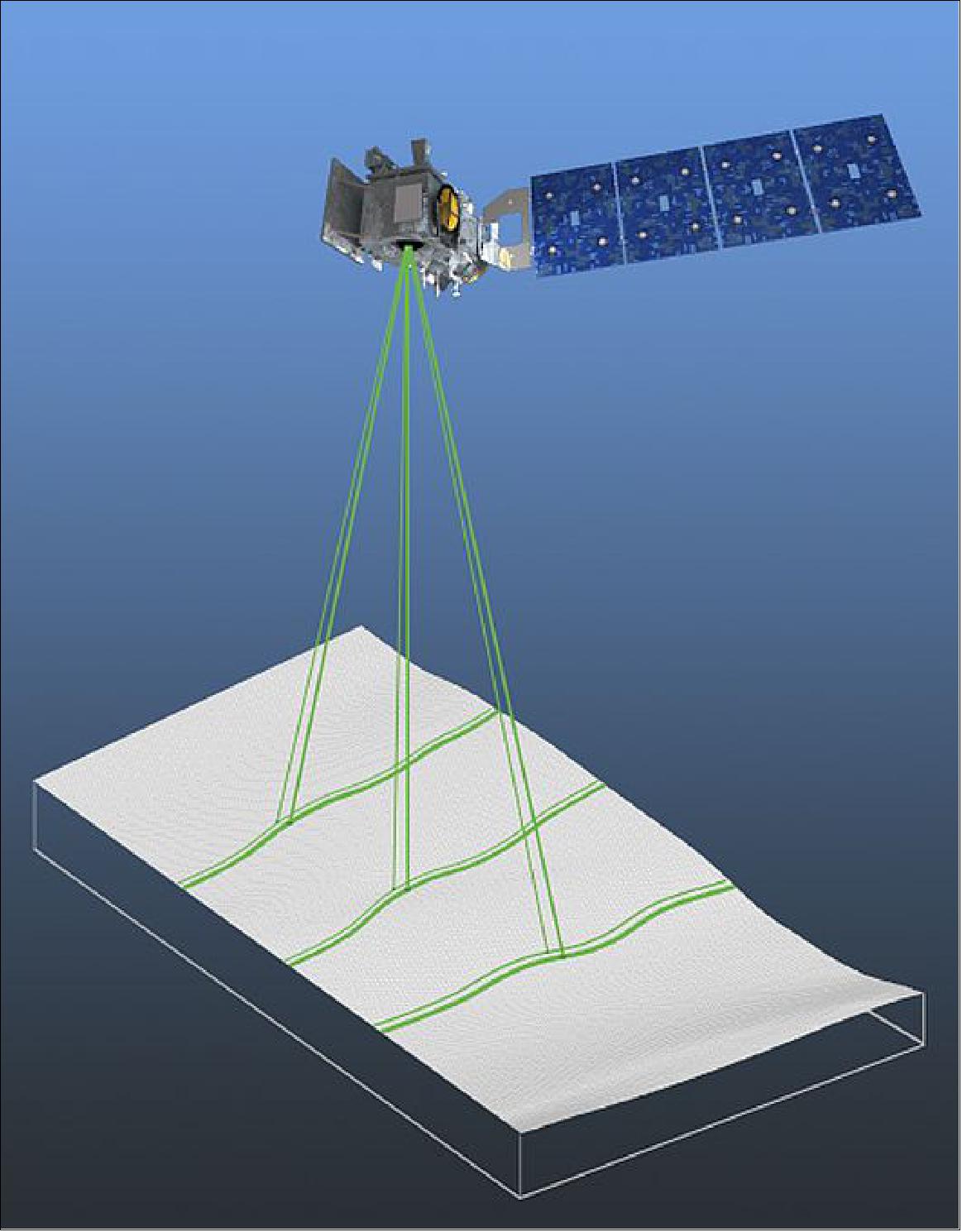
Figure 36: Measurement concept of the ATLAS instrument (image credit: NASA)
In contrast to the first ICESat mission, ICESat-2 will use micro-pulse multi-beam photon counting approach to provide:
- Dense cross-track sampling to resolve surface slopes on an orbit basis
- High repetition rate (10 kHz) generates dense along-track sampling (~70 cm)
- Different beam energies to provide necessary dynamic range (bright / dark surfaces)
The advantages are:
- Improved elevation estimates over high slope areas and very rough (e.g. crevassed) areas
- Improved lead detection for sea ice freeboard.
The ATLAS instrument is a multi-beam micropulse laser altimeter with the following features:
• Single laser beam split into 9 beams
• 10 m ground footprints
• 10 kHz repetition rate laser (~1 mJ)
• Multiple detector pixels per spot
• On-board boresight alignment system
• LRS (Laser Reference System) gives absolute laser pointing knowledge.
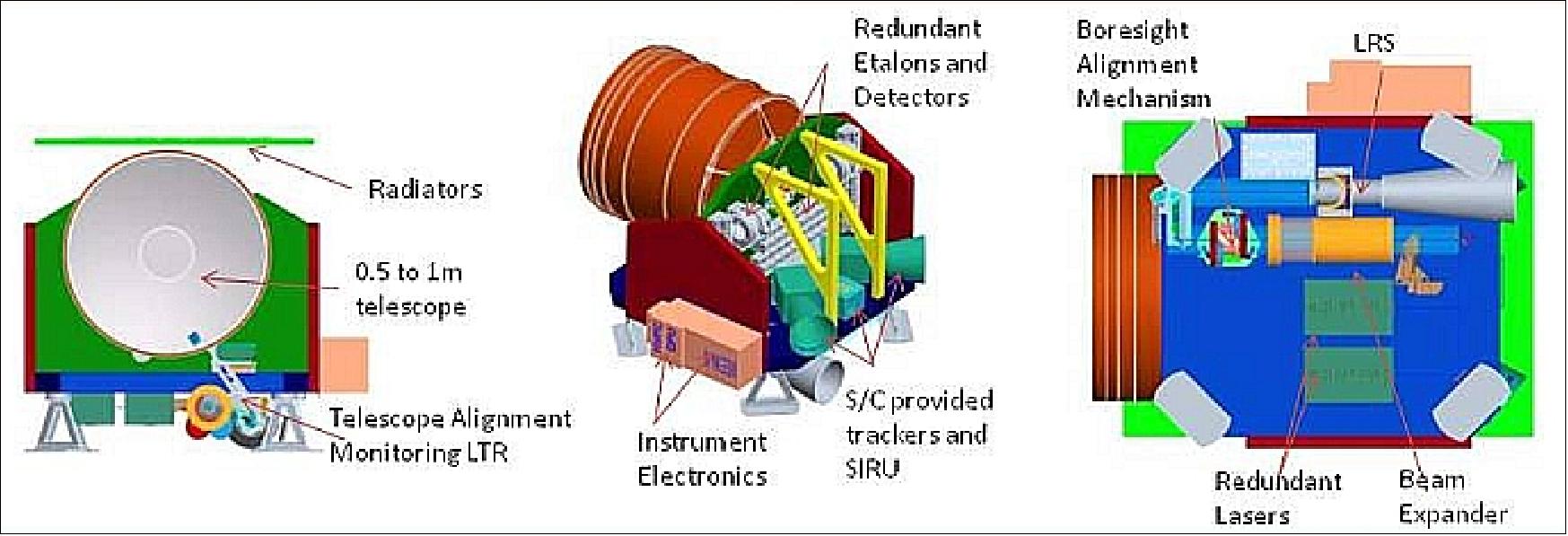
Figure 37: Schematic of the ATLAS instrument (image credit: NASA)
ATLAS will employ a micropulse laser transmitter frequency doubled to 532 nm (visible green) with a 1 ns FWHM pulse width and operating at a 10 kHz repetition rate (0.7 m along-profile footprint sampling). A narrow 20 µrad beam divergence from a 500 km orbit altitude will yield 10 m diameter footprints. To improve spatial sampling ATLAS will employ a DOE (Diffractive Optic Element) that will split the single transmit beam into 6 beams, creating a pattern consisting of 3 sets of 2 closely spaced (< 100 m) beams. The closely-spaced beam pairs will resolve local slope, enabling determination of real elevation change from a single repeat of a reference track (Ref. 4).
With ICESat-2 operating in a 91 day repeat orbit and ATLAS operating continuously, seasonal observations of inter-annual ice sheet elevation change will be possible. The beam pairs will be separated cross-track by 3 km, providing improved spatial coverage as compared to that of ICESat. Over land, rather than repeating reference tracks, spacecraft pointing will be used to systematically displace the profiles cross-track through time in order to build up dense global sampling of topography and vegetation over the course of the mission.
In the traditional analog Si:APD detection approach used by GLAS of ICESat-1, thousands of photons reflected from the Earth’s surface were acquired per laser fire (for clear atmospheric conditions) in order to obtain waveforms with sufficient SNR to achieve the 3 cm ranging precision. In the ATLAS micropulse approach the transmit pulse energy will be significantly lower such that only a few to ~10 photons will be detected per footprint per laser fire using a 0.8 m diameter telescope and photon-sensitive Photomultiplier Tube (PMT) detector arrays. Laser fire times and the arrival time of each photon, those reflected from the surface as well as from solar background noise, will be time tagged with 0.15 ns precision yielding < 20 cm single-photon range precision. Post-processing on the ground will yield “point clouds” of geolocated single photon surface returns. An advantage of this approach is that the combination of small, oversampled footprints, narrow pulse width and high-precision timing can yield elevation data of higher spatial and vertical resolution. In addition the geospatial information content of the point cloud is amenable to a greater diversity of analysis approaches than afforded by analog waveforms, opening up possibilities for new ways to characterize the vertical structure of the Earth’s surface (Ref. 4).
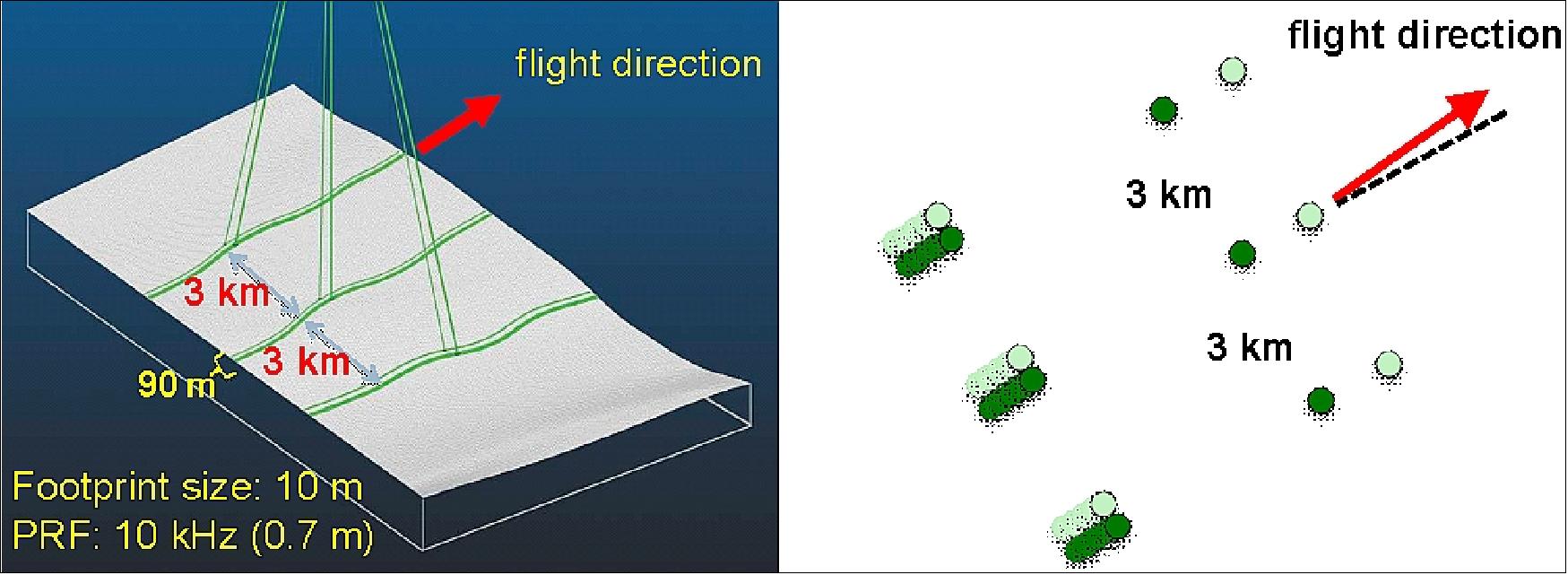
Figure 38: Schematic view of the ATLAS measurement concept (image credit: NASA) 79)
Legend to Figure 38: Single laser pulse, split into 6 beams. Redundant lasers, redundant detectors.
ATLAS carries two lasers on the optical bench – one primary and one backup. The laser light is at 532 nm, a bright green on the visible spectrum. It is fast-firing, sending 10,000 laser light pulses per second. 80)
The first step on the laser’s path to the ground is just a few inches past the laser, where a fold mirror directs the light 90º around a corner, where it hits the first key component, the PBC (Polarizing Beam Combiner). The PBC has two functions: The first is to make sure that the primary and backup lasers head down the same path. Although the two lasers won’t fire at the same time, the laser beams begin at different positions and need to end up at the same place. The second function is to use a periscope to pick off a fraction of the laser light and direct it to the LSA (Laser Sampling Assembly).
At the LSA, one of these fibers starts the ’stopwatch’ for that photon pulse. This timing component has to be incredibly precise to get the measurements that scientists need – when a photon returns, its travel time is recorded to the billionth of a second. The LSA also uses the small fraction of the laser to measure the laser’s wavelength, ensuring it remains precisely at 532.272 nm. This specific shade of bright green is what the filters on the receiving telescope let pass through to stop the stopwatch, once the laser pulse completes its journey. Any other wavelength gets filtered out as background noise. As the LSA starts the timer, the rest of the laser pulse continues to the BE (Beam Expander).
Shaping and steering the beam: The BE consists of two mirrors, facing each other but slightly angled so that the laser hits one, bounces across to the second one, and then continues on in the same direction. These mirrors are curved to make the laser beam more than four times wider once it bounces off them. Making the beam wider actually makes the photons diverge less as they travel to Earth, tightening the laser footprint on the ground and allowing for a more precise map of surface heights.
"The spot diameter on Earth’s surface would have been 66 m, now it’s 15 m," according to Ramos-Izquierdo. "By making the laser beam bigger in diameter before exiting the instrument, we actually decrease how much it spreads as it propagates downward through the atmosphere."
The wider laser beam now goes through the BSM (Beam Steering Mechanism), which directs the laser at the ground below, but also has fine control over where the laser is pointing. This mechanism is connected with components on the instrument's telescope receiver, which collects any photons that return. The goal is to automatically point the lasers at the exact spot on the ground, where the telescope is observing. If the telescope and laser are pointed at different spots, the BSM will make slight adjustments to correct the alignment. The BSM is key because as the satellite goes in and out of the sun, changes in temperature could slightly warp the optical bench.
Split in six: The last hurdle for the laser beam is the DOE (Diffractive Optic Element), on the far side of the beam steering mechanism. This optical component is etched with a microscopic pattern of crisscrossed lines, which splits the single laser beam into six. The beams are set at slightly different angles, so they will cover the ground in a specific formation of three pairs of beams.
Once through the Diffractive Optic Element, the photons – lined up perfectly in six beams – are off on their journey to Earth.
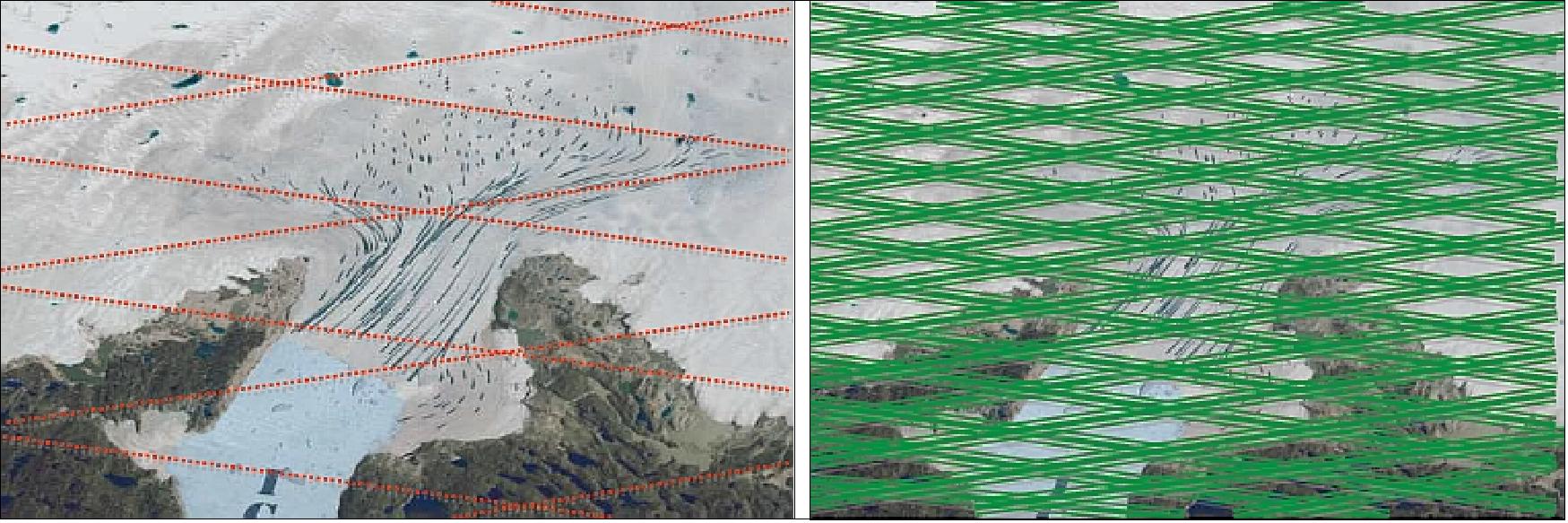
Figure 39: ICESat-1 observation spacing at Jakobshavn Isbræ (left) and planned ICESat-2 spacing overlay (right), (image credit: NASA, Ref. 6)
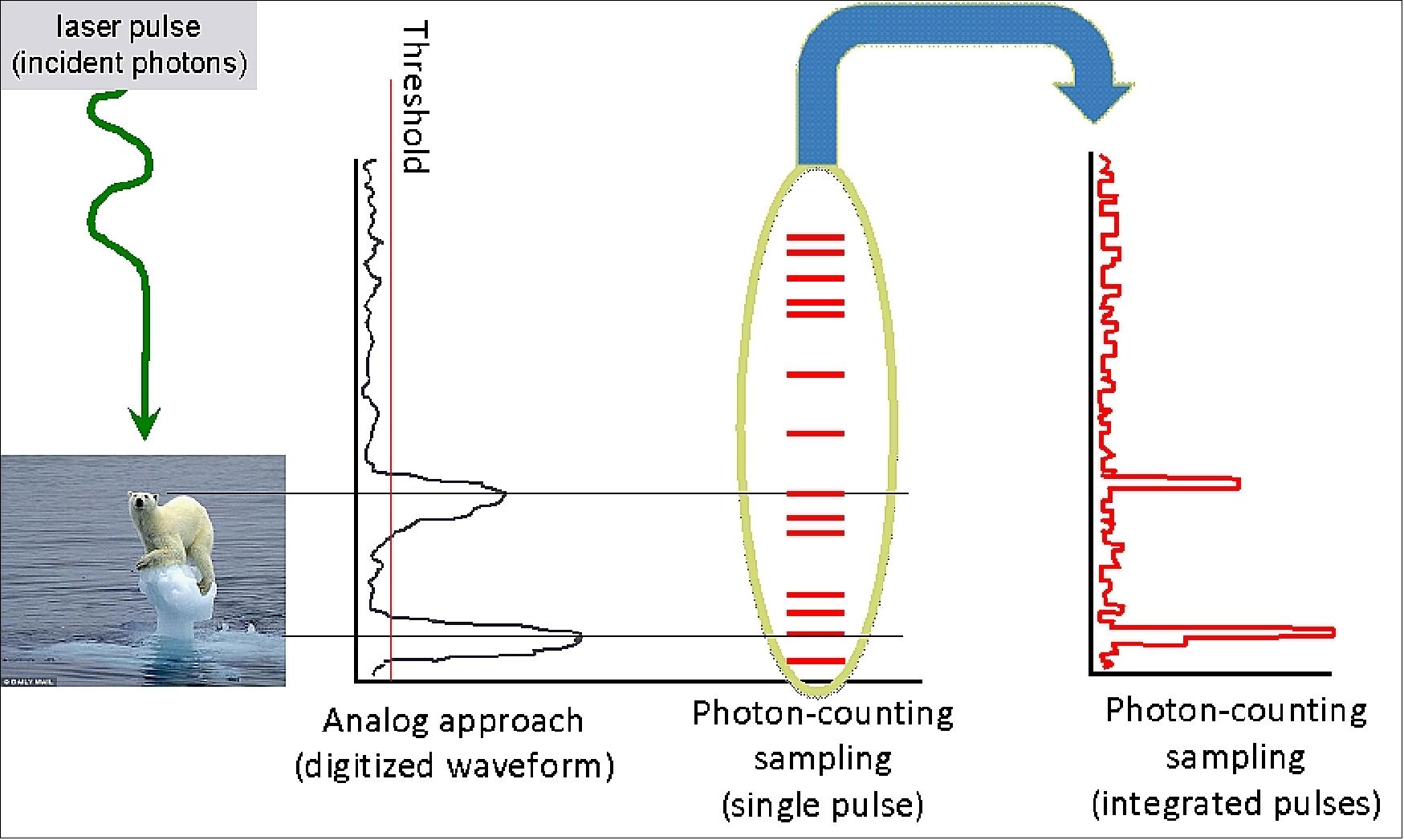
Figure 40: Schematic of analog versus photon counting. It is important to note that the integrated photon-counting sample (“histogram”) looks like the analog wave - but it is not - the information content is different, and the method of analyzing the data is different. (image credit: NASA)
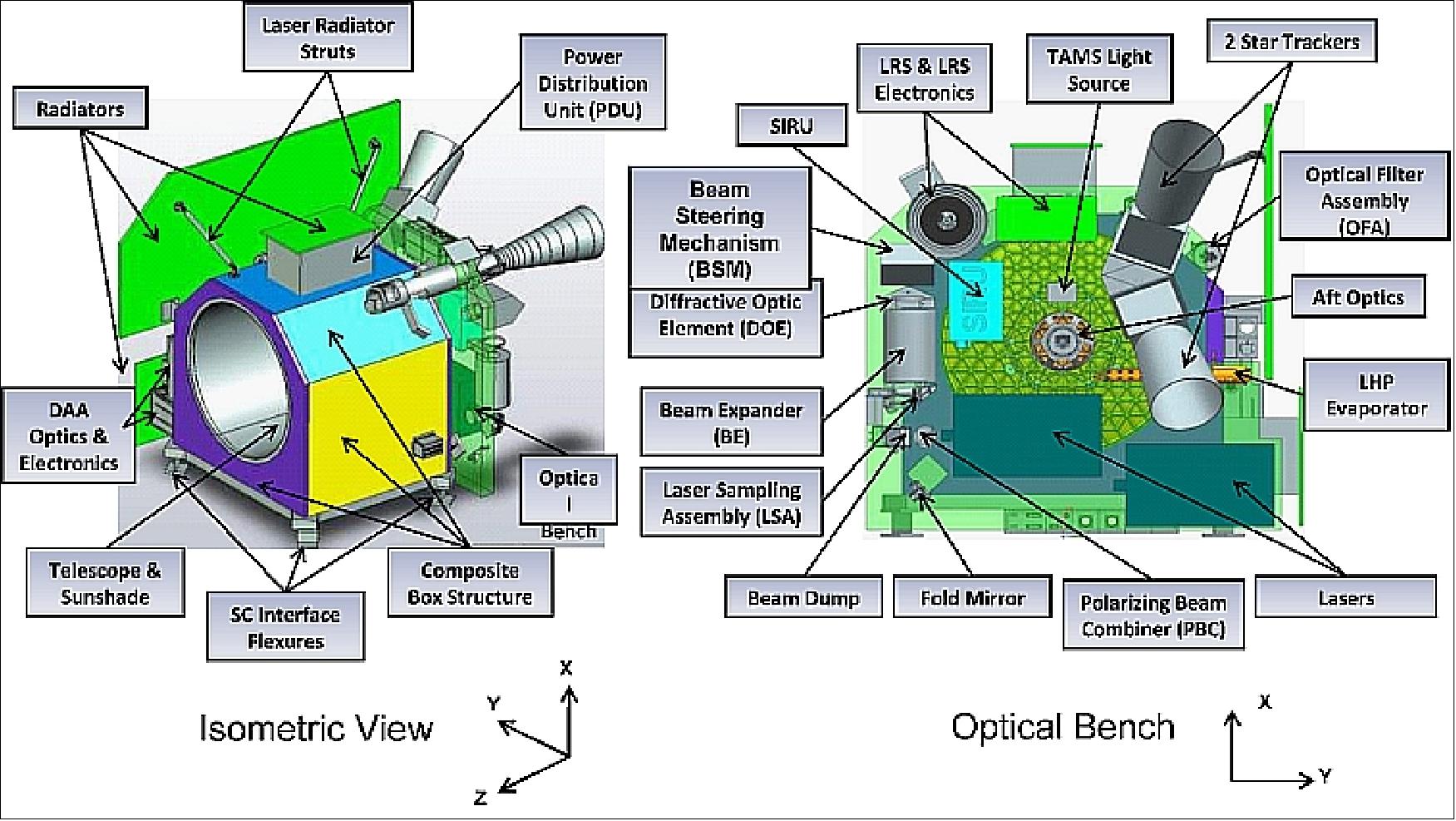
Figure 41: Overview of the ATLAS instrument (image credit: NASA)
Table 2: Current laser transmitter performance requirements for the ICESat-2 micropulse laser altimeter system
| Pulse energy, pulse width | 2 mJ, < 1.5 ns |
|---|---|
| PRF (Pulse Repetition Frequency) | 10 kHz (± 0.2 kHz) |
| Center wavelength | 1020 - 1080 nm |
| Wavelength stability/linewidth | < 60 pm |
| PER (Polarization Extinction Ratio), polarization orientation | > 100:1, ± 1º |
| Spatial mode | M2 < 1.6 |
| Pointing stability (shot-to-shot), Pointing stability (long-term) | < 10% of divergence, < 20% of divergence |
| Lifetime | > 5 years |
| Operating temperature, operating survival temperature | ± 1ºC of design wavelength, 10 – 40ºC |
| Non-operating survival temperature | 0 – 50ºC |
| Design goals | |
| Mass, volume, efficiency (wall plug) | < 10 kg, < 40 cm x 25 cm x 15 cm, > 15% |
Laser transmitter: The ATLAS laser represents a significant jump in space qualified laser technology (short pulse width, moderate average powers, frequency tunable and laser shot count). The ATLAS instrument is required to run continuously for 3 years on-orbit and the required laser shot count (~1 trillion) is ~3 orders of magnitude greater than in any previous NASA spaceflight mission. 81)
Fibertek Inc of Herndon, VA delivered three laser transmitters, including the one shown in Figure 42, that meet the demanding performance and reliability requirements for the ATLAS instrument, including two flight units and one spare. The lasers consists of two major sub-assemblies. The LOM (Laser Optical Module) is a sealed and pressurized module housing all of the optical components and laser diode modules. The LEM (Laser Electronics Module) is integrated to the LOM and is a vented module housing the laser power and command and control electronics.
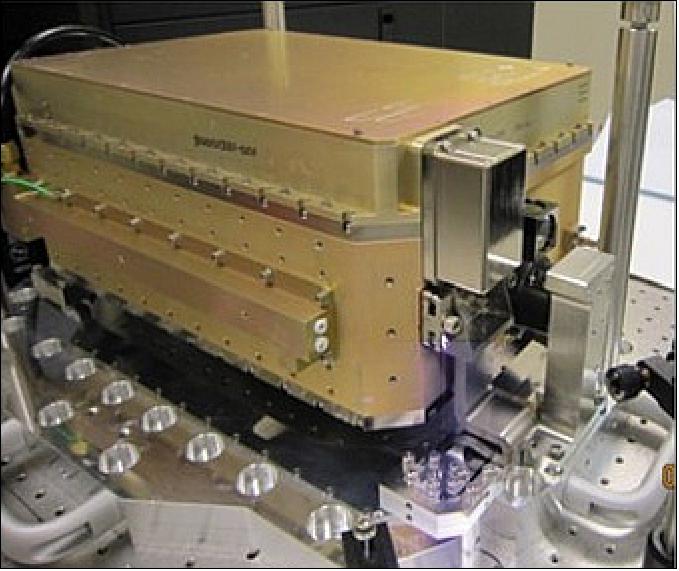
Figure 42: The ATLAS laser system (image credit: Fibertek)
LOM (Laser Optical Module): A mature diode pumped solid Master Oscillator Power Amplifier (MOPA) architecture was selected in order to minimize schedule, cost and technical risks. End-pumped crystals gain heads are used in the oscillator and three subsequent amplifiers. The end-pumped gain heads are designed with methodology similar to mature geometries used broadly in commercial laser systems.
The master oscillator generates 200 µJ infrared pulses with <1.5 ns full width half max pulse widths with narrow (< 5 pm) linewidth tunable over a >50 pm wavelength range. The oscillator’s output is amplified via three stages to more than 1.8 mJ at 10 kHz pulse repetition frequency while preserving the near diffraction-limited beam quality (M2 < 1.4) and short pulse widths of the oscillator output. The 1064 nm amplifier output is frequency doubled to 532 nm via a critically phased matched lithium triborate (LBO) crystal.
The ATLAS lasers generate 532 nm output pulses with user-selectable energies from 250 µJ to 1.2 mJ with near-diffraction limited beam quality and < 1.5 ns pulse widths. Additional system design details have been previously published.
The ATLAS lasers systems successfully completed a protoflight qualification program including electromagnetic interference testing, vibration testing and thermal vacuum testing, specific testing details are published . In addition, three early system prototypes completed >25,000 hour life tests demonstrating the laser design was capable of meeting the mission operational run time requirement. A summary of the key laser requirements and achieved performance is listed in Table 3.
Table 3: Key laser requirements and performance
| Parameter | Requirement | Flight Lasers |
|---|---|---|
| Energy (µJ) | 250-900 | 250-1,370 |
| Pulse rate (kHz) | 10 | 10 |
| Divergence (µrad) | <130 | 91 |
| Wavelength (nm) | 532.272 | 532.272 |
| Linewidth (pm) | <30 | <5 |
| Efficiency | >5% | 8.2% |
| Operational run-time | 3.5 years (>1 trillion shots) | Prototype systems (>1 trillion shots) |
LEM (Laser Electronics Module): The electronic design was started early in the program mitigating design surprises and long lead Electrical, Electronic and Electromechanical (EEE) part procurement schedules. The integrated ATLAS electronics included the following major electronic boards.
Laser Control Board: Provides high speed communications with the payload, to monitor numerous laser health and diagnostic sensors (14 temperature sensors, four internal energy monitors, two pressure sensors, other housekeeping telemetry) while providing the critical timing parameters needed for a laser capable of 12 user selectable energy modes.
Diode Power Module: A custom high efficiency (>87%) DC-DC converter purpose built to provide power conditioning to four custom pulsed diode drivers.
Pulsed Diode Driver: Four pulsed diode drivers generating the programmable current waveforms with a peak current of 4 A, ~28 VDC at 10 kHz with µs class rise and fall times, and 85% efficiency.
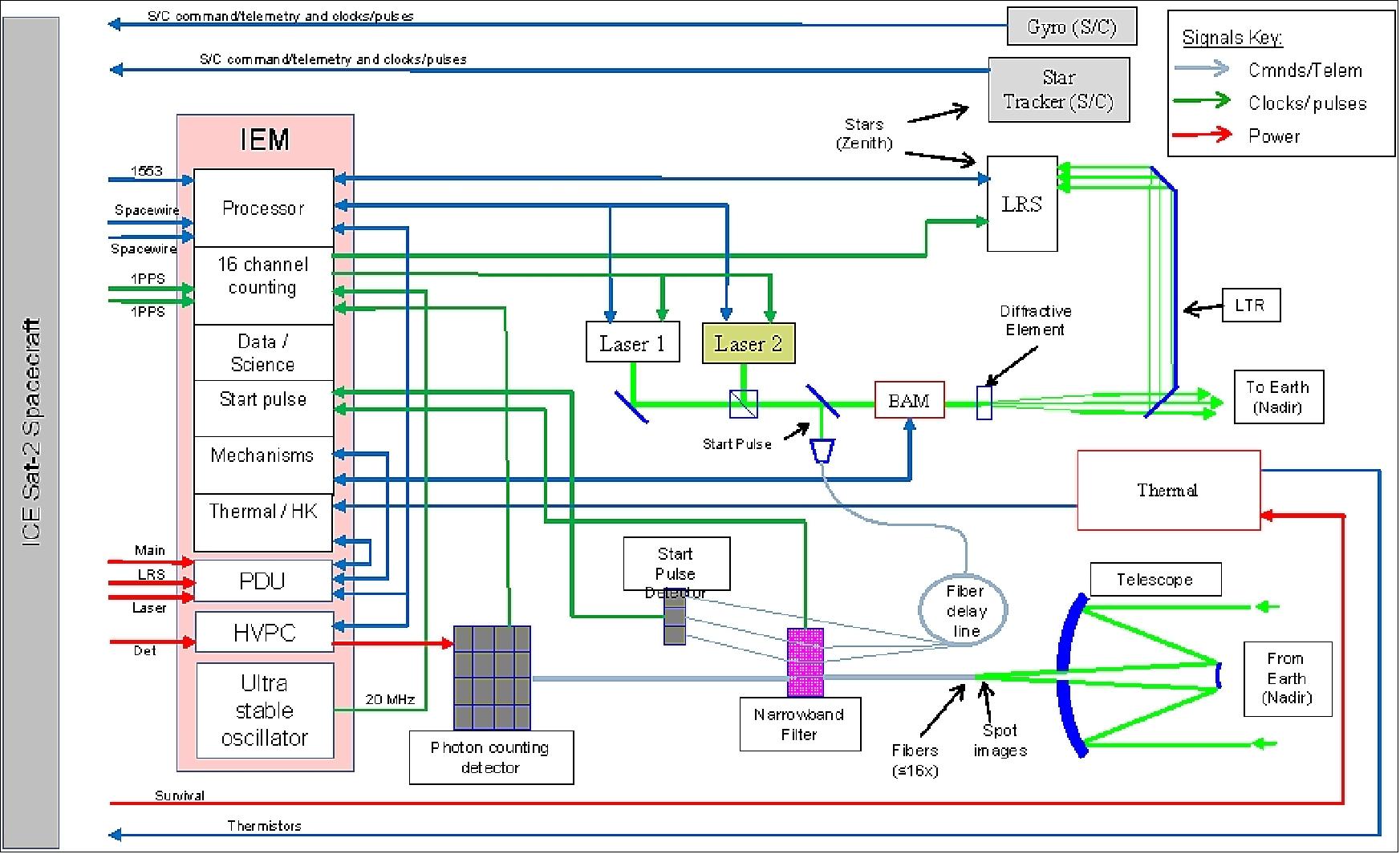
Figure 43: Block diagram of the ATLAS instrument (image credit: NASA)
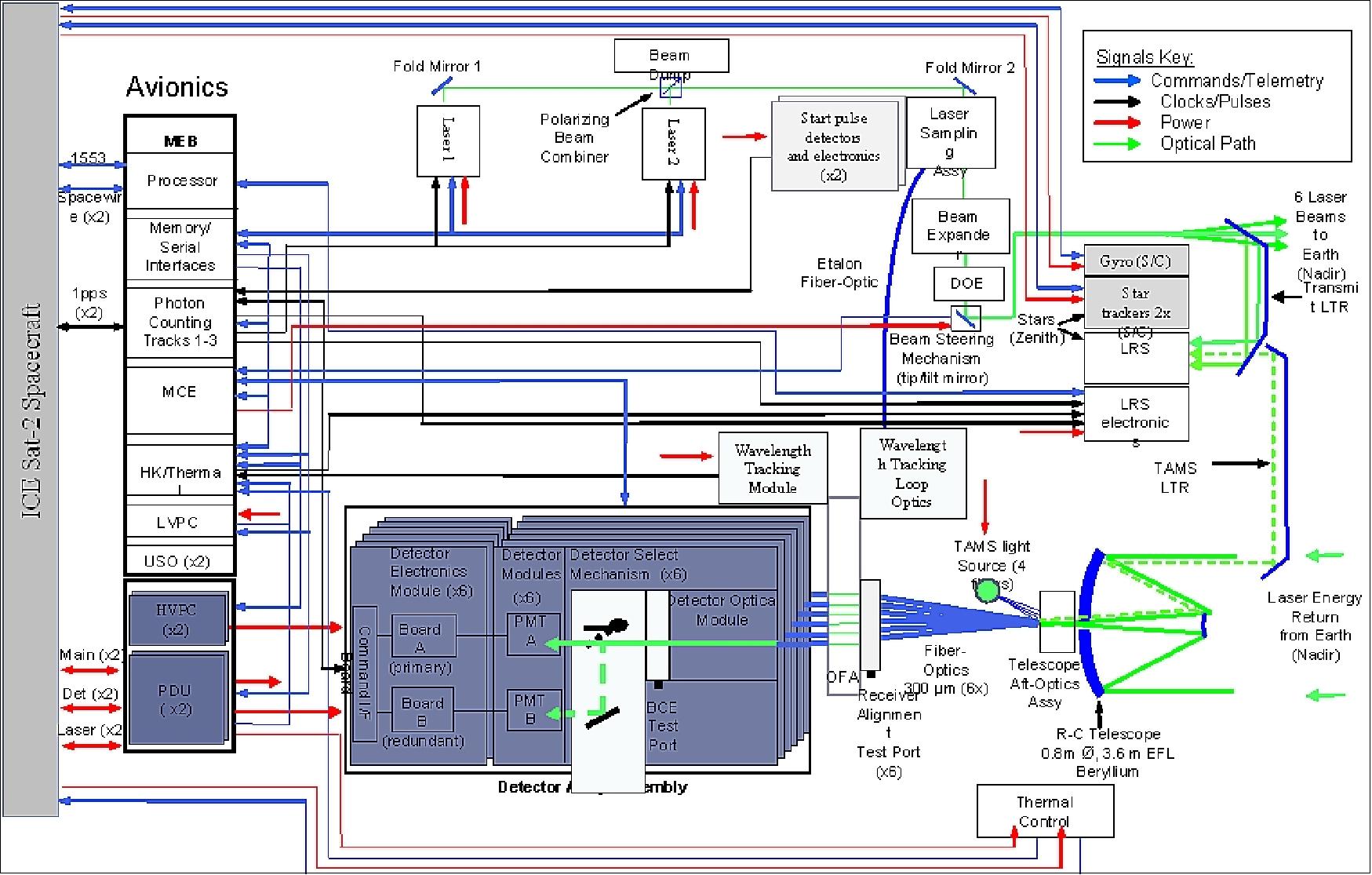
Figure 44: ATLAS functional block diagram (image credit: NASA)
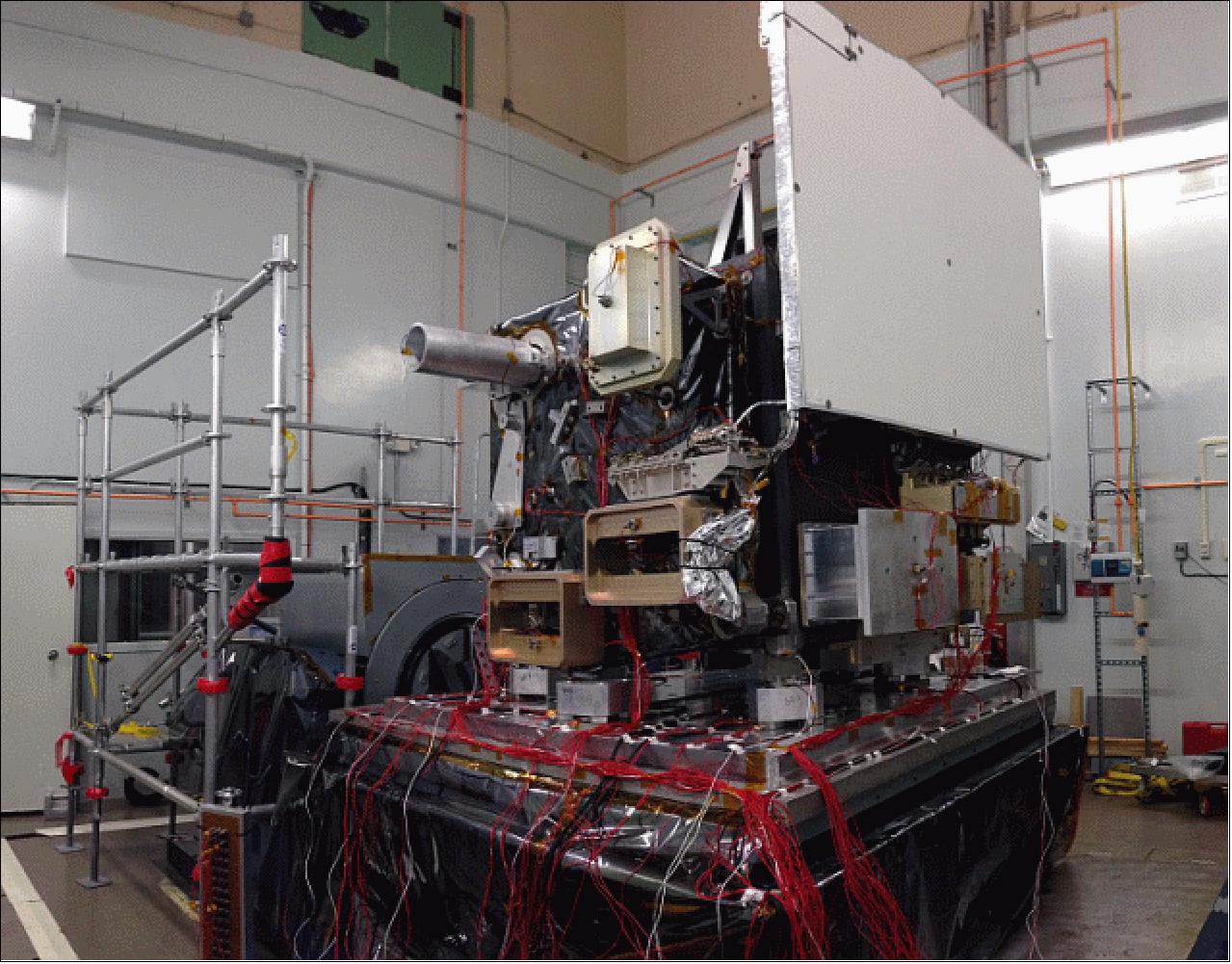
Figure 45: The ATLAS box structure, in preparation for its vibration tests at NASA/GSFC, which will ensure the box can withstand the jolts of launch (image credit: NASA, Ref. 77)
The ATLAS instrument has a mass of 298 kg and a power consumption of 300 W.
Ground Segment
Just as with the original ICESat data, ICESat-2 measurements are expected to provide added value to science and applications beyond their primary purpose. NASA’s Applied Sciences Program actively seeks to connect NASA’s Earth-observing satellite data to societal applications and encourages each mission to come up with a plan to connect its science to user needs. To that end, the ICESat-2 mission established an ICESat-2 Applications Team to organize and develop a mission applications program that will help establish these vital links between ICESat-2 science and society.
With guidance from the Applications Team, ICESat-2 has developed and implemented a diverse range of mission-specific prelaunch applications activities and strategies for engaging end users. These activities are modeled after the highly successful application strategies implemented for NASA’s SMAP (Soil Moisture Active/Passive) mission and are intended to provide a fundamental understanding of how ICESat-2’s data products can be best integrated into operational procedures to improve decision-making efforts across multiple disciplines. 82)
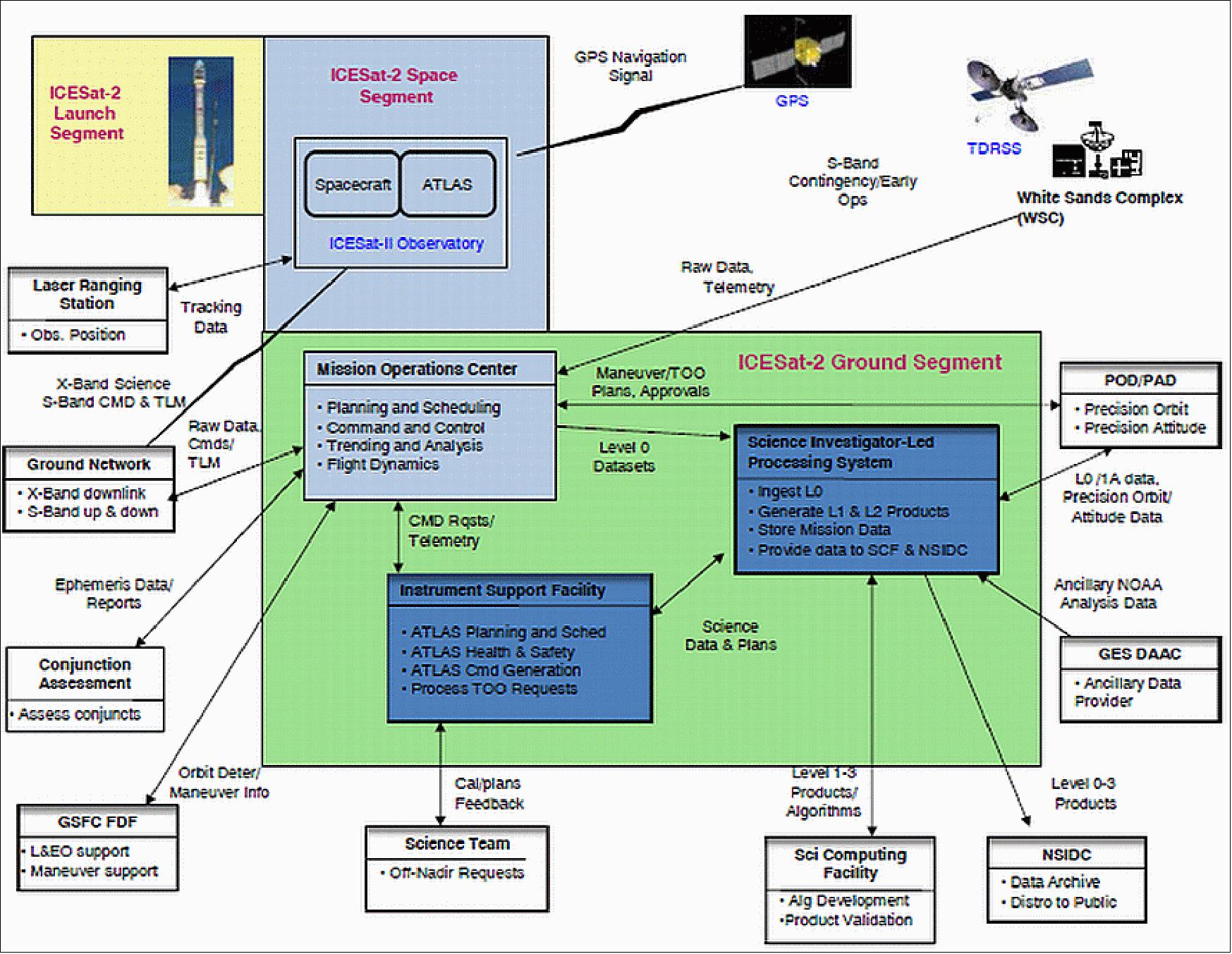
Figure 46: Overview of ICESat-2 elements in the ground segment (image credit: NASA)
Table 4: ICESat-2 science data products. The rows are shaded light gray to dark gray to represent Level 0 (light gray), Level 1, Level 2, and Level 3 (dark gray) data products. The ICEsat-2 mission will not have a Level 4 (value-added-model) product.
| Product No | Product Name | Short Description | Latency |
|---|---|---|---|
| ATL00 | Telemetry Data | Raw ATLAS telemetry in packet format. | Downlinked 8 times/day |
| ATL01 | Reformatted Telemetry | Parsed, partially reformatted into HDF5, and generated daily. Segmented into several-minute granules. | 2 days |
| ATL02 | Science Unit Converted Telemetry | Photon time-of-flight, corrected for instrument effects. Includes all photons, pointing data, spacecraft position, housekeeping data, engineering data, and raw atmospheric profiles. Segmented into several-minute granules. | 2 days |
| ATL03 | Global Geolocated Photon Data | Precise latitude, longitude, and elevation for every received photon, arranged by beam in the along-track direction. Photons classified by signal vs. background, as well as by surface type (i.e., land ice, sea ice, land, ocean), including all geophysical corrections (e.g., Earth tides, atmospheric delay). Segmented into several-minute granules. | 21 days |
| ATL04 | Calibrated Backscatter Profiles | Along-track atmospheric backscatter data —25 times per second. Includes calibration coefficients for polar regions. Segmented into several-minute granules. | 21 days |
| ATL06 | Land Ice Height | Surface height for each beam with along- and across-track slopes calculated for each beam pair. Posted at 40 m along-track; segmented into several-minute granules. | 45 days |
| ATL07 | Arctic/Antarctic Sea Ice Elevation | Height of sea ice and open water leads at varying length scale based on returned photon rate for each beam—pre-sented along-track. | 45 days |
| ATL08 | Land Water Vegetation Elevation | Height of ground—including canopy surface—posted at fixed-length scale, for each beam presented along-track. Where data permit, include canopy height, canopy cover percentage, surface slope and roughness, and apparent reflectance. | 45 days |
| ATL09 | ATLAS Atmosphere Cloud Layer Characteristics | Along-track cloud and other significant atmosphere layer heights, blowing snow, integrated backscatter, and opti-cal depth. | 45 days |
| ATL10 | Arctic/Antarctic Sea Ice Freeboard | Estimate of sea ice freeboard over specific spatial scales using all available sea surface height measurements. Contains statistics of sea surface and sea ice heights. | 45 days |
| ATL11 | Antarctica/Greenland Ice Sheet H(t) Series | Time series of height at points on the ice sheet—calculated based on repeat tracks and/or crossovers. | 45 days from receipt of last data in product |
| ATL12 | Ocean Elevation | Surface height at specific length scale. Where data permit, include estimates of height distribution, roughness, surface slope, and apparent reflectance. | 45 days from receipt of last data in product |
| ATL13 | Inland Water Elevation | Along-track inland water elevation based on specific inland water mask. Where data permit, include roughness, slope, and aspect. | 45 days from receipt of last data in product |
| ATL14 | Antarctica/Greenland Ice Sheet H(t) Gridded | Height maps of each ice sheet for each year, based on all available elevation data. | 45 days from receipt of last data in product |
| ATL15 | Antarctica/Greenland Ice Sheet dh/dt Gridded | Height change maps for each ice sheet, for each mission year, and for the whole mission. | 45 days from receipt of last data in product |
| ALT16 | ATLAS Atmosphere Weekly | Polar cloud fraction, blowing snow frequency, and ground detection frequency. | 45 days from receipt of last data in product |
| ATL17 | ATLAS Atmosphere Monthly | Polar cloud fraction, blowing snow frequency, and ground detection frequency. | 45 days from receipt of last data in product |
| ATL18 | Land/Canopy Gridded | Gridded ground surface height, canopy height, and canopy cover estimates. | 45 days from receipt of last data in product |
| ATL19 | Mean Sea Surface (MSS) | Gridded ocean height product. | 45 days from receipt of last data in product |
| ATL20 | Arctic/Antarctic Gridded Sea Ice Freeboard | Gridded sea ice freeboard. | 45 days from receipt of last data in product |
| ATL21 | Arctic/Antarctic Gridded Sea Surface Height within Sea Ice | Gridded monthly sea surface height inside the sea ice cover. | 45 days from receipt of last data in product |
ICESat-2 Preparatory Campaigns
NASA Operation IceBridge Campaign in Antarctica 2018
• October 23, 2018: Operation IceBridge, NASA’s longest-running aerial survey of polar ice, flew over the northern Antarctic Peninsula on Oct. 16, 2018. During the survey, designed to assess changes in the ice height of several glaciers draining into the Larsen A, B and C embayments, IceBridge senior support scientist Jeremy Harbeck spotted a very sharp-angled, tabular iceberg floating among sea ice just off of the Larsen C ice shelf. A photo of the iceberg (seen at right) was widely shared after it was posted on social media. 83)
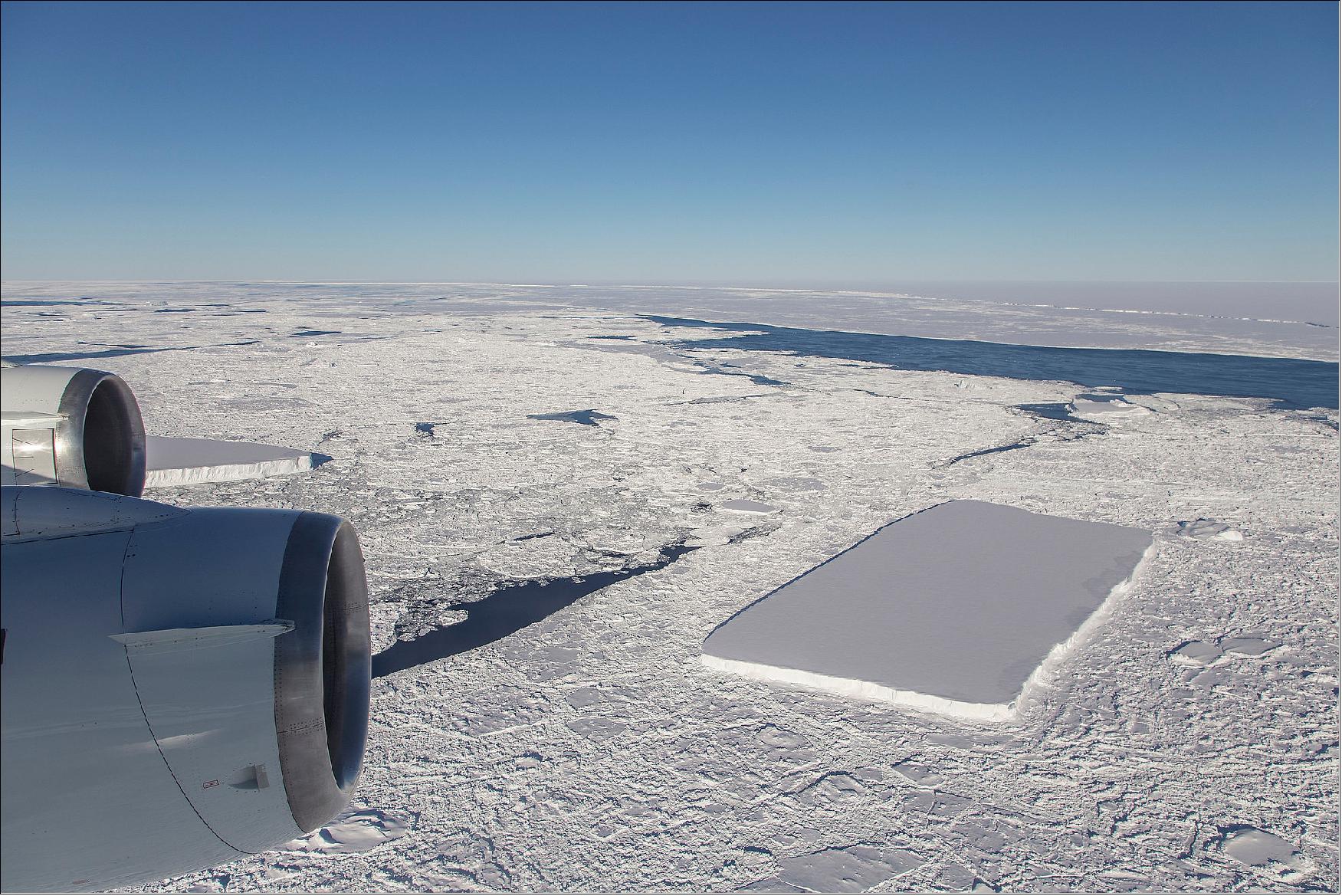
Figure 47: Two rectangular Icebergs spotted on NASA IceBridge flight (image credit: NASA/Jeremy Harbeck)
“I thought it was pretty interesting; I often see icebergs with relatively straight edges, but I've not really seen one before with two corners at such right angles like this one had,” Harbeck said. The rectangular iceberg appeared to be freshly calved from Larsen C, which in July 2017 released the massive A68 iceberg, a chunk of ice about the size of the state of Delaware.
• October 12, 2018: NASA’s decade-long airborne survey of polar ice, Operation IceBridge, is once again probing Antarctica. But this year is different: it is the first time that the IceBridge team and instruments survey the frozen continent while NASA’s newest satellite mission, the Ice, Cloud and land Elevation Satellite-2 (ICESat-2), studies it from space. 84)
After successfully flying over the Bailey Ice Stream and Slessor Glacier in East Antarctica on 10 October, IceBridge will spend the next five weeks measuring changes in Antarctic sea and land ice while precisely flying under orbits of ICESat-2 to compare measurements.
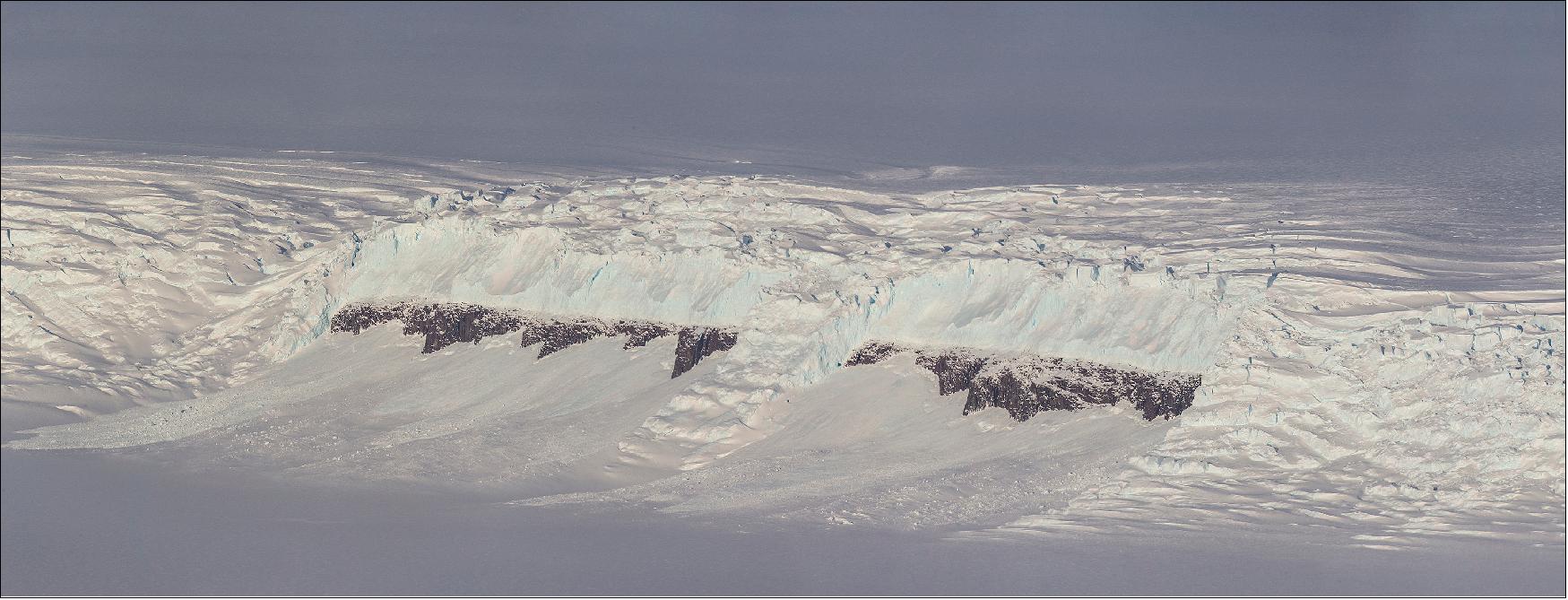
Figure 48: An icefall along the edge of Bailey Ice Stream in East Antarctica, as seen during an Operation IceBridge flight on 10 October 2018 (image credit: NASA/Jeremy Harbeck)
IceBridge began flying in 2009 to maintain continuity of laser-altimetry measurements between NASA’s ICESat missions. The original ICESat mission ended in 2009, and its successor, ICESat-2, was launched on 15 September 2018. Since then, ICESat-2 has successfully collected its first height measurements across the Antarctic Ice Sheet on 3 October.
“After a decade of flying both poles every year, we’re finally bridging the two ICESat satellite missions,” said Joe MacGregor, IceBridge’s project scientist and a glaciologist at NASA’s Goddard Space Flight Center in Greenbelt, Maryland. “It’s hugely satisfying to be part of building this key observational record of change in the polar regions.”
“This campaign is our second-to-last Antarctic campaign and it is arguably the most scientifically diverse that IceBridge has ever done,” MacGregor said. “We’re going to be revisiting classic IceBridge targets: flights along glacier flowlines that have been surveyed since 2002, long-term sea ice flights, and new targets across West Antarctica. More than two dozen of these mission designs are relevant to both IceBridge and ICESat-2.”
IceBridge and ICESat-2 both use laser altimeters that fire pulses of light toward the ground and measure how long it takes for that light to bounce off the ice and return to the instruments’ sensors. Scientists can then calculate the distance between the aircraft or the satellite and the ice surface, which gives them the ice height.
When IceBridge flies along a track over Antarctica that ICESat-2 has either just or is about to pass over as it orbits in space, pilots will align the plane so that the swath fired by IceBridge’s laser altimeter encompasses the tracks of two of ICESat-2’s six laser beams. Researchers will then look for overlap between the IceBridge and ICESat-2 returns and compare their measurements of ice height.
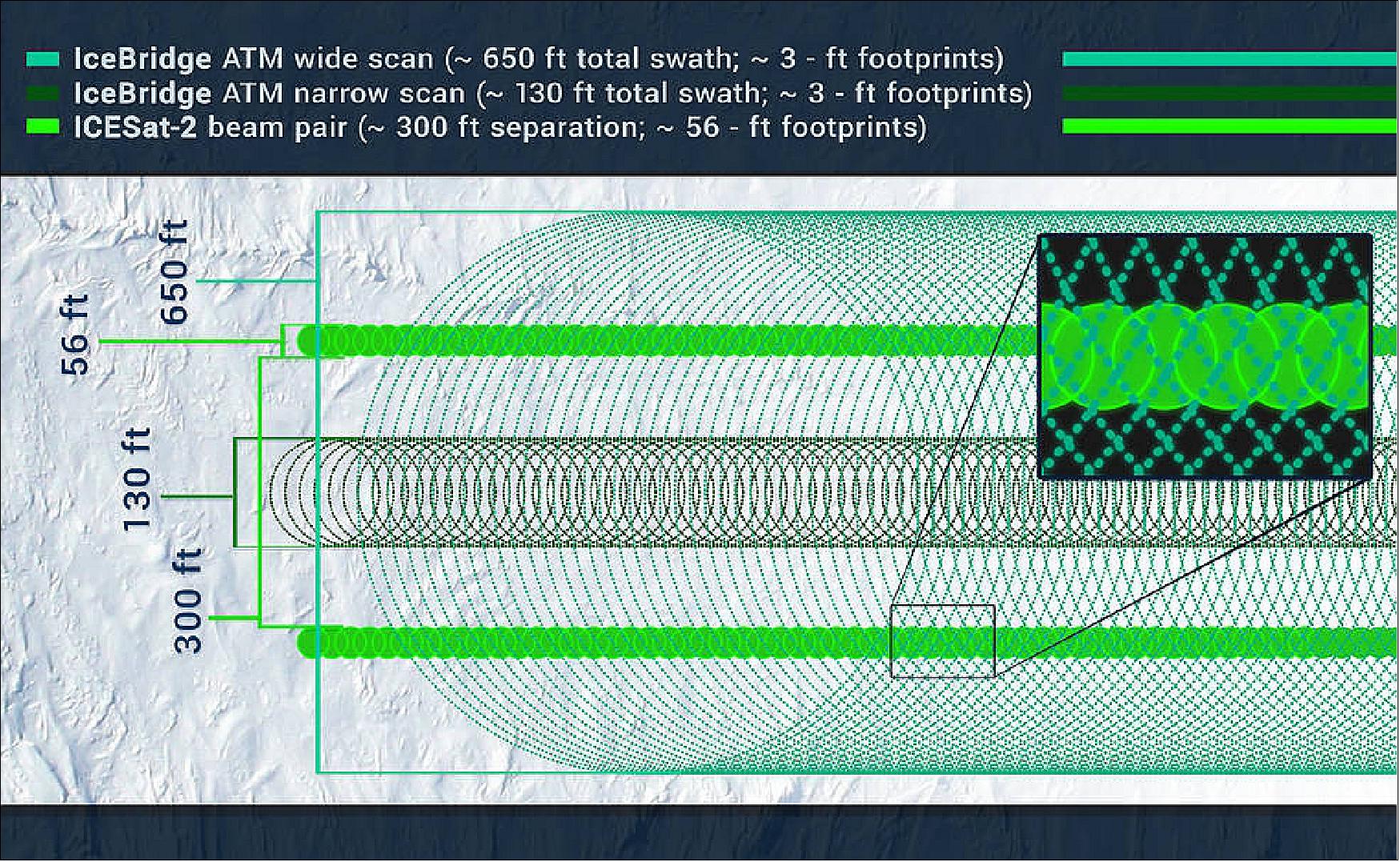
Figure 49: IceBridge’s ATM (Airborne Topographic Mapper) instrument has two lasers that shoot thousands of pulses of light per second in a circular motion that, combined with the plane’s forward motion, result in spiral patterns of height measurements over Earth’s surface. At the altitude that IceBridge typically conducts polar surveys, the lasers’ swaths are 650 feet (~ 200 m) and 130 feet wide (40 m), respectively. Each single measurement, or laser pulse, for either instrument has a 1m footprint on the ground. In contrast, ICESat-2 takes measurements following six unique lines on the ground, one for each of its laser beams. The footprint of each ICESat-2 laser pulse is about 56 feet (17 m) in diameter (image credit: NASA/Kelly Brunt, Adriana Manrique)
During this year’s Antarctic campaign, the IceBridge team will fly under some of ICESat-2’s orbits over sea and land ice. The underflights over sea ice to collect measurements of freeboard — the total height of the snow cover and sea ice that floats above the ocean — are particularly tricky. The ice that floats over the Southern Ocean is in constant motion, so in order to survey the same patches of sea ice that ICESat-2 will have flown over a few hours earlier or later that day, the IceBridge scientists will first have to figure out where that sea ice has drifted.
“We’re going to be chasing sea ice,” said Linette Boisvert, IceBridge’s deputy project scientist and a sea ice researcher at Goddard. “To do so, we will take the plane down to a lower altitude and remain there for a few seconds to measure wind speed and direction. We’ll plug these data into a code that accounts for drift and other forces, calculating where the sea ice that ICESat-2 flew over is currently located. Then, we’ll adjust our route to fly over it. On the way back to base, we’ll drop lower again to measure wind speed, readjust our trajectory and chase sea ice again.”
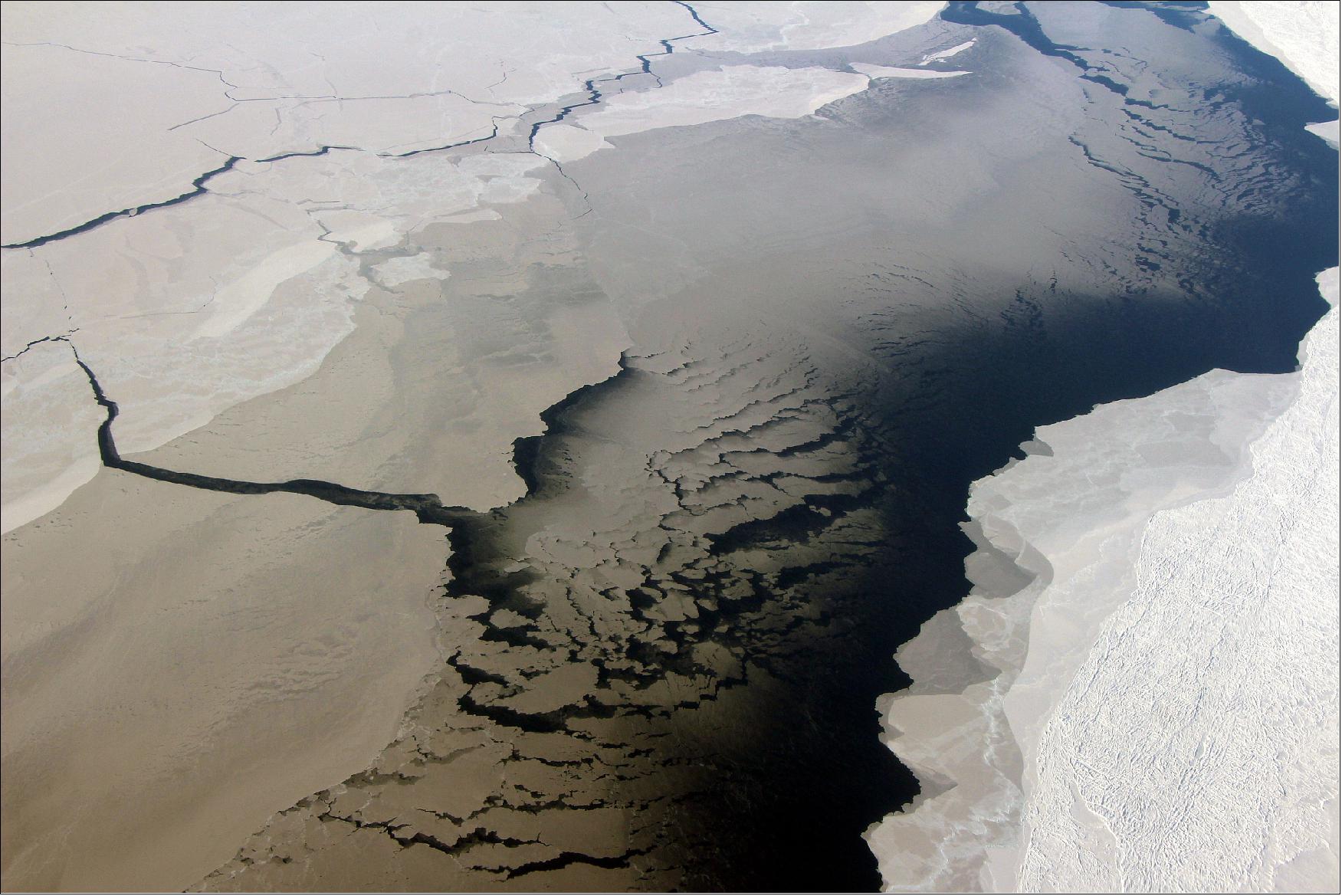
Figure 50: A coastal polynya, or opening in the sea ice cover, near the Filchner Ice Shelf in Antarctica, as seen during an Operation IceBridge flight on 10 October 2018 (image credit: NASA/John Sonntag)
Another modification to meet ICESat-2’s needs will be performing a sea ice survey at twilight. Normally, IceBridge only conducts its flights in broad daylight, but, since ICESat-2 will be taking measurements around the clock, the scientists want to check whether laser data are more accurate at low light, when there is less interference on the laser instrument’s sensors from the Sun.
While flying over Antarctica, IceBridge will also collaborate with satellite missions and international research groups as weather and time allow. During the sea ice surveys, the IceBridge plane may also fly under the tracks of ESA’s (European Space Agency) CryoSat-2 and the European Union’s Sentinel-3 satellites. During a survey flight over Thwaites Glacier, one of the fastest-changing glaciers in West Antarctica, IceBridge may collect seafloor measurements to support the International Thwaites Glacier Collaboration, a joint campaign between the United States and the United Kingdom.
This year, IceBridge flights to Antarctica will begin first from Punta Arenas, in southern Chile, and later from Ushuaia, in southern Argentina. The surveys will be conducted from NASA’s DC-8 airborne science laboratory. The plane, managed by NASA’s Armstrong Flight Research Center in Palmdale, California, carries IceBridge’s full instrument suite.
IceBridge’s main instrument is a dual-color laser altimeter from NASA's Wallops Flight Facility in Virginia that measures surface elevation by transmitting both infrared and green laser pulses. The airborne mission also uses two types of radar systems from the Center for Remote Sensing of Ice Sheets at the University of Kansas to study ice layers and Antarctica’s bedrock. Wallops also contributes a high-resolution camera to collect color images of the ice surface and infrared cameras to read surface temperatures of sea and land ice. Goddard provides a hyperspectral imager to the mission that takes measurements over hundreds of wavelengths and Columbia University in New York manages a gravimeter to map the seafloor underneath the ice shelves.
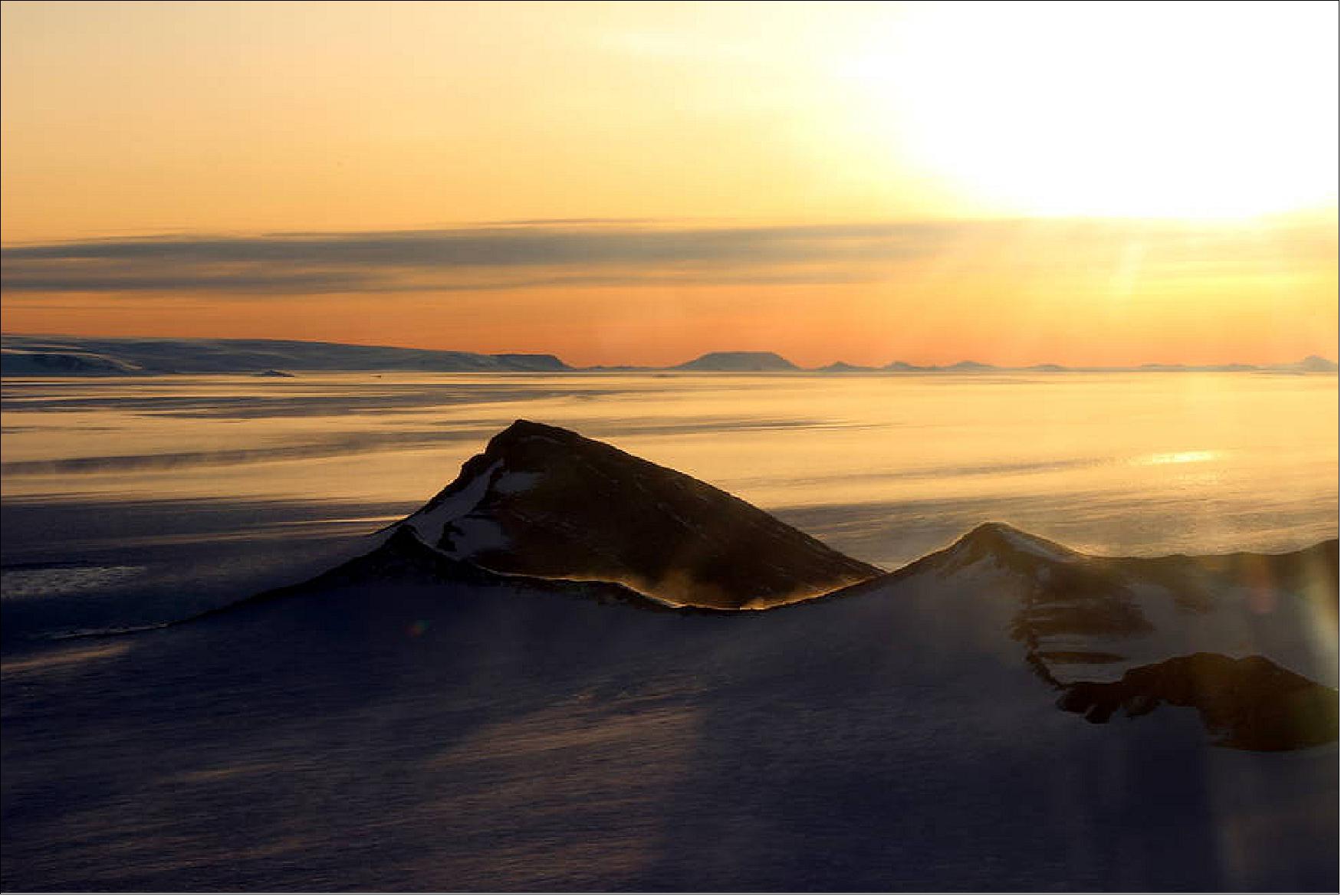
Figure 51: The Shackleton Range in Antarctica at sunset with snow blowing off the ridges, photographed during an Operation IceBridge flight on 10 October 2018 (image credits: NASA/Michael Studinger)
MABEL (Multiple Altimeter Beam Experimental Lidar)
MABEL is a high-altitude airborne laser altimeter designed as a simulator for ICESat-2. The MABEL design uses multiple beams at fixed angles and allows for local slope determination. The MABEL instrument was developed to: 85) 86)
enable the development of ICESat-2 geophysical algorithms prior to launch
provide detailed error analysis of the ATLAS measurement strategy
provide ATLAS model validation.
MABEL is a photon-counting multibeam lidar sampling at both 532 nm and 1064 nm wavelengths using short (~1.5 ns) laser pulses. MABEL beams are arranged in a linear array, perpendicular to the direction of flight. The system allows for beam-geometry changes between flights with a maximum view angle of ±1 km from a 20 km nominal altitude achieved during the 2010–2012 deployments using a NASA ER-2 aircraft (Figure 52).
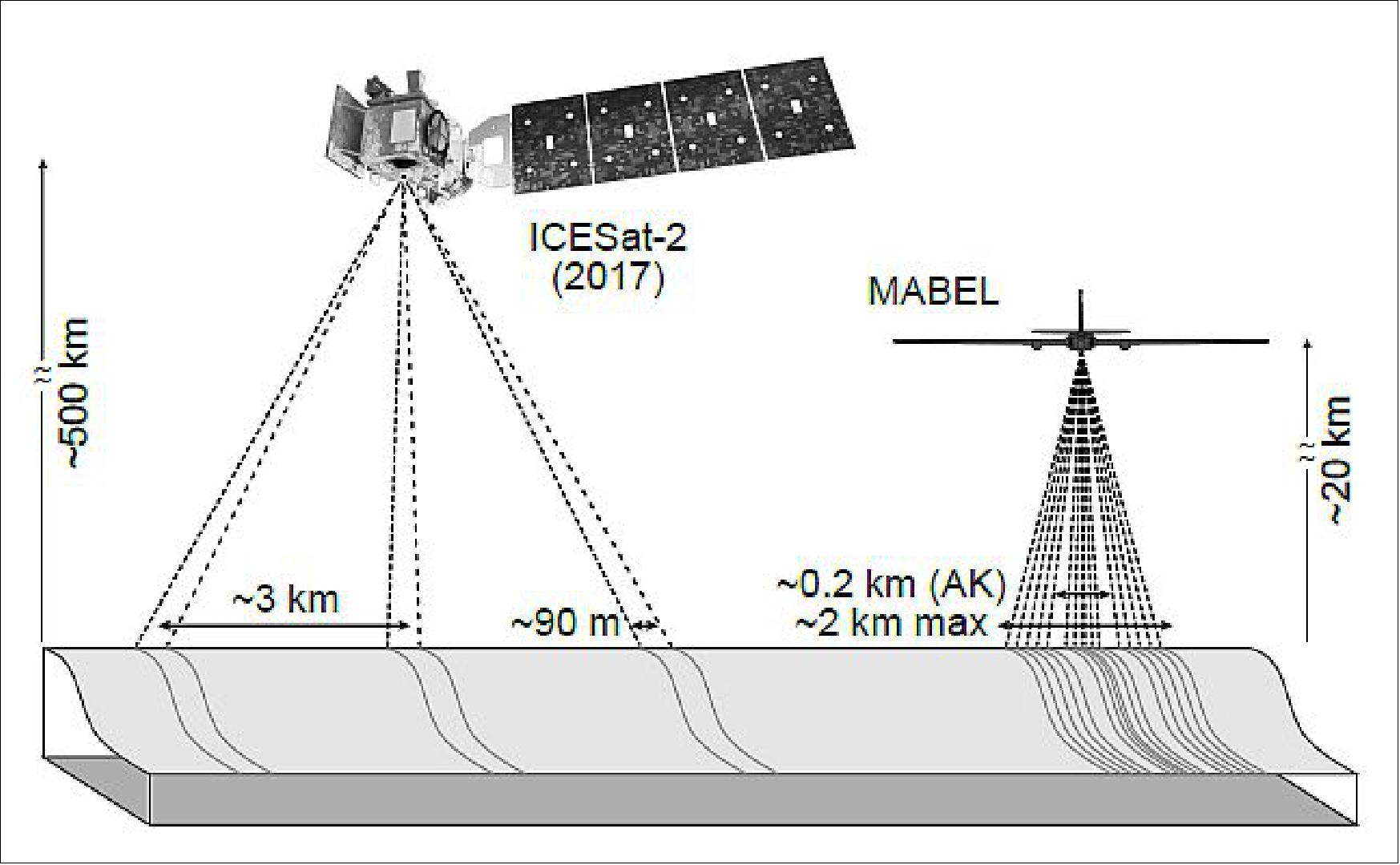
Figure 52: Schematic ICESat-2 and MABEL beam geometry (dashed lines) and reference ground tracks (grey lines along icesheet surface). ICESat-2 beam pairs (separated by ~90 m) do not have the same energy in order to keep the required laser energy low; therefore, each beam pair consists of a strong and a weak beam (as indicated by the dash difference). MABEL allows for beamgeometry changes with a maximum ground spacing of ~2 km at 20 km. However, for the 2014 AK deployment, the maximum ground spacing was 0.2 km (Ref. 86), image credit: MABEL Team
The repetition rate of MABEL is variable (between 5 and 25 kHz); most flights during the 2010–2012 deployments used 5 kHz. At this nominal altitude, repetition rate, and an aircraft speed of ~200 m/s, MABEL samples a ~2 m footprint every ~4 cm along track. During these initial MABEL deployments, beam geometry (specifically the spacing between the individual beams) was configured to mimic ICESat-2.
Following engineering test flights in December 2010 and March 2011, MABEL was deployed to Greenland in April 2012 to collect data over polar targets (Figure 53).
Operation IceBridge is a NASA airborne campaign intended to bridge the data gap between ICESat and ICESat-2. Operation IceBridge hosts a suite of instruments, including the ATM (Airborne Topographic Mapper). ATM is a lidar that conically scans at a rate of 20 Hz, with an off-nadir scanning angle of ~15º. Like GLAS, ATM digitizes returned energy as a waveform with derived surface elevations based on 532 nm wavelength pulses and a 5 kHz PRF (Pulse Repetition Frequency). The ATM flights were conducted using the NASA P-3B at an aircraft speed of ~100 m/s, with a nominal elevation of 500 m above ground level. At this air speed, elevation, and repetition frequency, ATM generates a 1 m footprint and a scanning swath width of ~250 m.
Logistics and cloud-free weather allowed for coordinated surveys between ATM and MABEL over the Greenland Ice Sheet (Figure 53). Here, the MABEL multibeam determination of the ice-sheet surface is presented and compared with that determined by ATM, including local slope assessments. These comparisons are made with consideration for the ICESat-2 planned beam geometry and relative signal strength.
Both MABEL and ATM simultaneously surveyed a 150 km “Southern Traverse” of the Greenland Ice Sheet on April 20, 2012 (Figure 53). Additionally, MABEL made three passes over a 50 km stretch of ICESat track 0412 in the vicinity of Summit Station, Greenland, on April 8, 2012. ATM made a pass of the same ground segment on April 11, 2012. This ground segment has been used as a calibration site for ICESat-2.
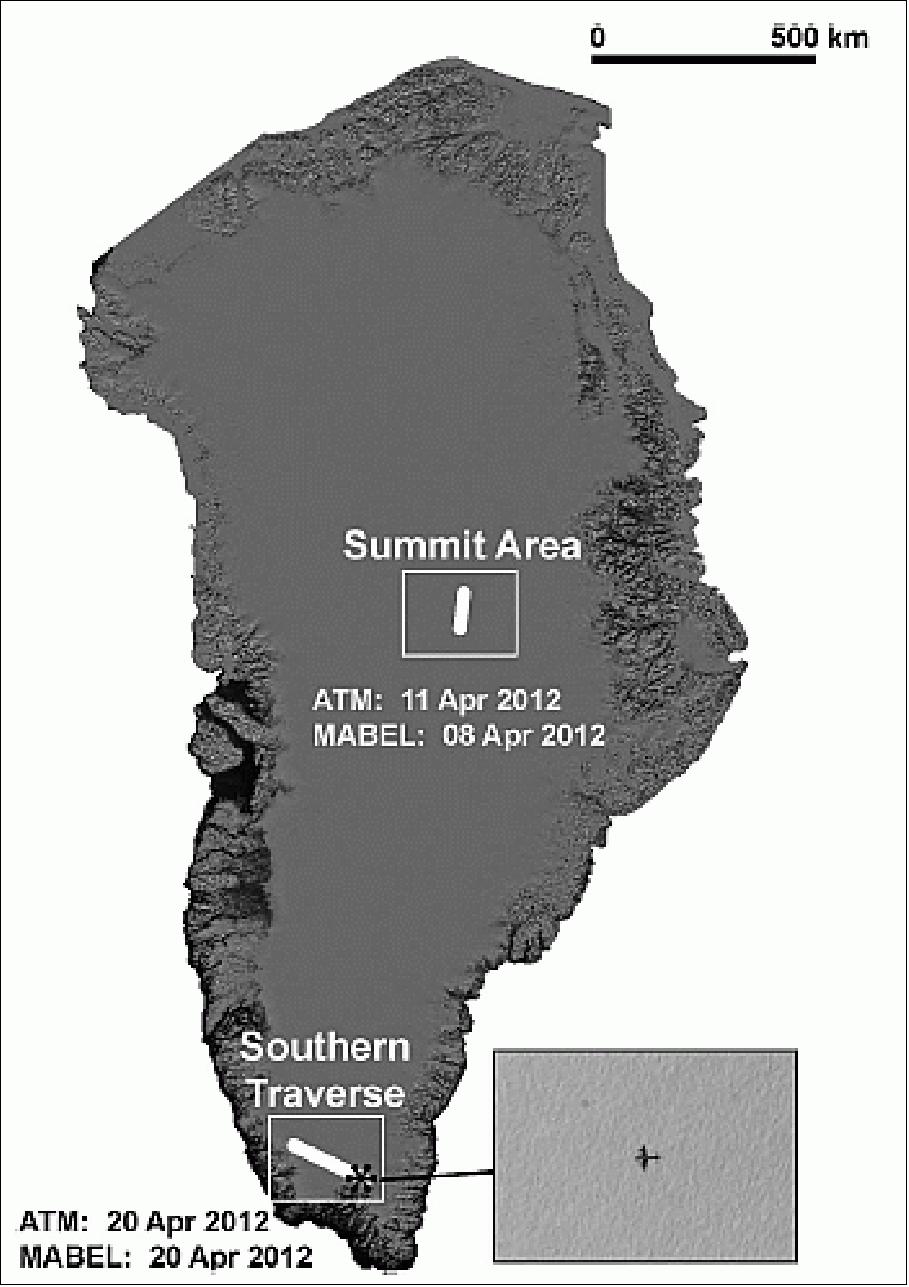
Figure 53. (Inset) Operation IceBridge P-3B captured in the NASA ER-2 Cirrus Digital Camera System at the black.
The NASA IceBridge ATM Level-2 Icessn Elevation, Slope, and Roughness (ILATM2) for April 11 and 20, 2012, were obtained from the National Snow and Ice Data Center (NSIDC). This is a resampled and smoothed elevation data set that provides four across-track elevations per timestamp every ~35 m along-track, which allowed for the trivial calculation of across-track slope. The total across-track span for this data set, for the flights used in this analysis, was approximately 150 m.
MABEL data (release 8) for April 8 and 20, 2012, were obtained from the NASA ICESat-2 website. Each data file contains 1 minute of data for every available beam. The data files contain photon arrival times resulting from reflected laser light (i.e., signal photons) and background photons due to sunlight (i.e., noise photons).
In order to discriminate coarse signal photons from noise photons and derive ice-sheet surface elevation, the team developed an algorithm based on histograms of the photon data. Evolving from techniques applied to other photon-counting lidars, such as the SIMPL (Slope Imaging Multi-polarization Photon-counting Lidar), a 0.125 s (~25 m; 625 shots) along-track segments of data was generated and the photon data at 10 m vertical resolution was histogrammed. Signal photons in four sequential steps were identified.
For direct comparison of the surveys, ATM tracks and MABEL beams were chosen to most closely mimic the 90 m spacing of the ICESat-2 beam geometry. ATM tracks 2 and 3 were used for this analysis because they have ground separation of ~85 m. Elevations from tracks 2 and 3 from the same along-track time were then used to calculate the ATM across-track slope. MABEL beam 6 (center of the array) and beam 5 (~85 m ground spacing from the center of the array) were chosen for analysis as they have an across-track ground separation similar to the ATM tracks used. To determine the MABEL across-track slope, signal photons from beams 5 and 6 were interpolated along track to a common time so that, similar to ATM, an across-track slope could be then calculated for each increment of along-track time. The across-track slopes for both ATM and MABEL were then compared.
MABEL beams have variable signal strengths; however, beams 5 and 6 are the most similar to the expected radiometry of the strong beams of ATLAS. The along-track data density differed within and between flights based on variables that affect reflectivity, including weather conditions, time of day, and sun-incidence angle. For the data used in this analysis, the full-rate along-track data density average for both beams was always greater than 4 signal photons/m. For the Southern Traverse flight, the along-track data densities were 3.4 and 3.9 signal photons per 70 cm for beams 5 and 6, respectively. For the Summit Area flight, data densities were 3.1 and 3.4 signal photons per 70 cm for beams 5 and 6, respectively.
A strong-beam/weak-beam pair will be used for ICESat-2 slope determination; the energy associated with the weak beam will be reduced by a factor of 4. Therefore, the expected number of signal photons per laser shot (every 70 cm along track) between the strong beam and the weak beam will also differ by a factor of 4. The current best estimates of expected signal photons per laser shot vary with season and surface type. Based on ICESat-2 engineering models, under similar conditions as the 2012 MABEL survey, the team expects ICESat-2 to record 8.5 and 2.1 signal photons every shot (or 70 cm along track) for the strong and weak beams, respectively. Thus, the MABEL full-rate data used in this analysis suggest data densities of 46% of the expected ICESat-2 data densities. MABEL engineers are currently working to increase signal strength to achieve the expected ICESat-2 data densities, which will facilitate more direct MABEL to ATLAS comparisons.
To further assess accurate ground characterization given the ICESat-2 planned configuration, all photons associated with one of the MABEL beams (beam 5) were subsampled by a factor of 4 and then reprocessed through the ground-finding algorithm, to simulate the expected radiometric relationship between the ATLAS strong and weak beams. After subsampling, the data densities were 0.9 and 0.8 signal photons per 70 cm for the Southern Traverse and Summit Area, respectively. To determine the MABEL across-track slope, the ground-signal photons from beam 6 and the subsampled ground-signal photons from beam 5 were again interpolated to a common time so that an across-track slope could be calculated as described above. Therefore, the beam with the fewest along-track samples (the weak beam, 5) limited the total number of samples that was used in the slope determination.
Antarctic Preparatory Campaign
In temperatures that can drop below -20º Fahrenheit (-29ºC), along a route occasionally blocked by wind-driven ice dunes, a hundred miles from any other people, a team led by two NASA scientists will survey an unexplored stretch of Antarctic ice. 87)
They’re packing extreme cold-weather gear and scientific instruments onto sleds pulled by two tank-like snow machines called PistenBullys, and on 21 Dec. 2017, they will begin their two- to three-week traverse in an arc around the South Pole.
The 470-mile (759 km) expedition in one of the most barren landscapes on Earth will ultimately provide the best assessment of the accuracy of data collected from space by ICESat-2 (Ice Cloud and land Elevation Satellite-2), set to launch in 2018. With a fast-firing laser instrument, ICESat-2 will measure the elevation of ice sheets and track change over time. Even small amounts of melt across areas as vast as Greenland or Antarctica can result in large amounts of meltwater contributing to sea level rise.
To help document this, ICESat-2's height change measurements will have a precision of less < 2.5 cm – ground-truthed, in part, with efforts like this Antarctic campaign. The team will collect precise GPS data of the elevation at 88 degrees south, where ICESat-2’s orbits converge, providing thousands of points where the survey measurements can be compared to satellite data.
“This traverse provides an extremely challenging and extremely cold way to assess the accuracy of the data,” said Kelly Brunt, ICESat-2’s calibration and validation lead at NASA/GSFC (Goddard Space Flight Center), and a research scientist at the University of Maryland. “ICESat-2’s datasets are going to tell us incredible things about how Earth’s ice is changing, and what that means for things like sea level rise.”
Brunt is leading the four-person campaign from the South Pole, along with ICESat-2’s deputy project scientist Tom Neumann. The NASA scientists will also be joined by a mechanic and a deep field mountaineer. The campaign to collect these key elevation measurements has been years in the making, with logistical help from the National Science Foundation’s U.S. Antarctic Program.
It will be a really cold road trip, Brunt said. They’ll wake up, make coffee (with beans, grounds and pour-over equipment chosen and packed with great care), turn on the snow machines and instruments, and start the day’s drive. The two PistenBullys will each tow a thick plastic sled, about 8 feet wide and 60 feet long. The sleds – kind of like extra-large Flexible Flyers, Neumann noted – will carry tents as well as food, equipment and extra fuel.
The whole trek is about 750 km. The team will leave the South Pole along an established traverse line between the southernmost station and McMurdo. Just after they reach 88º south, they will turn and follow the latitude line for about 186 miles. Then, they’ll turn back to the pole – creating a route like a misshapen piece of pie. At a pace of 50 to 72 km/day, it will take at least a couple weeks to complete.
“There’ll be times when it’s quiet and thoughtful, and there are going to be other times when you’re steering around the sastrugi – the sand dunes of the ice – when you’re not going to make a lot of kilometers on that day, but they’ll be hard fought,” Kelly Brunt said.
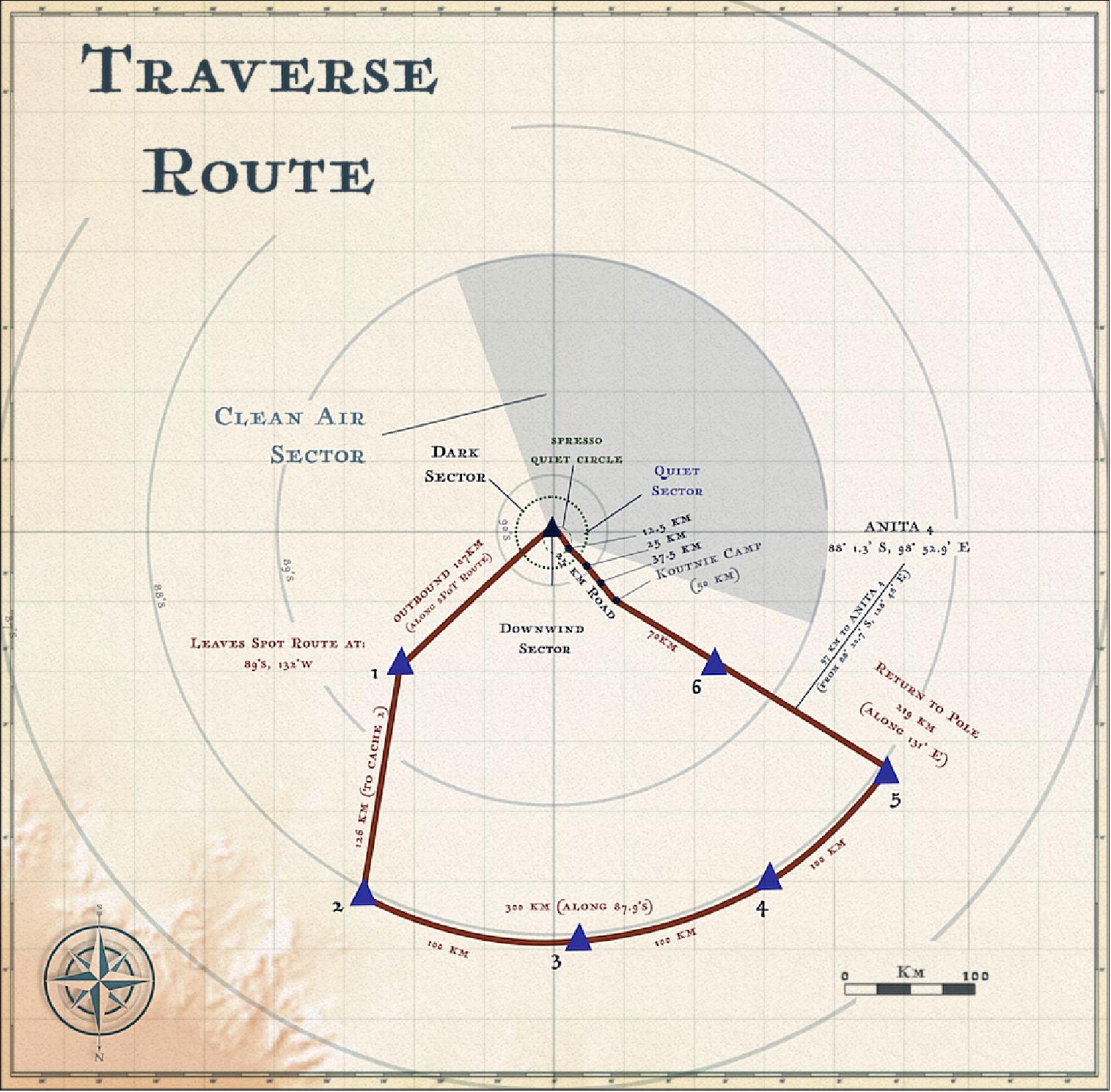
Figure 54: The ICESat-2 team will follow a route from the South Pole station to just north of the 88º south latitude line, then drive along the line at a pace of 50 to 72 km/day. The traverse will take two to three weeks to complete (image credit: NASA, Manrique)
Crevasses are highly unlikely in this thick, slow-moving region of the Antarctic ice sheet, she said. The campaign’s deep field mountaineer will operate a ground penetrating radar that sticks out on a boom in front of the lead vehicle, looking for any gaps in the ice, but the primary safety concerns will be exposure to outside temperatures (-30ºC) and the altitude (about 3 km at South Pole).
The first few days at the South Pole station will be spent acclimatizing to the altitude, Neumann said, noting that the cold, dry air makes the environment even harsher. Once on the road, however, he plans to spend evenings out in the elements, digging holes.
“I’ll measure the density of the snow along the way,” he said. By shoveling out a three-foot-deep pit, he can see layers of snow that have built up over decades, some of which can be hard to dig past. “They’re not super dense, but they’re so old the grains of snow are bonded together like its cement.”
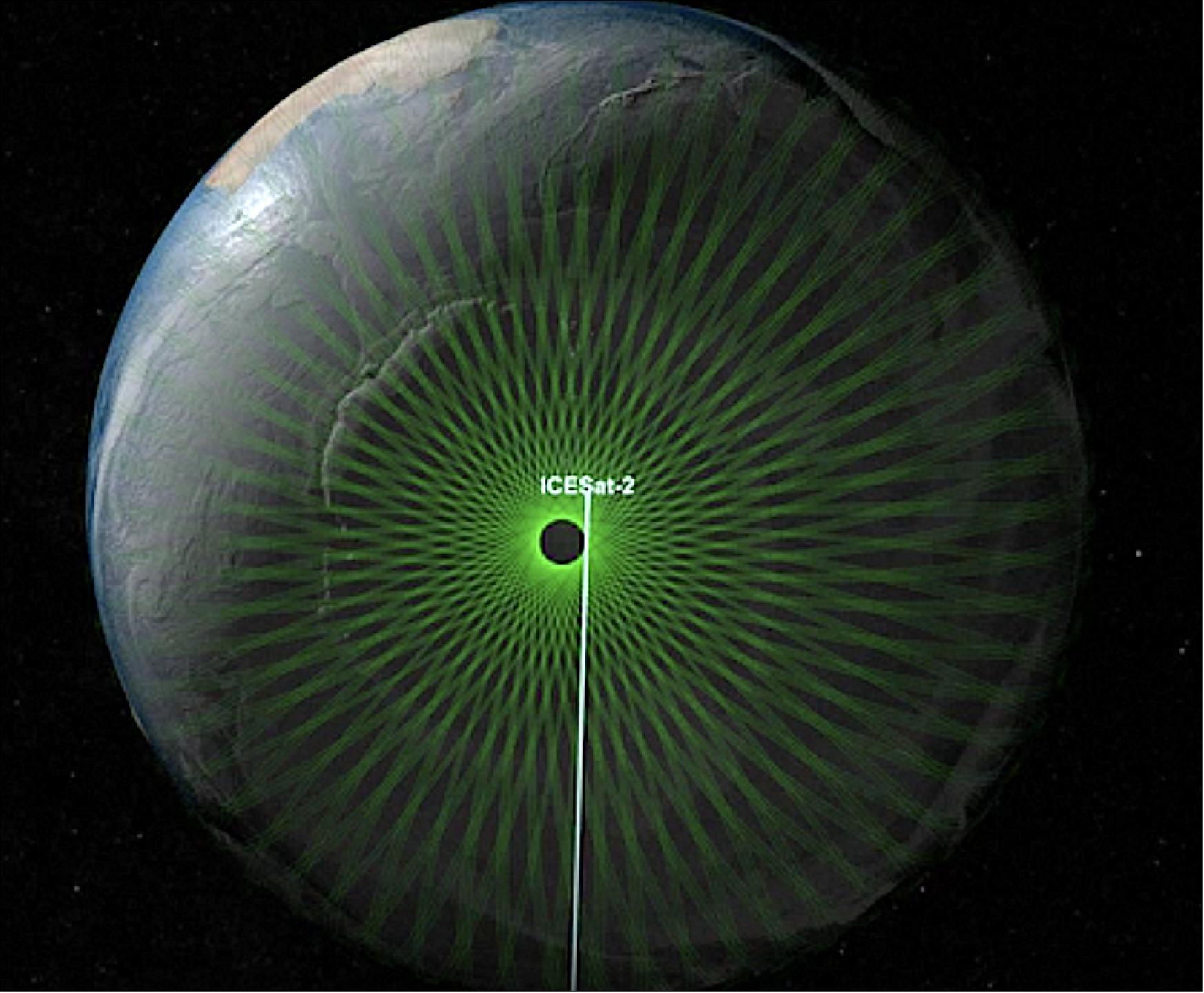
Figure 55: The traverse follows close to the 88 degree south line, where all the orbits will converge, as seen in this visualization. This allows scientists to compare thousands of survey measurements with data collected by ICESat-2 once it is in orbit (image credit: NASA's Scientific Visualization Studio)
When ICESat-2 starts collecting elevation data, the snow density measurements and the data from the ground penetrating radar will help determine how much mass is lost when the ice sheet drops in elevation.
The 88-degree traverse is also an opportunity for Brunt and Neumann to play the odds. At three different sites along the route, they’ll set up a grid of nine reflector cubes, each no bigger than the tip of a pinkie finger. They’ll mark the precise latitude, longitude, and elevation of each cube.
Then, once ICESat-2 is up and running, they’ll wait. If one of the satellite’s six laser beams hits a cube, the mirrored material of the cube will reflect the laser light back at a much higher than normal intensity. Since they’ll know the exact location and elevation of the cube, they can check the accuracy of the satellite data even more precisely than with the traverse data.
“If you hit that tiny little point, you’ll know exactly where the laser hit on the ground,” Brunt said. “But hitting that point is both aiming and luck. It’s hard. But, by placing them at 88 degrees, where you have so many orbits crossing and so much data, it’s just a statistics game.”
After the traverse, the scientists will return to the United States, retracing their steps from the South Pole station, to McMurdo Station, to New Zealand and home. With them: hard drives full of data to help understand the accuracy of ICESat-2.
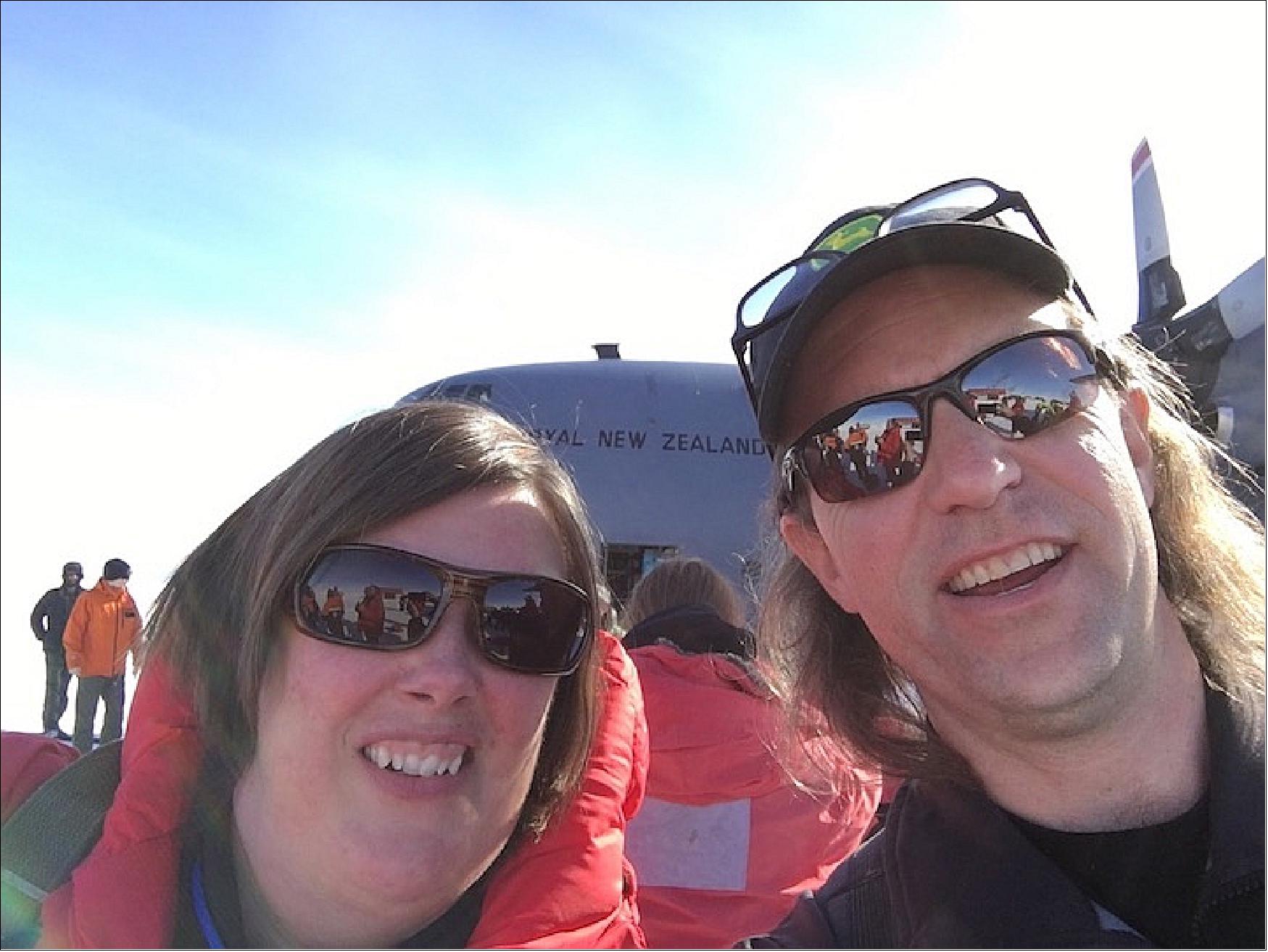
Figure 56: Kelly and Tom on the ice runway at McMurdo Station, Antarctica (image credit: Tom Neumann) 88)

Figure 57: Tom and Kelly inside a PistenBully, like the one they’ll use for the traverse along 88 degrees south (image credit: Kelly Brunt)
NASA Operation IceBridge Campaign in Antarctica 2017
This campaign is intended to be flown by NASA's P-3 aircraft, beginning in late October and ending in late November 2017. The mission, called Operation IceBridge, is in its ninth year of flights to map the snow and ice of Antarctica. The view from above provides a tremendous amount of information about the huge expanses of snow and ice around Earth’s polar regions and how they are changing. 89) 90)
Some flight lines are designed to map the ice laying atop the land, while others map the sea ice. On November 4, 2017, the IceBridge team flew its “Endurance West” mission, which specifically targets sea ice. The P3 crossed the northern tip of the Antarctic Peninsula, descended to a lower altitude, and then flew southward across the Weddell Sea. The path purposely follows a ground track of ICESat-2 —an ice-mapping satellite mission that is scheduled for launch in late 2018.
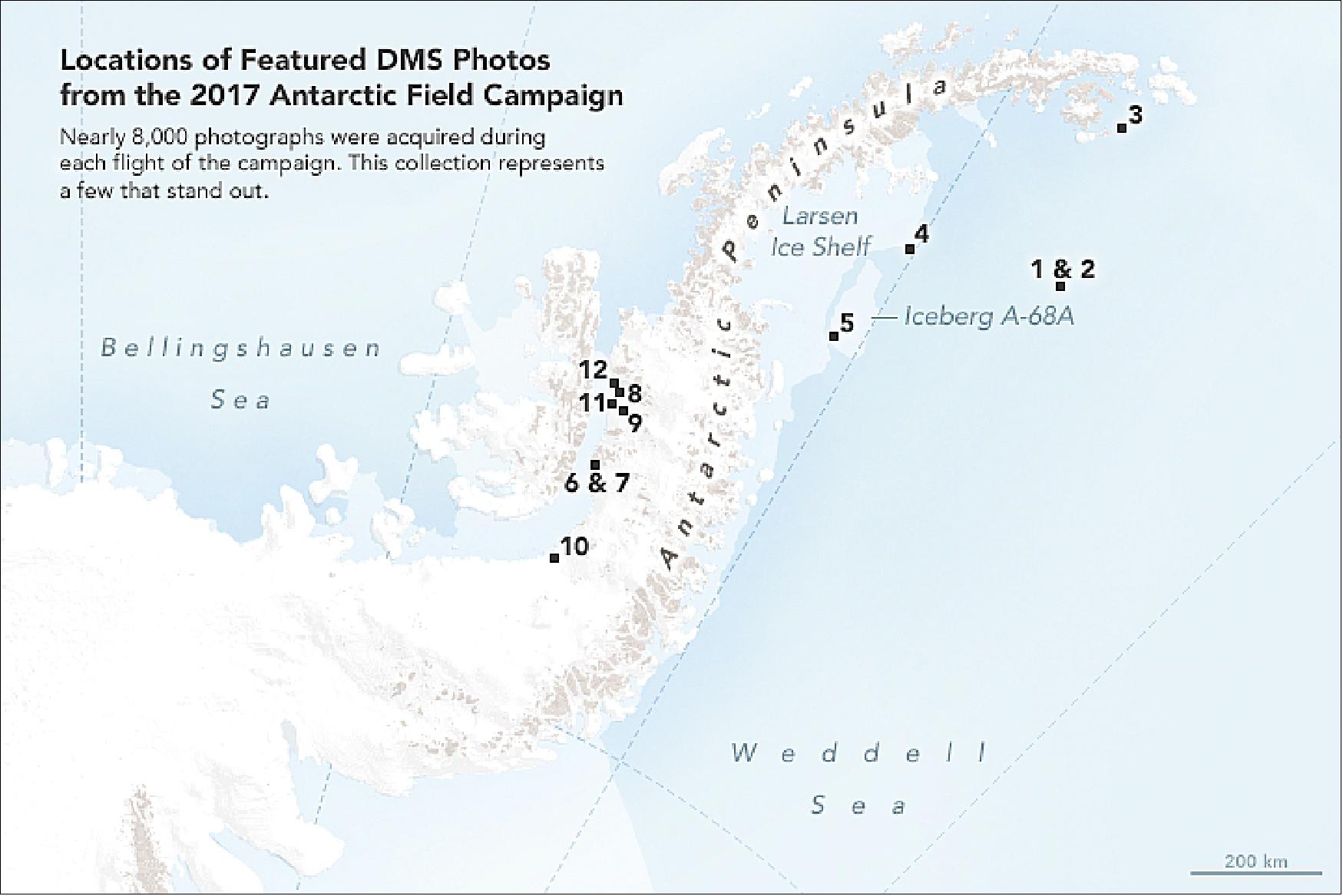
Figure 58: One of the mission’s instruments, the DMS (Digital Mapping System), collects thousands of high-resolution photographs during a single flight. These images shot from a camera mounted on the belly of the plane are “visual truth,” helping scientists identify features that are also detected by radar, laser, and gravity instruments (image credit: NASA Earth Observatory, map by Joshua Stevens)
Images from that day show just how varied sea ice can appear. The first photograph, shot from the aircraft by IceBridge project scientist Nathan Kurtz, shows newly formed sea ice next to a snow-covered floe in the Weddell Sea. The second and third images, both acquired by the DMS (Digital Mapping System), show sea ice off the Antarctic Peninsula. Thicker ice is white, thinner ice is gray, and open water is black or navy.
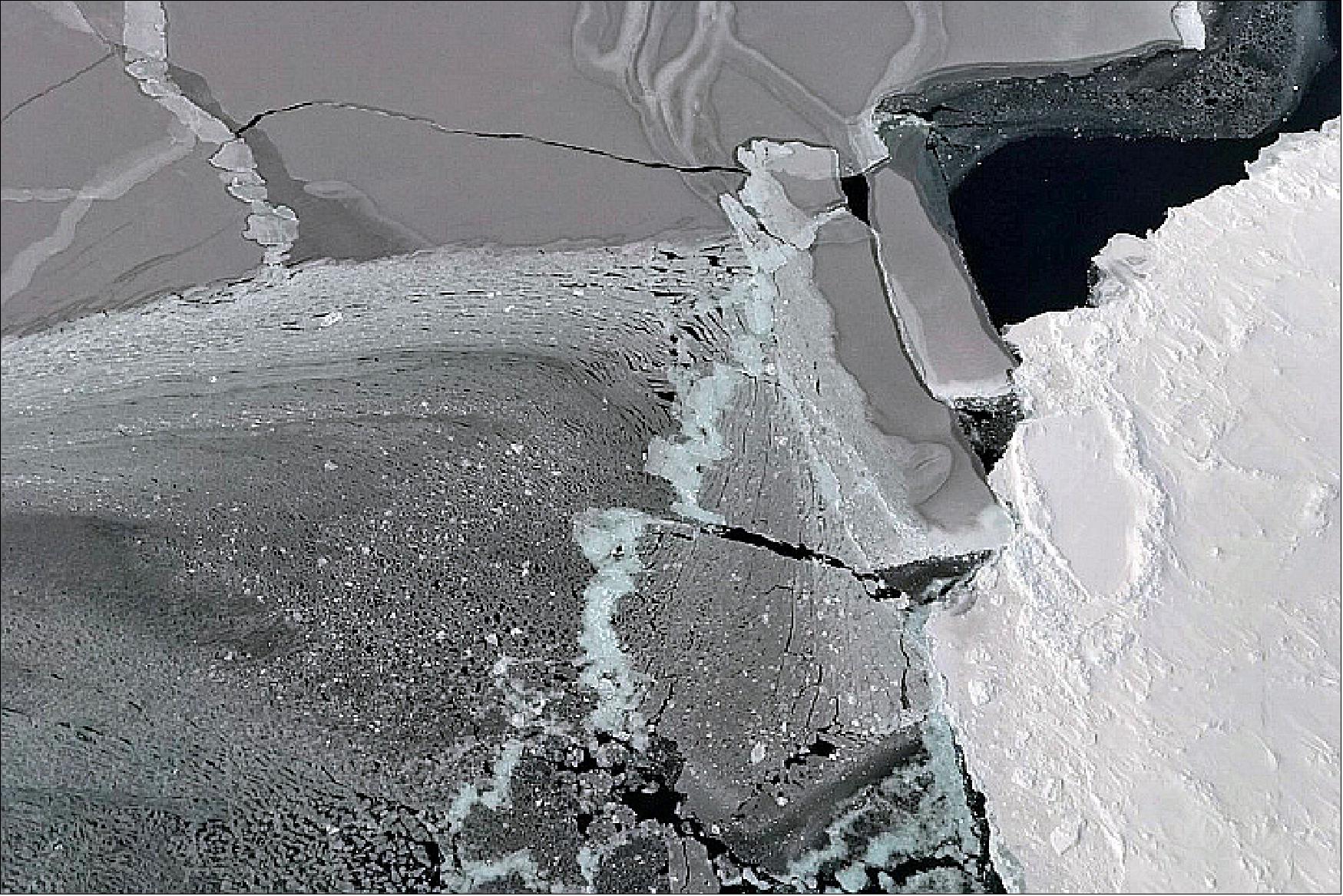
Figure 59: Newly formed sea ice (gray) in the Weddell Sea (image credit: NASA, Nathan Kurtz — image 1)
On November 12, 2017, IceBridge flew a high-priority mission over the Larsen C Ice Shelf. In July 2017, this region was significantly reshaped by the shedding of an iceberg the size of Delaware. For most of the four-hour survey, as the aircraft flew back-and-forth in parallel lines over the ice shelf, the landscape appeared flat and white. These new flight lines followed the ground tracks of the future ICESat-2, providing baseline measurements for the satellite to take over after it begins operations. This survey also increased the amount of Larsen C that has been observed with a gravimeter, an instrument that helps scientists map the bedrock below the ice shelf and the water, which radar and visual imagers cannot penetrate.
Visually, the landscape appeared more varied when the aircraft traced the edge of the ice shelf or soared over sea ice. These photographs show sea ice of various types as observed by the DMS during the November 12 flight.
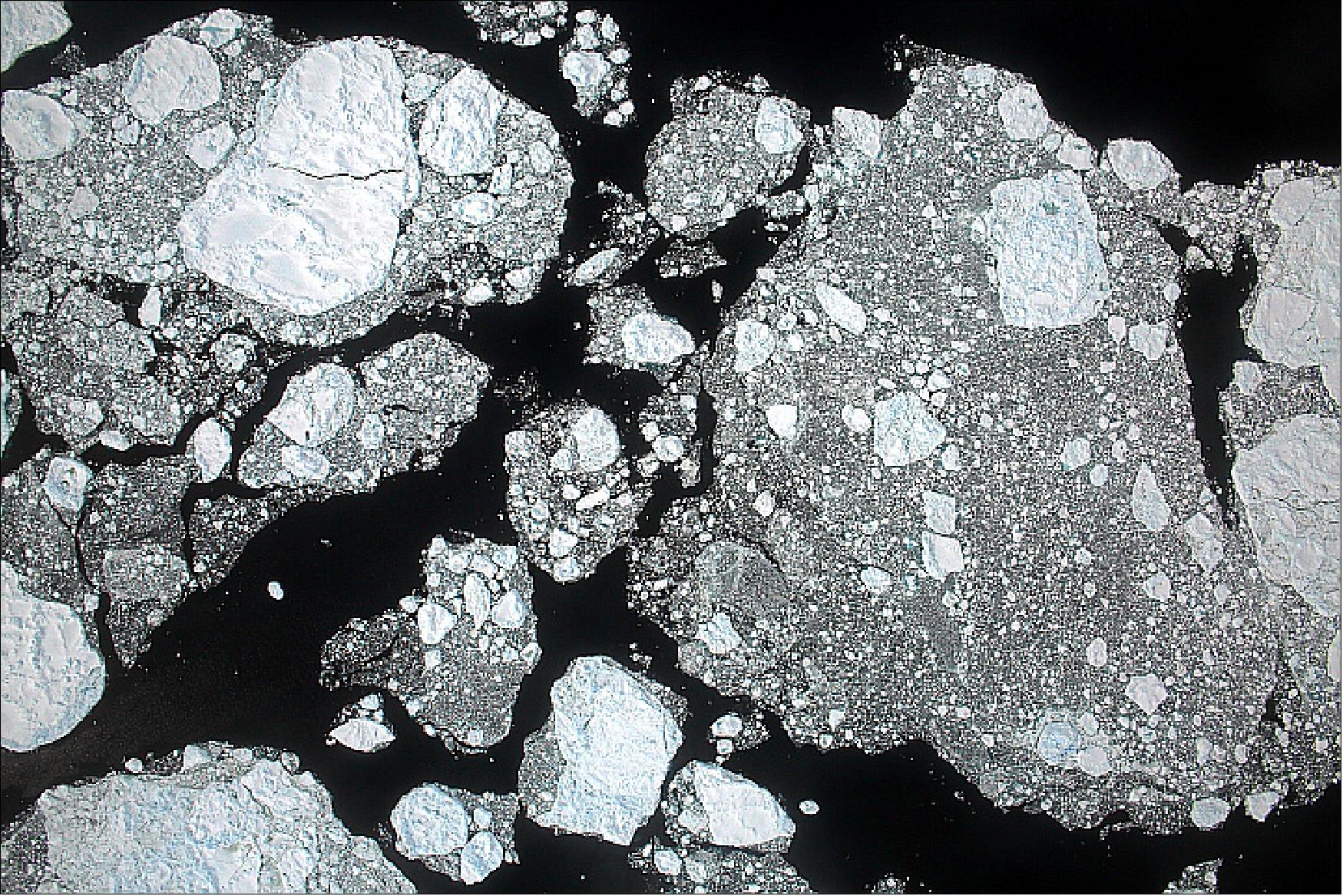
Figure 60: Sea ice near the Larsen C Ice Shelf (image credit: NASA/Digital Mapping System — image 4)
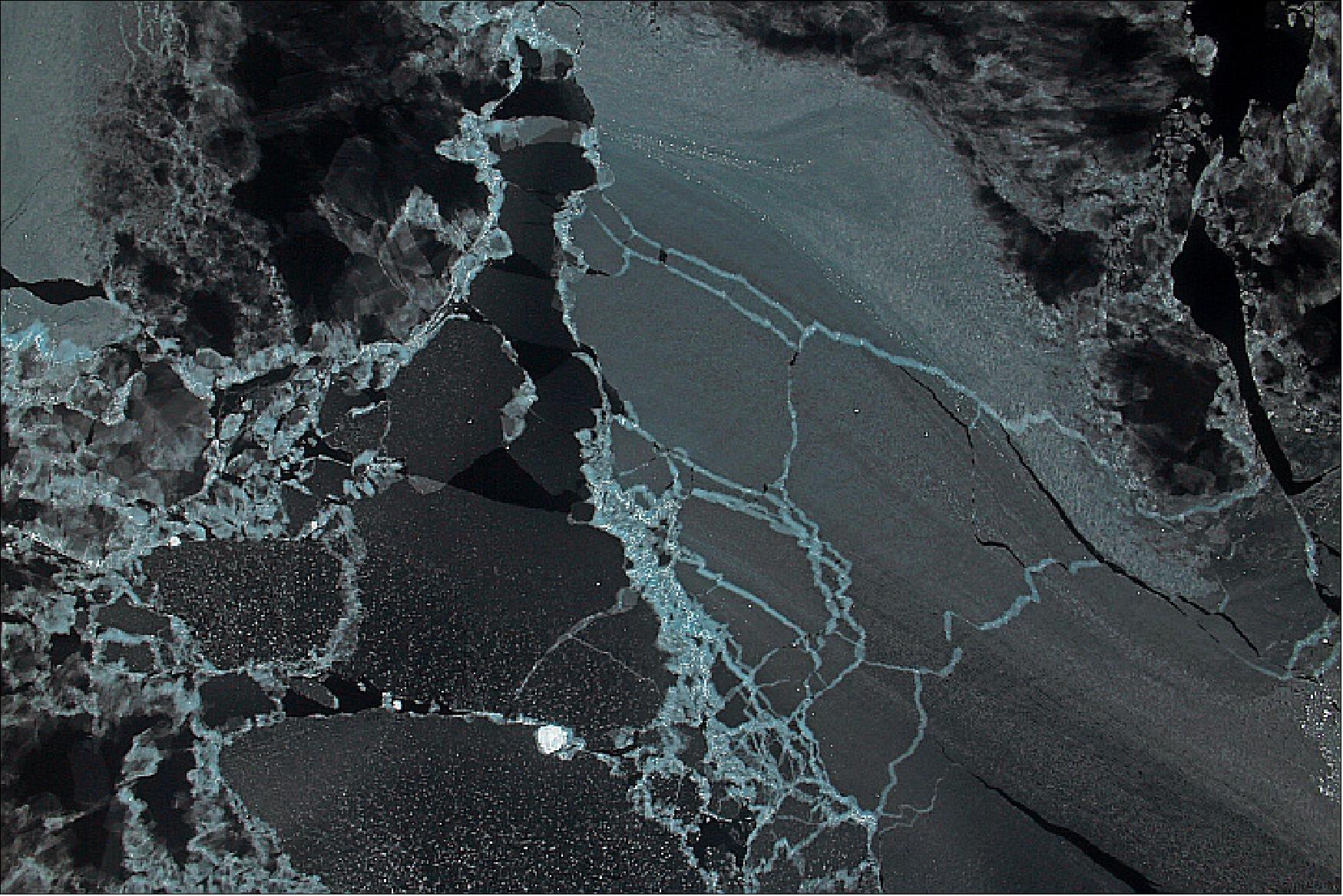
Figure 61: Thin ice between the Larsen C Ice Shelf and iceberg A-68A (image credit: NASA/Digital Mapping System — image 5)
Fractures: During any given IceBridge flight, one can see areas of fractures and crevasses that attest to lumbering motion of huge slabs of ice. Its thickness on this part of the continent can vary dramatically, from no ice at all (barren bedrock) to more than a kilometer thick. The reason for the brittle appearance is similar to the phenomenon of river rapids, which become amplified as water flows through steep, narrow terrain. As ice flows through narrower areas and steeper bedrock, more fractures open up at the ice surface. But the flow of ice is so much slower than water, and fractures are often the only perceptible indication of movement. These images, acquired by the DMS on November 3, 2017, show cracks in the ice as observed while flying over the southern Antarctic Peninsula.
The image of Figure 62 shows a heavily crevassed glacier, about 13 miles long and 7 miles wide, flowing west from the Dyer Plateau to George VI Sound. The north side of this glacier merges with Meiklejohn Glacier.
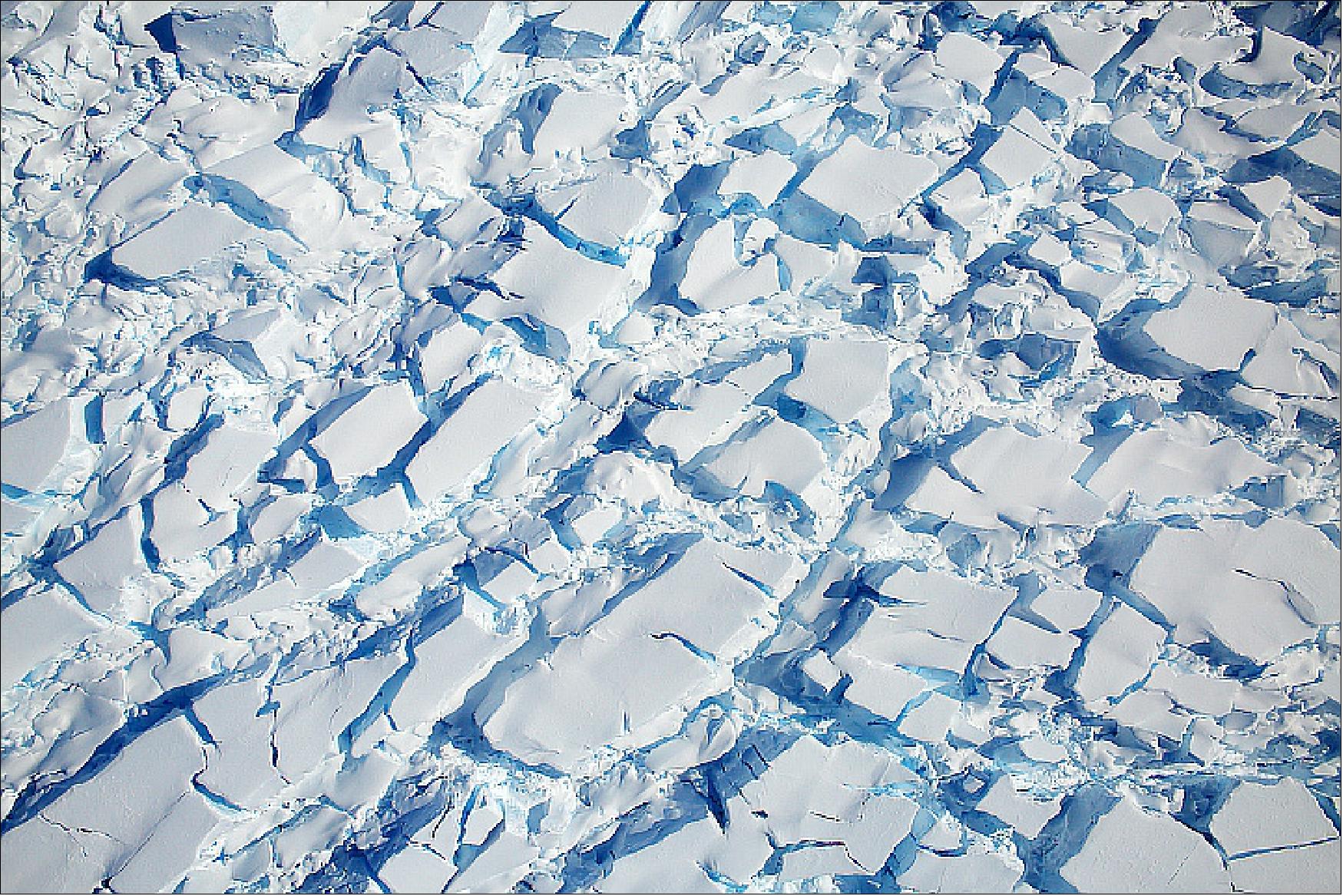
Figure 62: A heavily crevassed glacier flows west from the Dyer Plateau (image credit: NASA/Digital Mapping System — image 11)
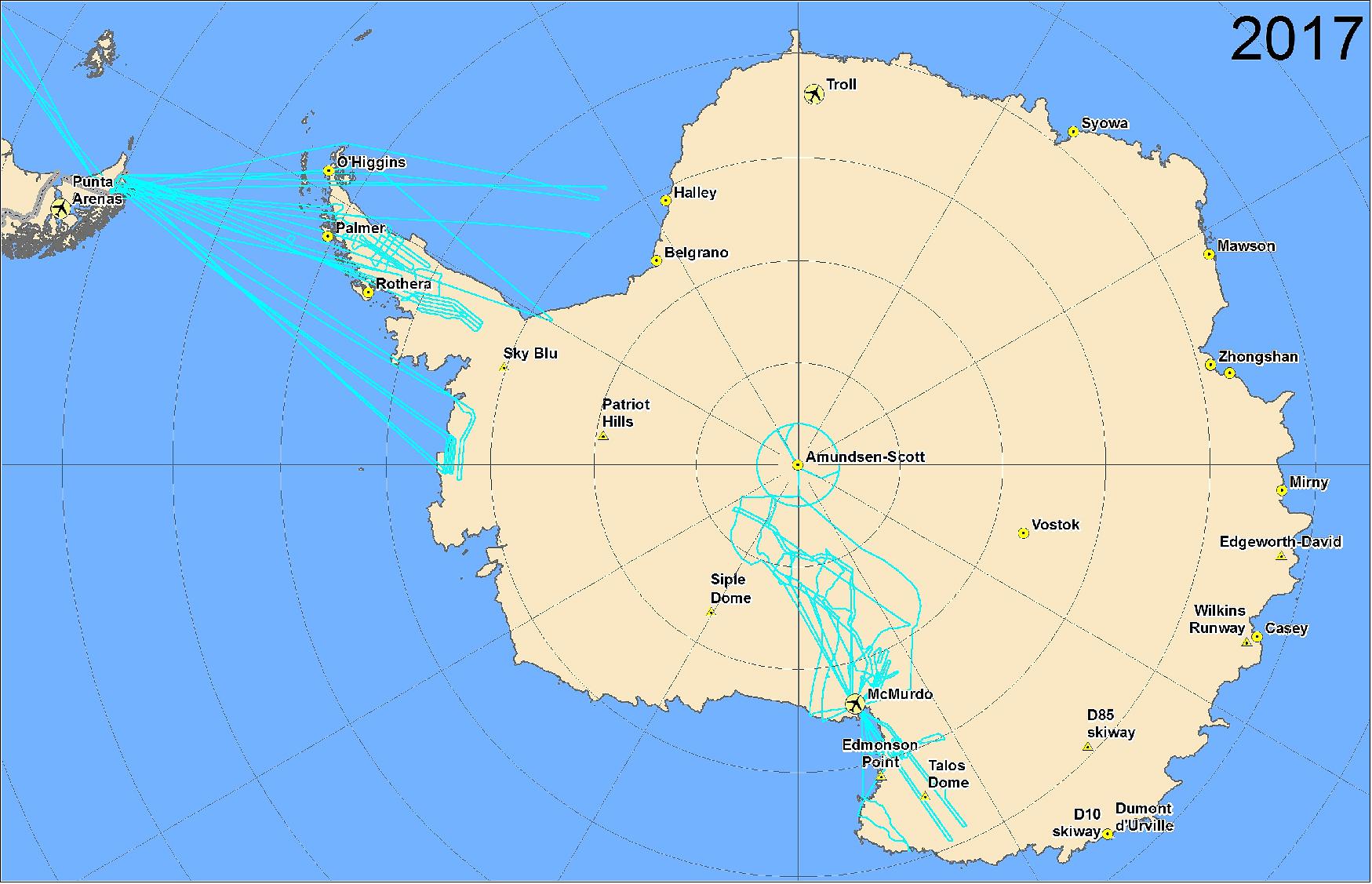
Figure 63: Proposed flight lines of the NASA P-3B aircraft during the 2017 Antarctic Field Campaign of Operation IceBridge (image credit: NASA) 91)
References
1) Waleed Abdalati, H. Jay Zwally, Robert Bindschadler, Bea Csatho, Sinead Louise Farrell, Helen Amanda Fricker, David Harding, Ronald Kwok, Michael Lefsky, Thorsten Markus, Allexander Marshak, Thomas Neumann, Stephen Palm, Bob Schutz, Ben Smith, James Spinhirne, Charles Webb, “The ICESat-2 Laser Altimetry Mission,” Proceedings of the IEEE. Vol 98, No. 5, May 2010. Pages 735-751., URL: http://icesat.gsfc.nasa.gov/icesat2/publications/pubs_2010/abdalati_et_al_2010.pdf
2) Douglas D. McLennan, “Ice, Clouds and Land Elevation (ICESat-2) Mission,” Proceedings of the SPIE Remote Sensing Conference, Toulouse, France, Vol. 7826, Sept. 20-23, 2010, paper: 7826-32, 'Sensors, Systems, and Next-Generation Satellites XIV,' edited by Roland Meynart, Steven P. Neeck, Haruhisa Shimoda, doi: 10.1117/12.865200
3) “ICESat-2,” NASA/GSFC, URL: http://icesat.gsfc.nasa.gov/icesat2/
4) David J. Harding, “NASA's Lidar measurements of the Earth's surface from space,” Proceedings of IGARSS (International Geoscience and Remote Sensing Symposium), Munich, Germany, July 22-27, 2012
5) Molly Brown, Mark Carroll, Vanessa Escobar, “ICESat-2 Applications Workshop Report, NASA Goddard Space Flight Center, April 12, 2012, URL: http://icesat.gsfc.nasa.gov/icesat2/applications/ICESat2_Applications_Workshop1_Report_final.pdf
6) Kelly M. Brunt, Sinéad L. Farrell, Vanessa M. Escobar, “ICESat-2: A next generation laser altimeter for space-borne determination of surface elevation,” 93rd American Meteorological Society Annual Meeting, Austin, TX, USA, Jan. 6-10, 2013, URL: https://ams.confex.com/ams/93Annual/webprogram/Handout/Paper224015/BruntAMS2013.pdf
7) http://icesat-2.gsfc.nasa.gov/
8) “Earth Science and Applications from Space,” NASA, NAS (National Academy of Sciences), URL: http://cce.nasa.gov/pdfs/ICESAT-II.pdf
9) Tom Newmann, Thorsten Markus, Matthew McGill, Kelly Brunt, Tony Martino, William Cook, “MABEL and the ICESat-2 Mission: Photon-counting Altimetry from Air and Space,” The Earth Observer, Sept.-Oct. 2012, Volume 24, Issue 5, pp: 4-8, URL: http://eospso.gsfc.nasa.gov/sites/default/files/eo_pdfs/Sept_Oct_2012_color_508.pdf
10) https://icesat-2.gsfc.nasa.gov/mission
11) S. Volz, “NASA Earth Sciience New Miissiion Concepts for the Future,” 5th SORCE Science Meeting, Santa Fee, NM, Feb. 7, 2008, URL: http://lasp.colorado.edu/sorce/news/2008ScienceMeeting/doc/Session4/S4_08_Volz.pdf
12) John Loiacono, ICESat-2 Progress Report for FY08 and FY09 Plans,” Feb. 11, 2009, URL: [web source no longer available]
13) “Orbital Wins ICESat-2 Earth Science Satellite Program Contract,” Space Daily, Sept. 2, 2011, URL: http://www.spacedaily.com/reports/Orbital_Wins_ICESat_2_Earth_Science_Satellite_Program_Contract_999.html
14) “NASA Selects Contractor For Icesat-2 Spacecraft,” NASA, Aug. 31, 2011, URL: http://www.nasa.gov/home/hqnews/2011/aug/HQ_C11-037_ICESat2.html
15) “ICESat-2,”, Orbital ATK, URL: https://web.archive.org/web/20161025235444/https://www.orbitalatk.com/space-systems/science-national-security-satellites/science-environment-satellites/docs/ICESat-2.pdf
16) Kate Ramsayer, ”ICESat-2 Lasers Pass Final Ground Test,” NASA, 9 July 2018, URL: [web source no longer available]
17) ”Northrop Grumman Completes Orbital ATK Acquisition, Blake Larson Elected to Lead New Innovation Systems Sector,” Northrop Grumman News, 6 June 2018, URL: https://news.northropgrumman.com/news/releases/northrop-grumman-completes-orbital-atk-acquisition-blake-larson-elected-to-lead-new-innovation-systems-sector
18) Kate Ramsayer, ”NASA space laser completes 2,000-mile road trip,” Space Daily, 1 March 2018, URL: http://www.spacedaily.com/reports/NASA_Space_Laser_Completes_2000_mile_Road_Trip_999.html
19) Kate Ramsayer , Sara Blumberg, ”NASA's ICESat-2 Preps for Laser Tests,” NASA, Aug. 16, 2017, URL: https://www.nasa.gov/feature/goddard/2017/nasas-icesat-2-preps-for-laser-tests
20) Michael Freilich, ”ICESat-2 Technical Status Summary,” The National Academies of Sciences, Engineering, and ..., Sept. 1, 2016, URL: http://sites.nationalacademies.org/cs/groups/ssbsite/documents/webpage/ssb_174609.pdf
21) ”ICESat-2: Status Updates,” NASA, URL: http://icesat.gsfc.nasa.gov/icesat2/status.php
22) Kate Ramsayer, ”NASA tests ICESat-2's laser aim,” NASA, Dec. 10, 2015, URL: http://www.nasa.gov/feature/goddard/lasers-path-through-icesat-2
23) Kate Ramsayer, “NASA's ATLAS thermal testing: You're hot, then you're cold,” NASA, April 21, 2015, URL: http://phys.org/news/2015-04-nasa-atlas-thermal-youre-hot.html
24) “NASA lining up ICESat-2's laser-catching telescope,” NASA, Nov. 3, 2014, URL: http://phys.org/news/2014-11-nasa-lining-icesat-laser-catching-telescope.html#inlRlv
25) Dan Leone, “Paying for ICESat-2 Overruns Delays International Earth Science Launches,” Space News, Sept. 1, 2014, URL: http://spacenews.com/41729paying-for-icesat-2-overruns-delays-international-earth-science-launches/
26) Stephen Clark, “Over-budget ICESat 2 mission under review,” Spaceflight Now, Dec. 10, 2013, URL: http://spaceflightnow.com/news/n1312/10icesat2/#.U5lV4Ha4Ri0
27) ”NASA, ULA Launch Mission to Track Earth's Changing Ice,” NASA Release 18-078, 15 September 2018, URL: https://www.nasa.gov/press-release/nasa-ula-launch-mission-to-track-earths-changing-ice
28) ”2018: A Big Year for NASA's Launch Services Program,” NASA, 1 Feb. 2018, URL: https://www.nasa.gov/feature/2018-a-big-year-for-nasas-launch-services-program
29) ”About ICESat-2,” NASA, 2017, URL: [web source no longer available]
30) ”ELFIN,” UCLA, 9 March 2018, URL: http://elfin.igpp.ucla.edu/
31) Kate Ramsayer, ”NASA Approves Continuation of ICESat-2 After 3+ Years of Big Results,” NASA, 28 June 2022, URL: https://www.nasa.gov/goddard/2022/nasa-approves-continuation-of-icesat-2-after-3-years-of-big-results
32) ”NASA Awards Mission Operations Center Support Contract,” NASA Contract Release, 10 February 2022, URL: https://www.nasa.gov/press-release/nasa-awards-mission-operations-center-support-contract
33) Roberto Molar Candanosa, Ellen Gray, ”NASA Space Lasers Map Meltwater Lakes in Antarctica With Striking Precision,” NASA Feature, 7 July 2021, URL: https://www.nasa.gov/feature/goddard/2021/nasa-space-lasers-map-meltwater-lakes-in-antarctica-with-striking-precision
34) M. R. Siegfried, H. A. Fricker, ”Illuminating active subglacial lake processes with ICESat-2 laser altimetry,” Geophysical Research Letters, Firts published: 07 July 2021, https://doi.org/10.1029/2020GL091089
35) ”Sizing Up a Tabular Iceberg,” NASA Earth Observatory, 3 June 2021, URL: https://earthobservatory.nasa.gov/images/148388/sizing-up-a-tabular-iceberg
36) ”Sounding the Seafloor with Light,” NASA Earth Observatory, Image of the Day for 30 April 2021, URL: https://earthobservatory.nasa.gov/images/148246/sounding-the-seafloor-with-light
37) N. Thomas, A. P. Pertiwi, D. Traganos, D. Lagomasino, D. Poursanidis, S. Moreno, L. Fatoyinbo, ”Space‐Borne Cloud‐Native Satellite‐Derived Bathymetry (SDB) Models Using ICESat‐2 And Sentinel‐2,” Geophysical Research Letters, Volume48, Issue6, 28 March 2021, e2020GL092170, https://doi.org/10.1029/2020GL092170, URL: https://agupubs.onlinelibrary.wiley.com/doi/epdf/10.1029/2020GL092170
38) ”Sizing Up Remote Lakes,” NASA Earth Observatory, Image of the Day for 27 April 2021, URL: https://earthobservatory.nasa.gov/images/148230/sizing-up-remote-lakes
39) Kate Ramsayer, ”NASA Scientists Complete 1st Global Survey of Freshwater Fluctuation,” NASA Feature, 3 March 2021, URL: https://www.nasa.gov/feature/goddard/2021/nasa-scientists-complete-first-global-survey-of-freshwater-fluctuation
40) Sarah W. Cooley, Jonathan C. Ryan & Laurence C. Smith, ”Human alteration of global surface water storage variability,” Nature, Volume 591, pp:78-81, Published: 03 March 2021, https://doi.org/10.1038/s41586-021-03262-3
41) Kate Ramsayer, ”Beyond Ice: NASA’s ICESat-2 Shows Hidden Talents,” NASA Feature, 9 December 2020, URL: https://www.nasa.gov/feature/goddard/2020/beyond-ice-nasa-s-icesat-2-shows-hidden-talents
42) ”Taking a Measure of Sea Level Rise: Ice Height,” NASA Earth Observatory, Image of the Day for 9 November 2020, URL: https://earthobservatory.nasa.gov/images/147438/taking-a-measure-of-sea-level-rise-ice-height?src=eoa-iotd
43) ”TCarta develops AI-based commercial bathymetric mapping technologies,” Space Daily, 27 October 2020, URL: https://www.spacedaily.com/reports/TCarta_develops_AI_based_commercial_bathymetric_mapping_technologies_999.html
44) ”Mapping Shallow Seafloors,” NASA Earth Observatory, Image of the Day for 29 September 2020, URL: https://earthobservatory.nasa.gov/images/147338/mapping-shallow-seafloors
45) ”Cracking Icy Secrets of New Penguin Colonies,” NASA Earth Observatory, Image of the Day for24 September 2020, URL: https://earthobservatory.nasa.gov/images/147310/cracking-icy-secrets-of-new-penguin-colonies
46) Aries Keck, ”Pinpointing Tropical Forests with High Ecological 'Quality',” NASA Earth, 25 August 2020, URL: https://www.nasa.gov/feature/pinpointing-tropical-forests-with-high-ecological-quality
47) Andrew J. Hansen, Patrick Burns, Jamison Ervin, Scott J. Goetz, Matthew Hansen, Oscar Venter, James E. M. Watson, Patrick A. Jantz, Anne L. S. Virnig, Kevin Barnett, Rajeev Pillay, Scott Atkinson, Christina Supples, Susana Rodríguez-Buritica & Dolors Armenteras, ”A policy-driven framework for conserving the best of Earth’s remaining moist tropical forests,” Nature Ecology & Evolution, Volume 612, Published: 10 August 2020, https://doi.org/10.1038/s41559-020-1274-7
48) Kate Ramsayer, ”Syncing NASA Laser, ESA Radar for a New Look at Sea Ice,” NASA/GSFC, 16 July 2020, URL: https://www.nasa.gov/feature/goddard/2020/syncing-nasa-laser-esa-radar-for-a-new-look-at-sea-ice
49) ”Mapping Snow on Arctic Sea Ice,” NASA Earth Observatory, Image of the Day for 27 May 2020, URL: https://earthobservatory.nasa.gov/images/146758/mapping-snow-on-arctic-sea-ice
50) R. Kwok, S. Kacimi, M.A. Webster, N. T. Kurtz, A. A. Petty, ”Arctic Snow Depth and Sea Ice Thickness From ICESat‐2 and CryoSat‐2 Freeboards: A First Examination,” JGR (Journal of Geophysical Research) Oceans, Volume125, Issue3, 10 March 2020, e2019JC016008, https://doi.org/10.1029/2019JC016008
51) Kate Ramsayer, ”NASA’s ICESat-2 Measures Arctic Ocean’s Sea Ice Thickness, Snow Cover,” NASA Feature, 14 May 2020, URL: https://www.nasa.gov/feature/goddard/2020/icesat-2-measures-arctic-sea-ice-thickness-snow-cover
52) Alek A. Petty, Nathan T. Kurtz, Ron Kwok,Thorsten Markus, Thomas A. Neumann, ”Winter Arctic Sea Ice Thickness From ICESat‐2 Freeboards,” JGR (Journal of Geographical Research): Oceans, Volume125, Issue5, Published: 15 May 2020, e2019JC015764, https://doi.org/10.1029/2019JC015764
53) R. Kwok, S. Kacimi, M.A. Webster, N. T. Kurtz, A. A. Petty, ”Arctic Snow Depth and Sea Ice Thickness From ICESat‐2 and CryoSat‐2 Freeboards: A First Examination,” JGR Oceans, Volume 125, Issue 3, Published: 10 March 2020, e2019JC016008, https://doi.org/10.1029/2019JC016008
54) ”NASA Space Laser Missions Map 16 Years of Ice Sheet Loss,” NASA/JPL News Release 2020-086 , 30 April 2020, URL: https://www.jpl.nasa.gov/news/news.php?release=2020-086
55) Ben Smith, Helen A. Fricker, Alex S. Gardner, Brooke Medley, Johan Nilsson, Fernando S. Paolo, Nicholas Holschuh, Susheel Adusumilli, Kelly Brunt, Bea Csatho, Kaitlin Harbeck, Thorsten Markus, Thomas Neumann, Matthew R. Siegfried, H. Jay Zwally, ”Pervasive ice sheet mass loss reflects competing ocean and atmosphere processes,” Science, 30 Apr 2020: eaaz5845, https://doi.org/10.1126/science.aaz5845
56) Jessica Merzforf, ”NASA's Operation IceBridge Completes Eleven Years of Polar Surveys,” 13 December 2019, URL: https://climate.nasa.gov/news/2941/nasas-operation-icebridge-completes-eleven-years-of-polar-surveys/
57) ”A Transylvanian Transect for Halloween,” NASA Earth Observatory, Image of the Day for 1 November 2019, URL: https://earthobservatory.nasa.gov/images/145807/a-transylvanian-transect-for-halloween?src=eoa-iotd
58) ”Lake Mead by the Seasons,” NASA Earth Observatory, 18 October 2019, URL: https://earthobservatory.nasa.gov/images/145743/lake-mead-by-the-seasons
59) ”ICESat-2 Celebrates One Year for Photon Phriday,” NASA, 16 September 2019, URL: https://www.youtube.com/watch?v=t3MWfuaDAqc&feature=youtu.be
60) ”The Ups and Downs of Crater Lake,” NASA Earth Observatory, Image of the Day for 29 July 2019, URL: https://earthobservatory.nasa.gov/images/145370/the-ups-and-downs-of-crater-lake
61) ”Flowing Antarctic Ice Mapped 10 Times More Accurately,” NASA/JPL News, 29 July 2019, URL: https://www.jpl.nasa.gov/news/news.php?release=2019-153
62) J. Mouginot, E. Rignot, B. Scheuchl, ”Continent‐wide, interferometric SAR phase, mapping of Antarctic ice velocity,” Geophysical Research Letters, 29 July 2019, https://doi.org/10.1029/2019GL083826
63) ”UCI, JPL glaciologists unveil most precise map ever of Antarctic ice velocity,” UCI News, 29 July 2019, URL: https://news.uci.edu/2019/07/29/uci-jpl-glaciologists-unveil-most-precise-map-ever-of-antarctic-ice-velocity/
64) Kate Ramsayer, Sara Blumberg, ”First ICESat-2 Global Data Released: Ice, Forests and More,” NASA, 28 May 2019, URL: [web source no longer available]
65) ”ICESat-2 Sees the Trees in Mexico,” NASA Earth Observatory, Image of the day for 29 January 2019, URL: https://earthobservatory.nasa.gov/images/144450/icesat-2-sees-the-trees-in-mexico
66) ”Taking Measure of Antarctic Terrain,” NASA Earth Observatory, Image of the day for 12 December 2018, URL: https://earthobservatory.nasa.gov/images/144367/taking-measure-of-antarctic-terrain
67) Kate Ramsayer, Sara Blumberg,”ICESat-2 Reveals Profile of Ice Sheets, Sea Ice, Forests,” NASA, 11 December 2018, URL: [web source no longer available]
68) Kate Ramsayer, ”ICESat-2 Laser Fires for 1st Time, Measures Antarctic Height,” NASA, 3 October 2018, URL: https://www.nasa.gov/feature/goddard/icesat-2-laser-fires-for-1st-time-measures-antarctic-height
69) Sabrina Delgado Arias, Molly Brown, Steve Palm, Yuekui Yang, Thomas Neumann, ”NASA Missions Working Together for Improved Atmospheric Data: ICESat-2 Convenes Joint Atmospheric Tutorial,” The Earth Observer, September - October 2017, Volume 29, Issue 5, pp: 20-30, URL: https://eospso.nasa.gov/sites/default/files/eo_pdfs/Sept_Oct_%202017_color.pdf
70) Julia M. Ruth, Sinead L. Farrell, Kelly M. Brunt, “Assessment of Arctic sea ice freeboard from photon-counting laser altimetry: Pre-launch activities for NASA’s ICESat-2 Mission,” URL: http://www.whoi.edu/fileserver.do?id=169388&pt=2&p=180851
71) Nicholas A. Forfinski-Sarkozi, Christopher E. Parrish, ”Analysis of MABEL Bathymetry in Keweenaw Bay and Implications for ICESat-2 ATLAS,” Remote Sensing, Vol. 8, 2016, doi:10.3390/rs8090772, URL: http://www.mdpi.com/2072-4292/8/9/772/pdf
72) Anthony W. Yu, Mark A. Stephen, Steve X. Li, George B. Shaw, Antonios Seas, Edward Dowdye, Elisavet Troupaki, Peter Liiva, Demetrios Poulios, Kathy Mascetti, “Space Laser Transmitter Development for ICESat-2 Mission,” Proceedings of SPIE, Vol. 7578, LASE 2010, San Francisco, CA, USA, Feb. 15-18, 2010, 'Solid State Lasers XIX: Technology and Devices,' edited by W. Andrew Clarkson, doi: 10.1117/12.843342, URL: http://icesat.gsfc.nasa.gov/icesat2/publications/pubs_2010/Yu_et_al_2010.pdf
73) “Instrument: ATLAS,” WMO, 2012, URL: http://www.wmo-sat.info/oscar/instruments/view/51
74) Douglas D. McLennan, Thorsten Markus, Thomas Neumann, “ URL: http://www.scribd.com/doc/76177455/ICESat-2-ND-Presentation-4-18-11
75) Charon Birkett, T. Markus, T. Neumann, “The ICESat‐2 Mission - Laser altimetry of ice, clouds and land elevation ....and also ocean, coastal, and continental waters,” OSTM SWT (Science Working Team), San Diego, CA, USA, October 19-21, 2011, URL: http://www.aviso.oceanobs.com/fileadmin/documents/OSTST/2011/oral/03_Friday/Plenary/New%20Frontiers/07%20Birkett.ICESat2.pdf
76) Douglas D. McLennan, Thorsten Markus, Thomas Neumann, “The Vital Role of ICESat Data Products,” 2011, URL: [web source no longer available]
77) Kate Ramsayer, “How NASA Builds a Space Laser,” NASA, June 3, 2014, URL: http://www.nasa.gov/content/goddard/how-nasa-builds-a-space-laser/#.U5XcfS-7mwQ
78) Mahsa S. Moussavi, Waleed Abdalati, Ted Scambos, Amy Neuenschwander, ”Applicability of an automatic surface detection approach to micro-pulse photon-counting lidar altimetry data: implications for canopy height retrieval from future ICESat-2 data,” International Journal of Remote Sensing Vol. 35 , Issue 13,2014, pp: 5263-5279
79) M. Jasinski, T. Neumann, “The ICESat‐2 Mission: Objectives, concept, and opportunities for snow,” NASA Snow Remote Sensing Workshop, Boulder, CO, USA, Aug. 14-16, 2013, URL: [web source no longer available]
80) Kate Ramsayer, “A Laser Beam’s Path Through NASA's ICESat-2,” NASA, June 30, 2015, URL: http://www.nasa.gov/feature/goddard/lasers-path-through-icesat-2
81) Nicholas Sawruk, Patrick Burns, Ryan Edwards, Viatcheslav Litvinovitch, Floyd Hovis, ”Flight laser transmitter development for NASA ice topography ICESat-2 space mission,” Proceedings of IGARSS (International Geoscience and Remote Sensing Symposium), Valencia, Spain, July 23-27, 2018
82) Vanessa Escobar, Sabrina Delgado Arias, Pam Posey, Thomas, Neumann, “Improving Operational Awareness Through ICESat-2 Applications Workshops: Cross-Mission Development,” The Earth Observer, May-June 2014, Volume 26, Issue 3, pp: 15-22, URL: http://eospso.gsfc.nasa.gov/earthobserver/may-jun-2014
83) ”2 Rectangular Icebergs Spotted on NASA IceBridge Flight,” NASA, 23 October 2018, URL: https://www.nasa.gov/image-feature/goddard/2018/2-rectangular-icebergs-spotted-on-nasa-icebridge-flight
84) Maria-José Viñas, ”Operation IceBridge, ICESat-2 Join Forces To Survey Antarctica,” NASA, 12 October 2018, URL: https://www.nasa.gov/feature/goddard/2018/operation-icebridge-icesat-2-join-forces-to-survey-antarctica
85) Kelly M. Brunt, Thomas A. Neumann, Jason M. Amundson, Jeffrey L. Kavanaugh, Mahsa S. Moussavi, Kaitlin M. Walsh, William B. Cook, Thorsten Markus, ”MABEL photon-counting laser altimetry data in Alaska for ICESat-2 simulations and development,” The Cryosphere, Vol. 10, pp:1707–1719, August 2016, doi:10.5194/tc-10-1707-2016, URL: http://www.the-cryosphere.net/10/1707/2016/tc-10-1707-2016.pdf
86) Kelly M. Brunt, Thomas A. Neumann, Kaitlin M. Walsh, Thorsten Markus, “Determination of Local Slope on the Greenland Ice Sheet Using a Multibeam Photon-Counting Lidar in Preparation for the ICESat-2 Mission,” IEEE Geoscience and Remote Sensing Letters, Vol. 11, No 5, May 2014, pp: 935-939, URL of abstract: http://ieeexplore.ieee.org/document/6623082/
87) Kate Ramsayer , ”NASA Scientists Embark on Extreme Antarctic Trek,” NASA, 14 December 2017, URL: [web source no longer available]
88) ”Archive for ‘ICESat-2 Antarctic Traverse’,” NASA Earth Observatory, 12 Dec. 2017, URL: https://earthobservatory.nasa.gov/blogs/fromthefield/category/icesat-2-antarctic-traverse/
89) Kathryn Hansen, ”Antarctica from Above: Flying for Science, Finding Beauty,” NASA Earth Observatory, 11 Jan. 2018, URL: https://earthobservatory.nasa.gov/Features/OperationIceBridge/?src=features-hp&eocn=home&eoci=feature
90) John Sonntag, ”Fall 2017 IceBridge P-3 Flight Plans,” 29 September 2017 Draft, URL: https://icebridge.gsfc.nasa.gov/wp-content/uploads/2017/01/flightplans_basler_20170929.pdf
91) ”NASA Operation IceBridge - Antarctic -2017,” URL: https://icebridge.gsfc.nasa.gov/?page_id=177
92) "NASA’s ICESat-2 Resumes Data Collection After Solar Storms", NASA, https://blogs.nasa.gov/icesat2/2024/07/02/nasas-icesat-2-resumes-data-collection-after-solar-storms/
Spacecraft Launch Mission Status Sensor Complement Ground Segment Preparatory Campaigns References Back to top
FAQ
ICESat-2’s ATLAS instrument can take measurements every 70 cm along the satellite’s ground path. In comparison, ICESat’s GLAS instrument took measurements every 170 m. ATLAS is able to measure the slope, or gradient, of terrain in one pass as the ATLAS laser beam is split into six multiple beams compared to ICESat’s GLAS instrument which only used one beam.
ICESat-2 has four science objectives: measuring melting ice sheets and investigating how this affects sea level rise, measuring and investigating changes in the mass of ice sheets and glaciers, estimating and studying sea ice thickness, and measuring the height of vegetation in forests and other ecosystems worldwide.
ICESat-2 was launched on September 15th 2019 from launch pad SLC-2W at Vandenberg Air Force Base in California aboard a United Launch Alliance Delta II rocket.